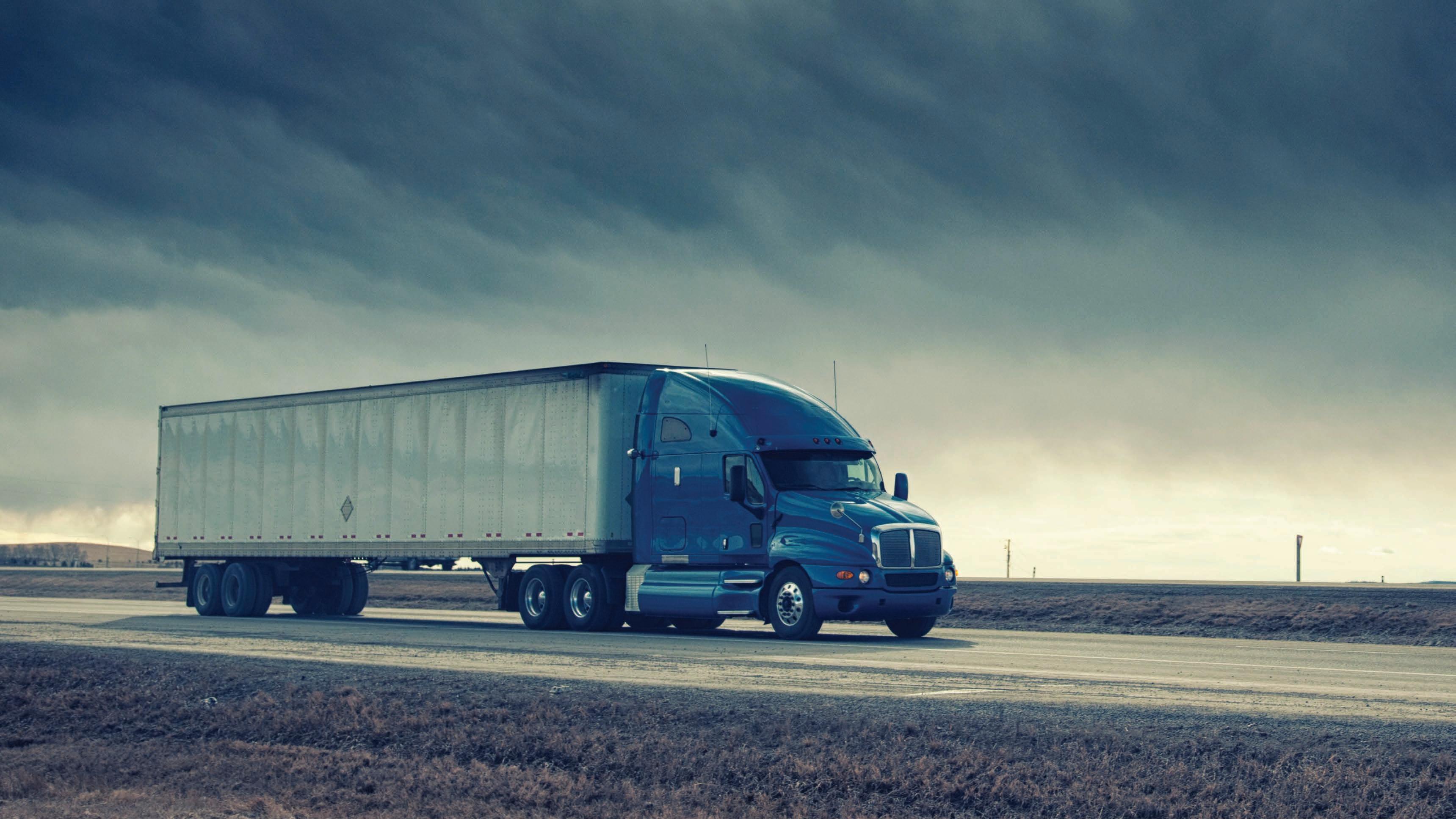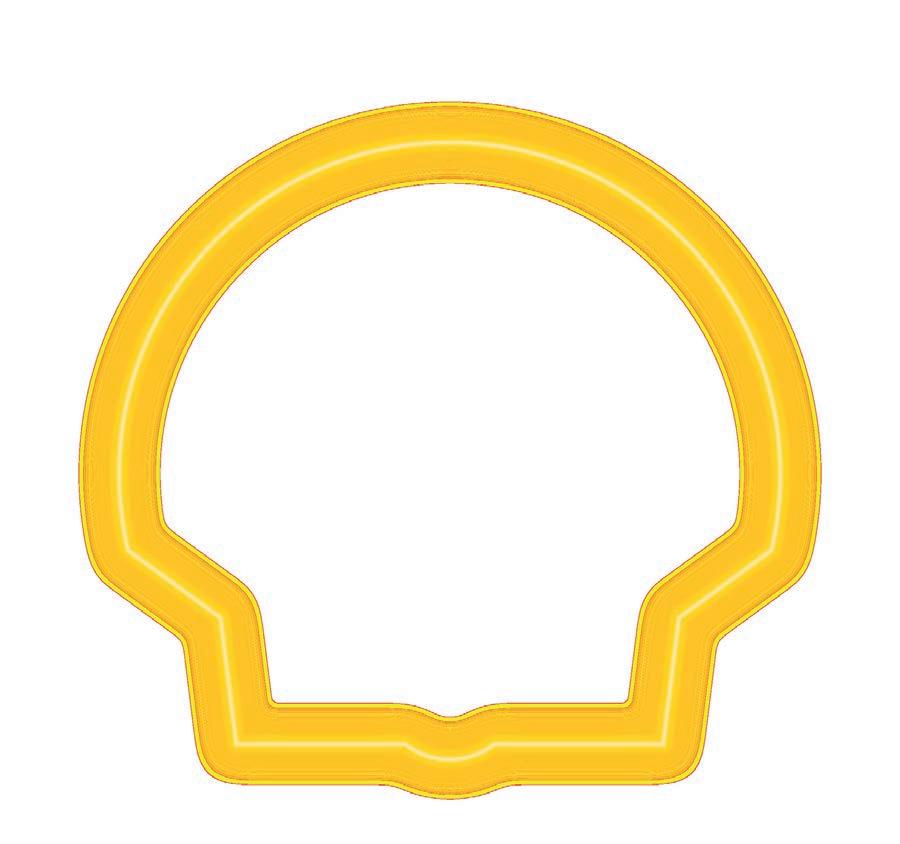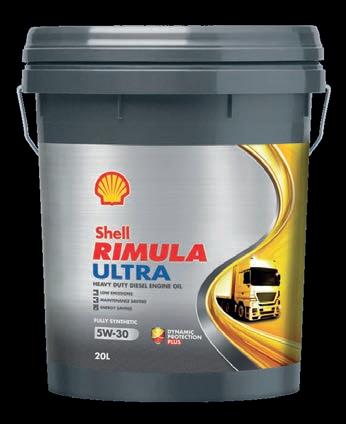

Carrier: Rogers Transport
Forrestry: Elliott’s Bulk Haulage
Feature: Wörth Production Facility
Test Drive: DAF XG















































































































































































































Carrier: Rogers Transport
Forrestry: Elliott’s Bulk Haulage
Feature: Wörth Production Facility
Test Drive: DAF XG












































































































































































































Australia’s leading truck magazine, Prime Mover, continues to invest more in its products and showcases a deep pool of editorial talent with a unique mix of experience and knowledge.
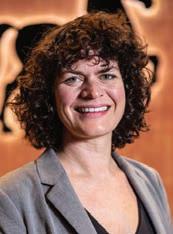





Christine Clancy | COO
With more than two decades of experience as a media professional, Christine has worked in newsrooms across Canada, Vietnam and Australia. She joined the Prime Creative Media team 12 years ago, and today oversees more than 43 titles, including a dozen print and digital transportation titles. She continues to lead a team that focuses on continuous improvement to deliver quality insights that helps the commercial road transport industry grow.
William Craske | Editor
Over the past two decades William has published widely on transport, logistics, politics, agriculture, cinema, music and sports. He has held senior positions in marketing and publicity for multinational businesses in the entertainment industry and is the author of two plays and a book on Australian lm history. Like many based in Melbourne he is in a prolonged transition of either returning or leaving.
Peter Shields | Senior Feature Writer
A seasoned transport industry professional, Peter has spent more than a decade in the media industry. Starting out as a heavy vehicle mechanic, he managed a fuel tanker eet and held a range of senior marketing and management positions in the oil and chemicals industry before becoming a nationally acclaimed transport journalist.
Peter White | Journalist
Since completing a Bachelor of Media and Communication degree at La Trobe University in 2021, Peter has obtained valuable newsroom experience, supplemented by direct industry exposure at Prime Creative Media. As the Editor of Trailer, Peter brings a fresh perspective to Prime Mover. He has a strong interest in commercial road transport and in furthering the magazine’s goal of growing the industry.
Sean Gustini | Journalist
Having completed a Bachelor of Arts majoring in Media and Communications at the University of Melbourne in 2024, Sean looks forward to bringing his passion for writing and journalism to the road freight and transport industries. He previously lived in the Philippines, Vietnam, Indonesia and Malaysia. In his downtime he enjoys playing the guitar and running.
Ashley Blachford | Business Development Manager
Handling placements for Prime Mover magazine, Ashley has a unique perspective on the world of truck building both domestically and internationally. Focused on delivering the best results for advertisers, Ashley works closely with the editorial team to ensure the best integration of brand messaging across both print and digital platforms.
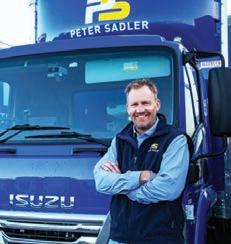
CEO John Murphy john.murphy@primecreative.com.au
Editor William Craske william.craske@primecreative.com.au
Managing Editor, Luke Applebee Transport Group luke.applebee@primecreative.com.au
Senior Feature Peter Shields Writer peter.shields@primecreative.com.au
Business Ashley Blachford Development ashley.blachford@primecreative.com.au Manager 0425 699 819
Art Director Blake Storey blake.storey@primecreative.com.au
Design Blake Storey
Contributors Sean Gustini sean.gustini@primecreative.com.au
Peter White peter.white@primecreative.com.au
Client Success Salma Kennedy Manager salma.kennedy@primecreative.com.au
Head Of ce 379 Docklands Drive, Docklands VIC 3008 enquiries@primecreative.com.au
Subscriptions
03 9690 8766 subscriptions@primecreative.com.au
Prime Mover magazine is available by subscription from the publisher. The right of refusal is reserved by the publisher. Annual rates: AUS $110.00 (inc GST). For overseas subscriptions, airmail postage should be added to the subscription rate.
Articles
All articles submitted for publication become the property of the publisher. The Editor reserves the right to adjust any article to conform with the magazine format.
Copyright PRIME MOVER magazine is owned and published by Prime Creative Media. All material in PRIME MOVER magazine is copyright and no part may be reproduced or copied in any form or by any means (graphic, electronic or mechanical including information and retrieval systems) without written permission of the publisher. The Editor welcomes contributions but reserves the right to accept or reject any material.
While every effort has been made to ensure the accuracy of information Prime Creative Media will not accept responsibility for errors or omissions or for any consequences arising from reliance on information published. The opinions expressed in PRIME MOVER magazine are not necessarily the opinions of, or endorsed by the publisher unless otherwise stated.
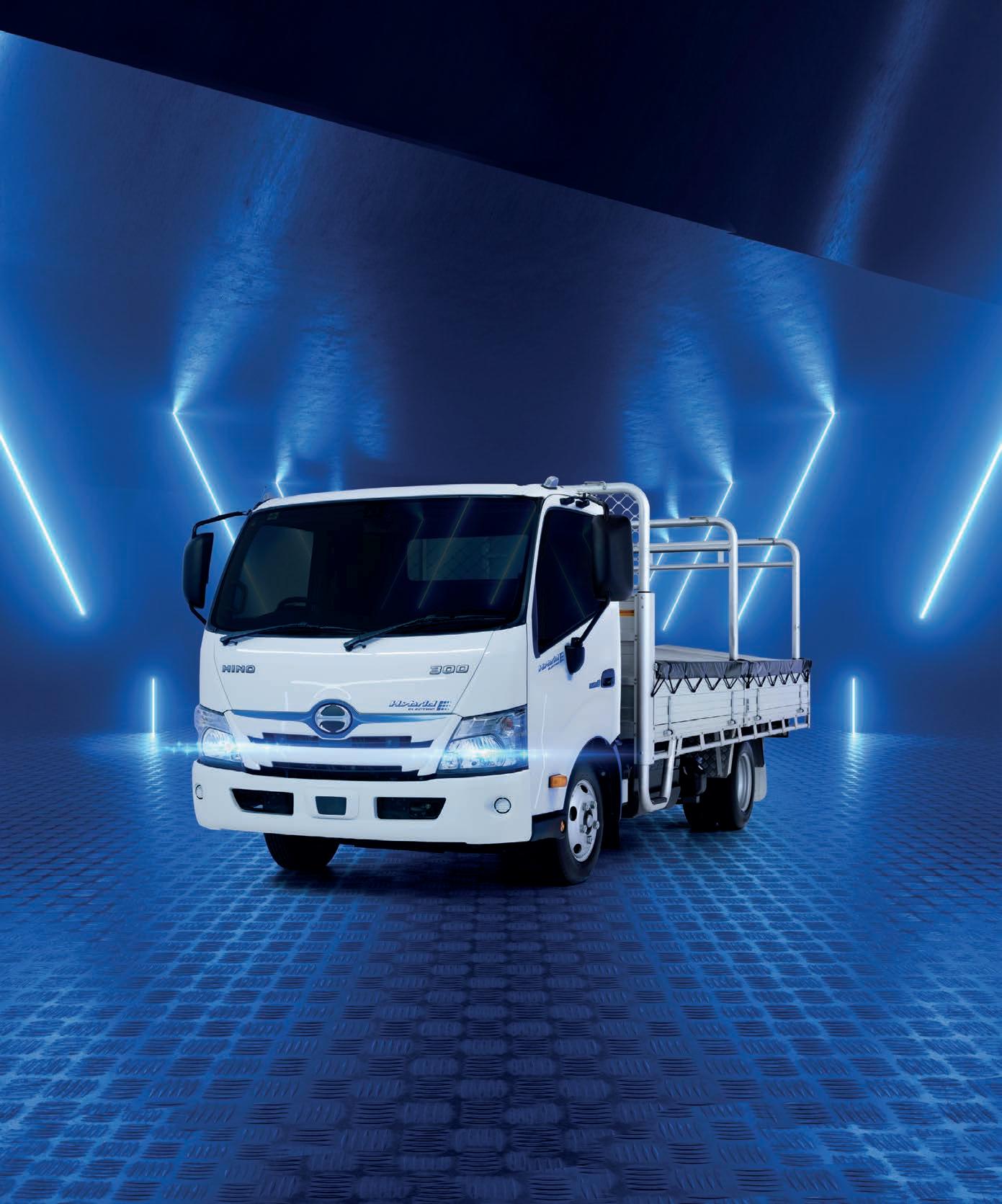
Make real savings from your fuel and maintenance costs, reduce your operating costs and more. With superior technology at work, the Hino Hybrid Electric will deliver up to 20%* reduction in both fuel use and emissions, compared to a traditional diesel


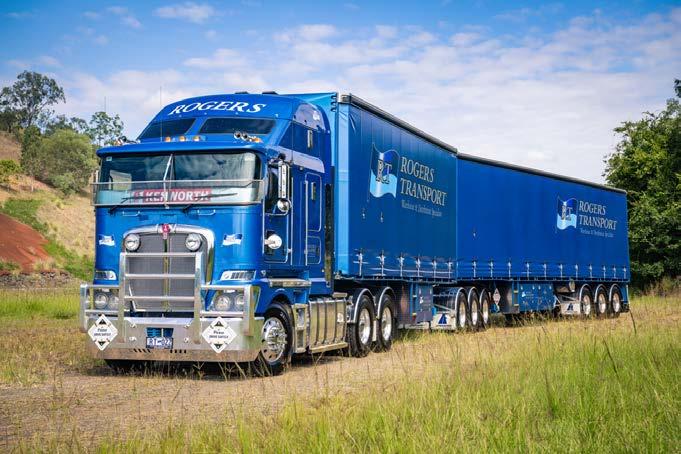
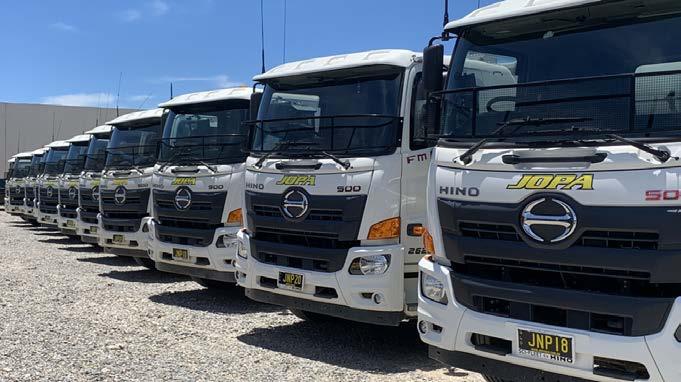
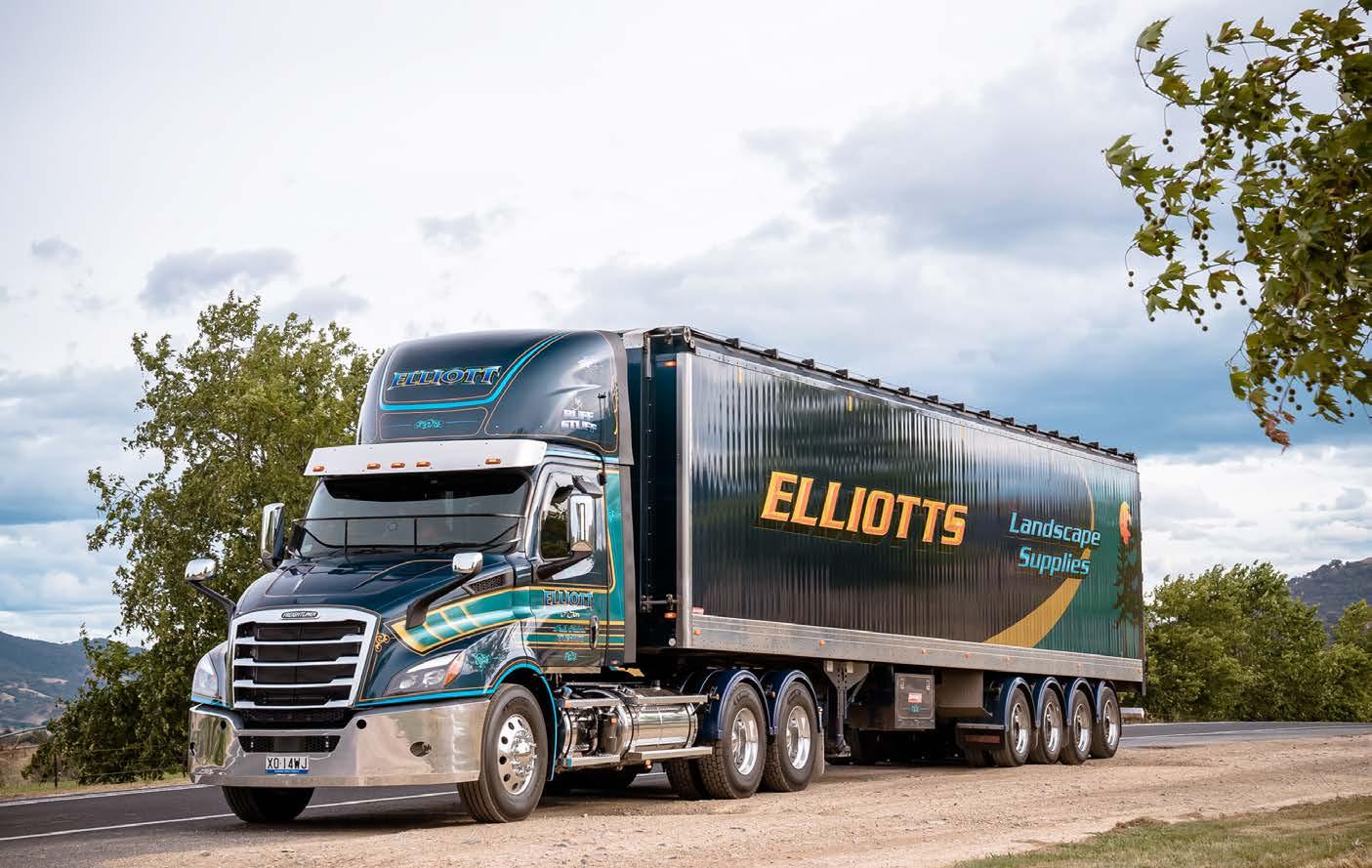
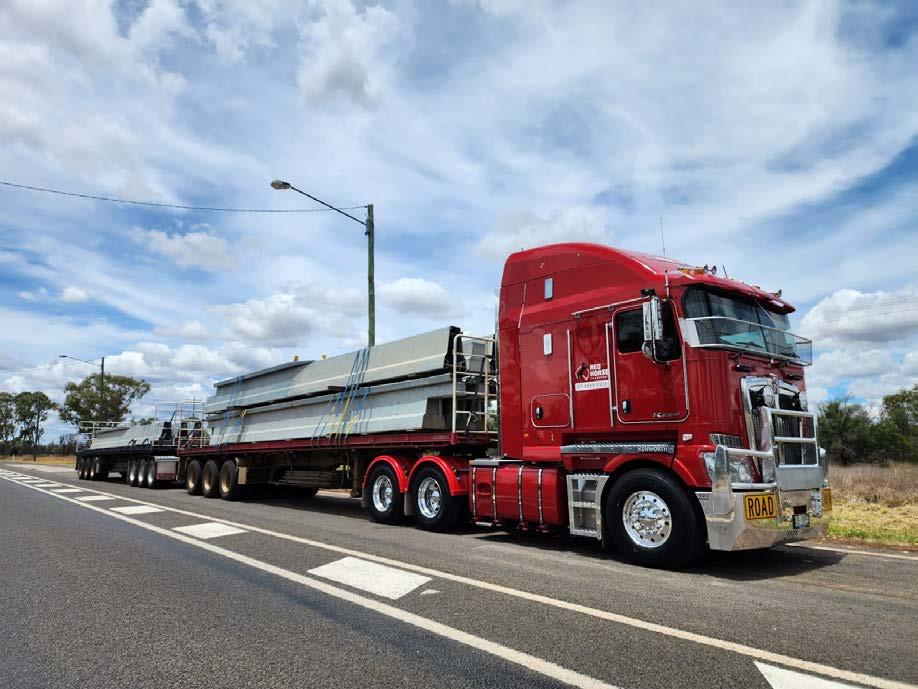
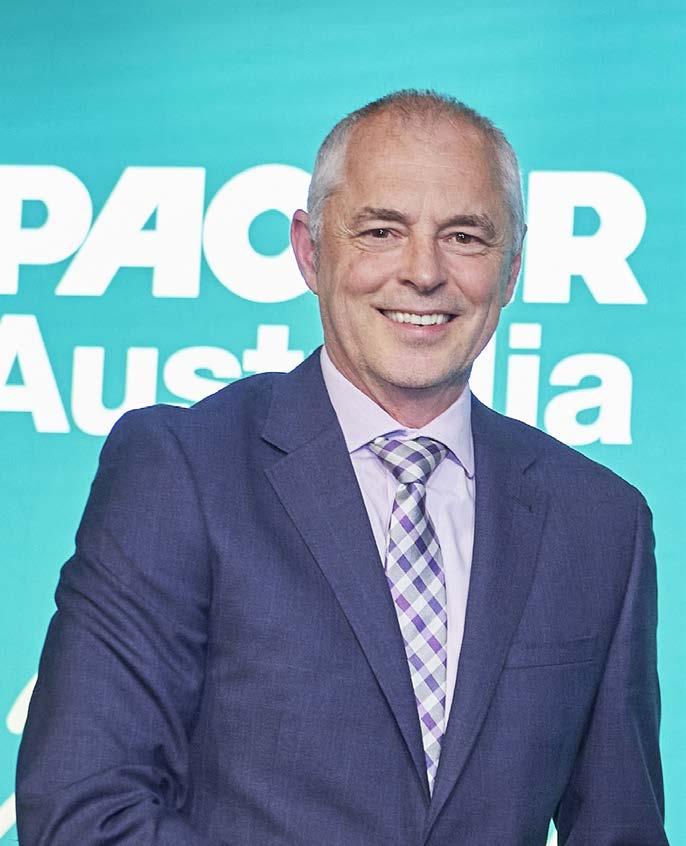

“When I was Head of Revenue I would say to the customers ‘you’re not as important as my drivers and they would say, ‘what the hell does that mean?’ and I would say, ‘well, if I didn’t have good drivers, you wouldn’t be a customer, so they have to come before you.’”




24 Moving with the Times
An entrepreneurial family vision set in motion Peter Sadler Removals & Logistics, a respected business that has risen above its niche origins to become a serious player across three industry segments.
30 Out of the Blue
Rogers Transport is a family chronicle animated by the spirit of adventure, old-fashioned entrepreneurial nous and the gifts of good timing.
34 Moving Mountains
Efficiency is a major factor in the Elliott’s Bulk Haulage operation which is based in the town of Tumut in the foothills of the NSW Snowy Mountains.
TRUCK & TECH
42 Work Horse
A new tribute truck honouring the former General Manager at Red Horse Transport reveals a story of integrity, commitment and selfless leadership.
58 No Country for Old Fleets
The latest instalment of the annual
Commercial Fleet Guide expands the categories to help provide a better overview of the movers and shakers in road transport in Australia.
66 Silent Partner
DAF’s entry into the Australian 15-litre cabover market delivers a no-compromise viable consideration for linehaul operators.
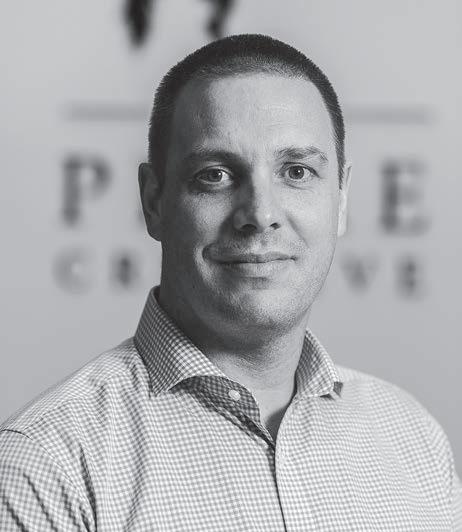
William Craske Editor
Supply chains are critical. This is not up for debate. Through famines, pandemics, civil unrest, natural disaster and war, supply chains are the unifying factor that can accommodate relief if not resolution, whether whole or in part. No military power can succeed without them. In transport and logistics there’s a common adage: “No day is the same.” Changeability is the precondition of entry. Outsourced production, a commonplace practice of international corporations to cut costs, boost quarterly pro ts, and enhance scalability, has helped increasingly centralise global networks which have been netuned to adapt to the endless cycles of this supremely indeterminate state. The socio-economic outcomes have been both profound and also dubious. Austerity measures implemented in the wake of the Global Financial Crisis have led to no end of perspectives offered on how businesses and communities can at once develop and employ a range of resilience strategies to help creatively navigate the market and exibly adapt to the long-term effects of intense and longstanding crises. In a borderless world, where international trade barriers have
been removed, the new Prometheanism of the counter enlightenment, whereby nature’s terms are rejected contra naturam, don’t quite t.
Some cargo makes this more apparent than others.
There exists between Colombia and Panama an insect border. Vigilant inspectors cover thousands of square miles by motorcycle, boat, and horseback, searching for stray screwworm infections to keep the insect out of North America. Maintenance involves dropping 14.7 million sterilised screwworms over the rainforest every week. To streamline supply a screwworm rearing plant operates 24/7 in Panama. One of Argentina’s chief exports is responsible for a prodigious supply chain expansion unrivalled by anything in shipping. You’ve probably never heard of it even as it grows right under your nose. Invasive colonies of Argentine ants have formed supercolonies across the globe. There is one with a trillion workers that stretches from San Francisco to San Diego. It’s generally understood that the colony formed over a century ago when ants were accidentally transported from Buenos Aires in the 1890s to Louisiana on steamboats and then California, likely by train. Through the use of ports, the Argentine ant has extended its dominance by exploiting sea lanes. The California colony now controls the port cities of San Diego, Los Angeles, Long Beach, Richmond,
Oakland and San Francisco.
In Japan the port of Kobe is in the grips of an ongoing con ict between three supercolonies. Meanwhile a new supercolony in Nara prefecture has reportedly mastered rafting on the river to increase their nest budding and dispersion mechanisms. Somewhere a corporate Goliath is running this all through AI analysis. But as Aristotle warned, “You Ain’t Seen Nothing Yet.” A supercolony associated with southern European dwarfs almost all others. It extends 6,000km with few pockets of resistance. These are embodied by two smaller rival colonies in Corsica and, unsurprisingly, Catalan. The scale of the main colony has led to human intervention, with the aim of playing off the supercolonies against one another. But there’s a twist.
More recently it’s been discovered that the supercolony in California and the main colonies in Japan, Europe, New Zealand, Hawaii and Australia are indeed the same colony. The workers recognise one and other and do not attack. While international trade operates under the aegis there’s no limit to growth the march of the Argentine ant might be a case study in sustainability and portend to things to come.
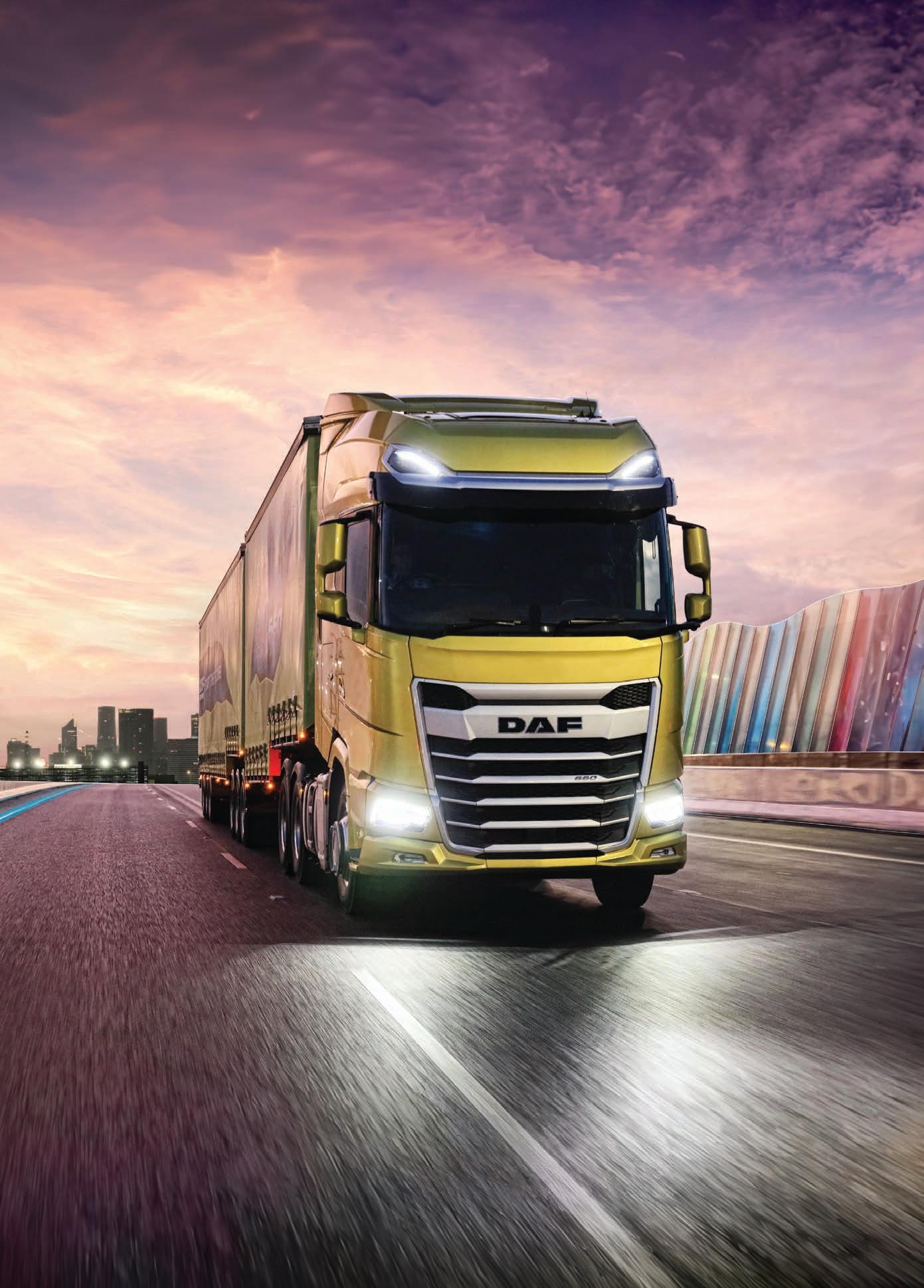


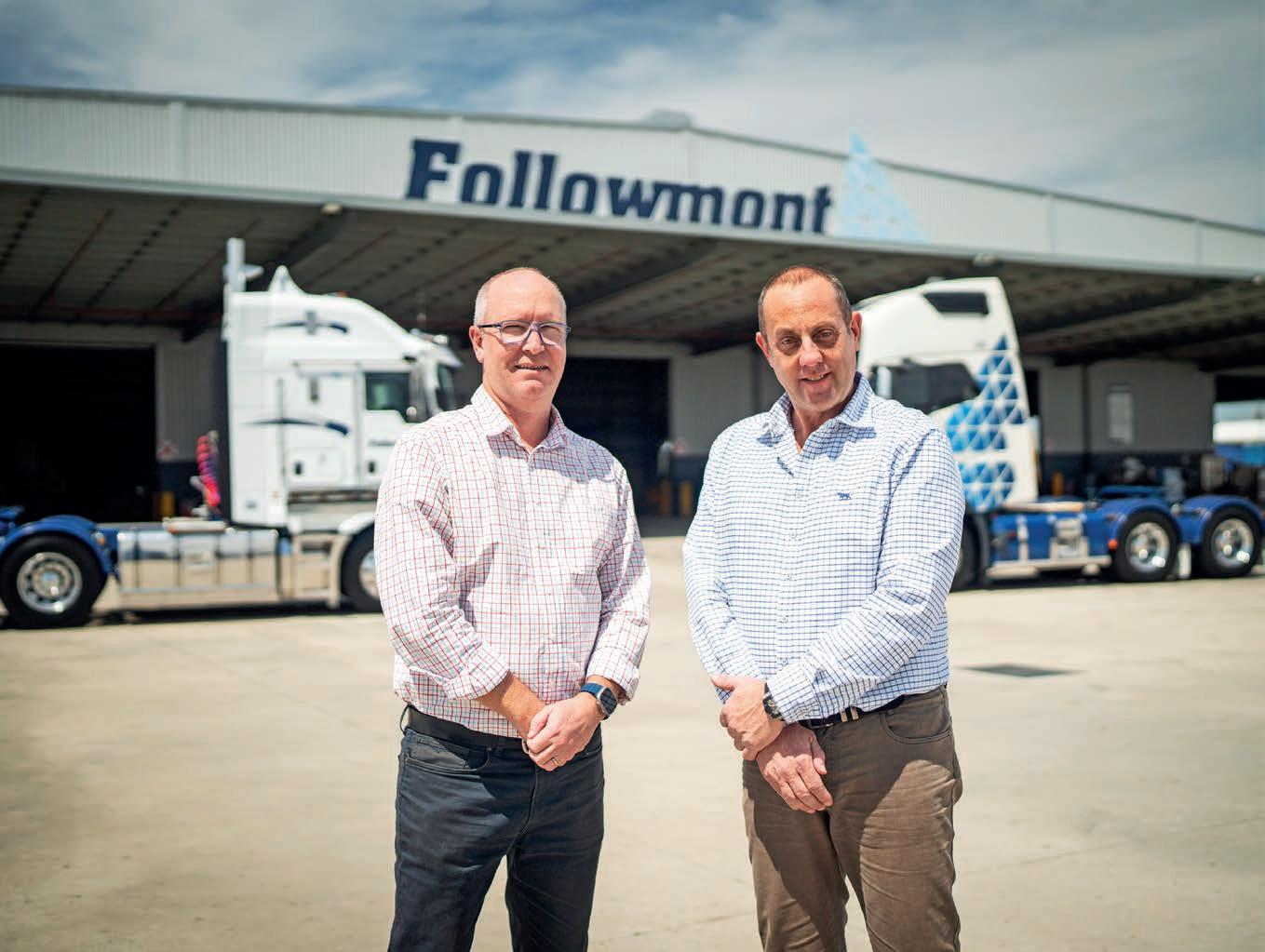
Followmont Transport has made changes to its leadership team. After 12 years of service as Chief Executive Officer and Managing Director, Mark Tobin will transition into the role of Managing Director.
Tobin’s transition will see Chief Operating Officer, Ross Longmire, step up as the new CEO. Longmire has an extensive and successful career in transport and is highly regarded by Tobin as one of the most skilled operational leaders he has encountered.
“Ross is the ideal choice to lead Followmont,” said Tobin. “His steady, thoughtful approach and deep care for our people will ensure we remain a company that values family and quality in everything we do.”
Longmire brings over 25 years’ industry experience, holding primarily operational management positions overseeing transport and logistics
requirements in a number of different states and business units.
As a Board Member of the Queensland Trucking Association, and previous representative for other industry councils, he is deeply committed to the success of the industry.
Longmire is passionate about driving smarter, safer operations and fostering growth alongside customers, and this includes making the transport sector a more attractive place to work with strong career opportunities.
For Longmire, the family-oriented culture at Followmont is what sets the business apart from its competitors.
“From the moment I walked through the doors, I knew this was an incredible workplace,” he said. “The sense of community and genuine care here is unmatched, and I am committed to preserving and strengthening that as CEO.”
The change in leadership marks a
pivotal moment in Followmont’s history.
“Our customers and team members remain at the heart of everything we do, and I look forward to steering Followmont as we continue to go from strength to strength,” said Tobin.
Under Tobin’s leadership, Followmont has expanded its fleet, network footprint, while building strong customer relationships, and embracing innovation. Tobin has guided the company through significant growth and key milestones, including investments in sustainability, training and development, and safety initiatives.
“Every decision I’ve made as CEO has been driven by my passion for our people and their growth,” said Tobin.
“Our strength has always been in our team, and I am committed to nurturing that as we move forward together.”
In his role as Managing Director, Tobin will continue to focus on driving Followmont’s strategic evolution.
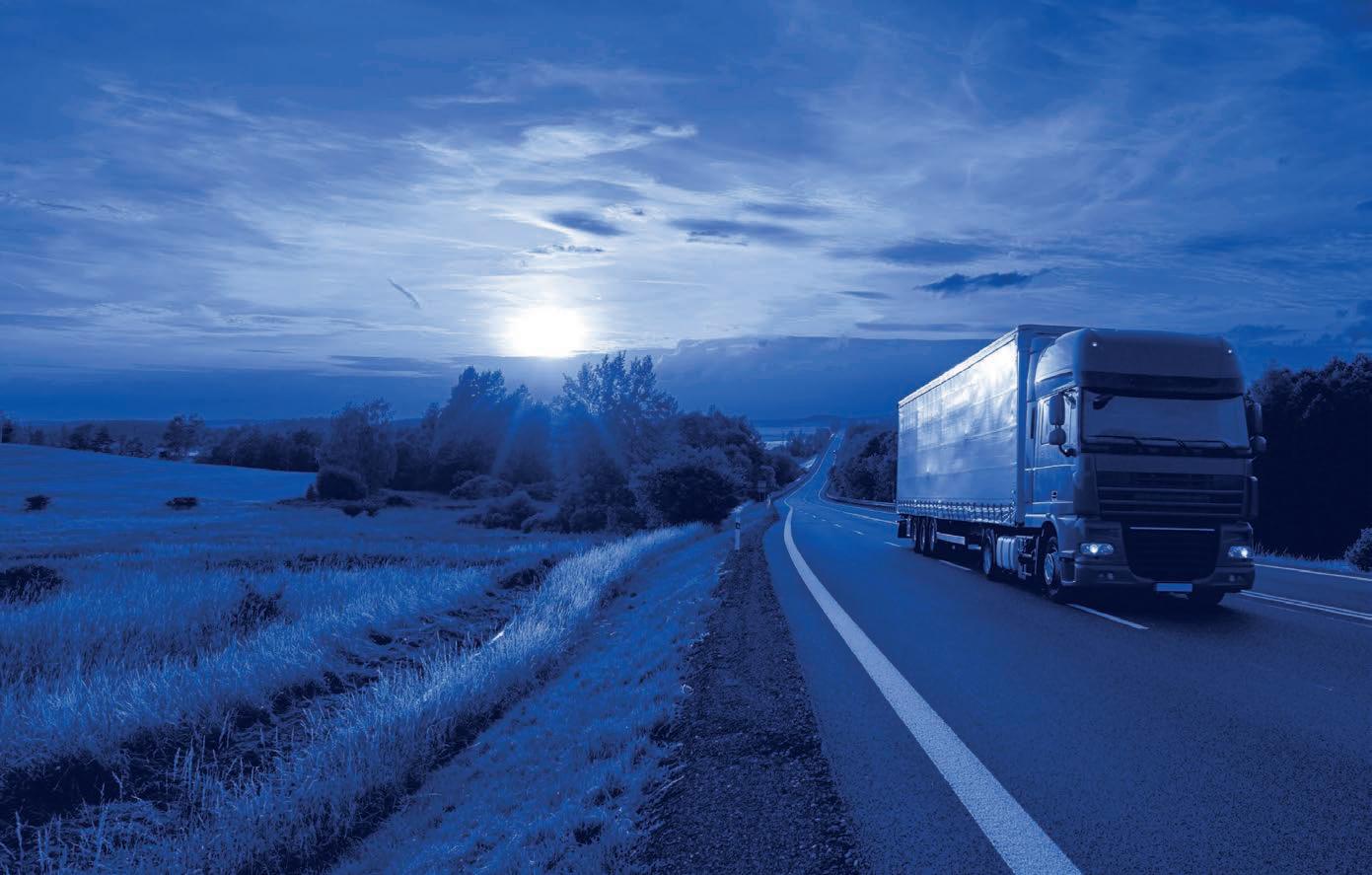

Almost 200 people gathered to celebrate the opening of Blue Water Shipping’s new Queensland depot and distribution hub at a 5.178ha site on Fisherman Islands. The new facility has enabled the international transport and logistics provider to consolidate its port operations into one location, having occupied casual lease sites at the Port for just over two years.
The facility was delivered by PBPL with Principal Contractor, FKG. It was designed by Sparc Architects and project managed by Johnstaff.
Blue Water Shipping’s new landside transport and logistics depot comprises a 15,000m² warehouse plus a 500m² administrative building, car parking and over 30,000m² of hardstand together with a washbay and bond store.
Port of Brisbane Pty Ltd (PBPL) Chief Commercial Officer, David Keir, congratulated all involved.
“We’re very pleased to have designed
and delivered this high quality, purposebuilt facility for Blue Water Shipping in less than 12 months, providing them with a permanent home from which to operate and grow,” said Keir. “Our project teams worked hand-in-glove with Blue Water Shipping throughout the design stage, really testing their user requirements to design the most flexible depot for them and deliver the best possible outcome.”
Blue Water Shipping’s Regional Manager Operations for Oceania, Justin Bound was on hand to take possession of the purpose-built facility.
“This facility will play a huge part to our local success and will enable further growth across our targeted verticals: Mining, Renewables, Infrastructure, and Conventional Energy.
“The entire process, from design to construction, has been seamless, thanks to PBPL, Johnstaff, and FKG’s collaborative approach.”
As is standard in all new PBPL property
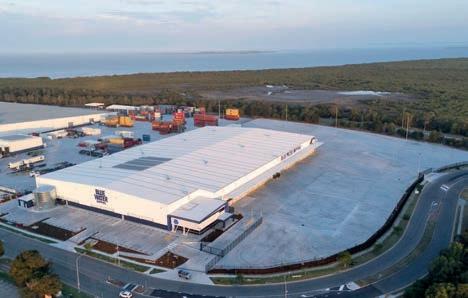
developments, the Blue Water Shipping depot and distribution hub was delivered to a 5-star equivalent sustainability rating. It incorporated sustainable design elements including a 99kW rooftop solar system, Enviroconcepts water treatment system, low carbon concrete in the car park and warehouse dado panels, and a highly efficient steel frame design that reduced overall steel tonnage. Construction commenced in January 2024 and was completed in November 2024.
As Australia’s largest vehicle aftermarket parts provider, we’ve built our heritage on


Late last year Viva Energy began to take delivery of key elements for its new ultra-low sulphur gasoline (ULSG) plant as Geelong Refinery began its biggest upgrade in decades. A $350 million investment in Australian manufacturing, including a $125 million contribution from the Australian Government, will allow the refinery to produce the cleanest petrol ever made in Australia said the energy company.
In a media release it issued, Viva Energy said these sulphur reductions in petrol more closely aligned Australia’s fuel
quality with international standards, allowing for more fuel-efficient vehicles to come here, and providing Australians with health, environmental and economic benefits.
The units delivered are up to 28 metres tall, with the largest weighing nearly 900 tonnes. They were delivered by ship and arrived at Lascelles Wharf. Over several days, the units were transported by barge from Lascelles Wharf to a landing ramp next to Refinery Jetty before being transported by SPMT (Self-Propelled Modular Transport)
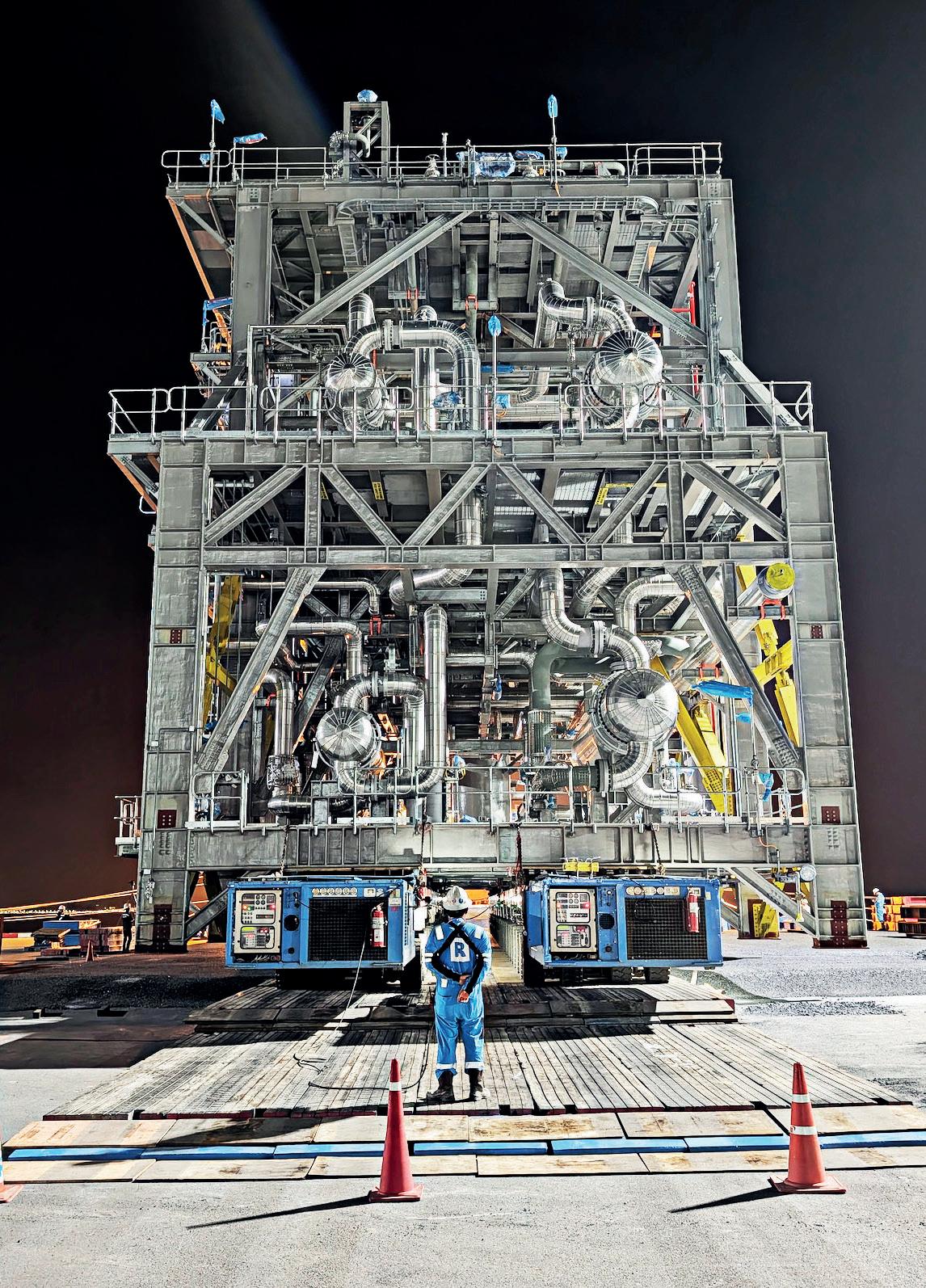
units to their final location near the refinery flare.
The largest unit, a 900-tonne production module, was delivered in the first week of December.
Completion of the ULSG plant is planned for the second half of 2025, in time to meet the new petrol standards that take effect from 15 December.
This refinery upgrade is part of a pipeline of significant projects that Viva Energy is delivering in Geelong.
In October, Viva Energy commissioned three 30 million-litre diesel storage tanks to help deliver fuel security in Australia. Early this year it will commission a renewable hydrogen refuelling station as part of the Viva Energy Hub.
Viva Energy is also investigating processing alternative feedstocks in the refinery such as used cooking oil, canola and tallow, which could see it producing lower carbon fuels in support of the government’s Future Made in Australia program. The refinery’s critical infrastructure could also provide a circular pathway to recycle waste soft plastics which could be processed through the refinery and adjacent polypropylene plant.
These projects all form part of the Viva Energy Hub, which the company is confident will play an important role in delivering cleaner fuels, supporting the nation’s fuel security, participating in the circular economy and preserving Australia’s sovereign manufacturing capability.
The ULSG plant will produce the cleanest petrol ever manufactured in Australia, with sulphur content of less than ten parts per million claimed Viva Energy. The $350m project is part of the Fuel Security Package. Viva Energy noted that $200 million of the entire budget is going into Australian procurement and construction contracts, with the majority of that going to businesses in the Geelong region.
Up to 300 people will be employed during the peak of construction activity.

FREIGHTLINER IS SERIOUS ABOUT SAFETY.
Every Cascadia comes with a complete suite of fully integrated active safety features and connected technology that helps you get on with your work.
With Active Brake Assist, which can even detect moving pedestrians, Side Guard Assist, a driver airbag, and forward-facing camera footage that can be sent on-the-go for immediate incident reports, the Cascadia sets a new standard for practical safety.



Singapore Post Limited has entered into a sale and purchase agreement with Pacific Equity Partners (PEP) for the sale of its Australian business, Freight Management Holdings Pty Ltd (FMH). The Melbourne-based private equity firm, PEP, welcomed one of the country’s largest vehicle fleets, which includes Border Express and CouriersPlease, to its expanding portfolio. The bid is reportedly valued at $1.02 billion.
“We are thrilled to welcome FMH Group to our portfolio. FMH Group has a stellar track record of growth, a passionate team and a clear and compelling trajectory,” said Pacific Equity Partners Managing Director, David Brown. “We look forward to supporting them to build on their success and facilitate further opportunities.”
The news comes less than 12 months after FMH Group acquired Border Express. Last December PEP acquired a majority stake in Australian electric vehicle charging solutions provider EVSE for $250 million. The company provides DC fast charging
solutions for larger commercial vehicles and fleets, with the commercial offerings including end-to-end solutions that bundle hardware, software and installation services.
In a statement released by Border Express it was called a new chapter for the business.
“This new partnership reflects the strength of the Group and its businesses, including ours, and sets the stage for continued growth and success,” the company said. “We’re optimistic about the potential to further build on our strong foundation and deliver even greater value to our customers and employees.”
Simon Slagter, CEO of FMH Group said it was an exciting milestone for FMH Group.
“We have built a foundation of trust with our customers, achieved significant growth, and led the way in providing excellent logistics services,” he said.
“The investment of Pacific Equity Partners will help us take the next leap forward, empowering us to further enhance our technology platform,
turbocharge our business development function and pursue strategic acquisition opportunities, strengthening our position as industry leader and unlocking even greater value for our customers.”
The proposed divestment is subject to regulatory approvals such as approvals from the Foreign Investment Review Board of Australia, and SingPost obtaining the requisite approval from shareholders in an extraordinary general meeting of SingPost to be convened.
“Since our initial investment in FMH Group in 2020, we have witnessed the group achieve extraordinary growth,” said Singapore Post Chairman, Simon Israel. “Now, with its strong market position and growth pathway the Board has decided it is time to realise the substantial shareholder value created. The transition of FMH Group ownership to PEP will support its continued upward trajectory.”
Mark Luff, son of founder Max Luff and the last family member to depart Border Express after 36 years, finished up last November.
Freight specialist Sadleirs has taken delivery of four new Euro 6-compliant MAN TGS 26.510s. Each vehicle
Thomas McAulay, Sadleirs National Assets and Facilities Manager.


is equipped with advanced safety features, enhanced fuel efficiency, and a comfortable, reinforced cab.
Features such as active roll stabilisation, lane change assistance, and emergency braking were key factors in the decision.
Providing multimodal solutions across rail, road, sea and air, Sadleirs, which was founded in 1829, remains a privately owned family business today. Described as a perfect fit for Sadleirs, the MAN TGS prime movers were delivered by Chris Thompson and the team from Penske Australia’s Perth dealership. The new vehicles are expected to enhance Sadleirs’ national network and have been warmly received at depots in Perth, Adelaide, Melbourne, and Brisbane.
“The MAN trucks are very modern
trucks that have the driver’s needs and safety at the forefront,” said Thomas McAulay, National Assets and Facilities Manager. “The performance and reliability of the equipment have exceeded our expectations, and we couldn’t be happier with the overall quality.
“The trucks have seamlessly integrated into our fleet, delivering the efficiency and durability we require to maintain smooth operations.”
McAulay added that it had been a pleasure working with Penske.
“We couldn’t hope for a better result. Chris from Penske provided exceptional support throughout the whole process,” he said. “His professionalism and dedication have made the experience remarkably easy, ensuring that all our needs were promptly addressed.”










Cold chain specialist, SLR Trans, has taken delivery of five new Volvo FH16 prime movers. The Euro 5 trucks are rated to 600hp and will be deployed initially as B-doubles in refrigerated transport with the option for being upgraded for roadtrain activity. These latest trucks, which are expected to cover 1,000 kilometres daily interstate, bring the Volvos in the SLR Trans fleet to 24 units.
Volvo’s reputation for heavy vehicle safety and integrating advanced technologies with their vehicles fits with SLR’s commitment to safety. The company opted for preventive safety features like collision warning with emergency brake as it uses radar and cameras to detect vehicles or obstacles in the truck’s path, warning the driver and applying brakes automatically if necessary.
The Volvo FH16s also feature lane keeping support, driver alert support, adaptive cruise control and electronic stability control.
Intelligent technologies such as Volvo Dynamic Steering (VDS) aims
to reduce driver strain by providing precise steering with minimal effort, enhancing safety and reducing fatigue.
Earlier this year, SLR Trans opened a new state-of-the-art facility in Archerfield and celebrated its tenth anniversary.
The 5,600m² cold store and freezer distribution centre provides distinct advantages to the expanding refrigerated transport logistics business, namely the capacity to store 8,000-pallet spaces over six areas providing specific temperature and ripening capabilities.
SLR Trans has become a valued customer of Volvo Commercial Vehicles, recently purchasing several trucks to meet their operational needs.
“Their continued business and trust in our products demonstrate the strong relationship we’ve built together,” said Nicholas Singh, VCV Sales Representative. “We deeply appreciate their loyalty and are proud to support them with reliable vehicles
and excellent service.
“They are a great bunch of people at every level, that has been received so well by all of our departments. If I could say what an ideal customer would be, it would be SLR Trans.”
The drivers are big fans of the Volvos, which are deployed mainly from the company’s Brisbane headquarters along the eastern seaboard to Sydney and Melbourne or north to Cairns.
SLR Trans Chief Operating Officer
Aumar Moosa said Volvo Trucks had been a fantastic partner.
“The service levels from Volvo have been, by far, one of the best experiences in this affair and the vehicles are most reliable,” he told Prime Mover. “The overnight servicing is incredibly helpful. Having all our trucks under the Volvo Gold Contract servicing plan has given us peace of mind —it goes beyond just repairs and maintenance.”
Moosa adds, “The Volvo Connect telematics system also provides us with valuable information to optimise efficiencies across our Volvos.”
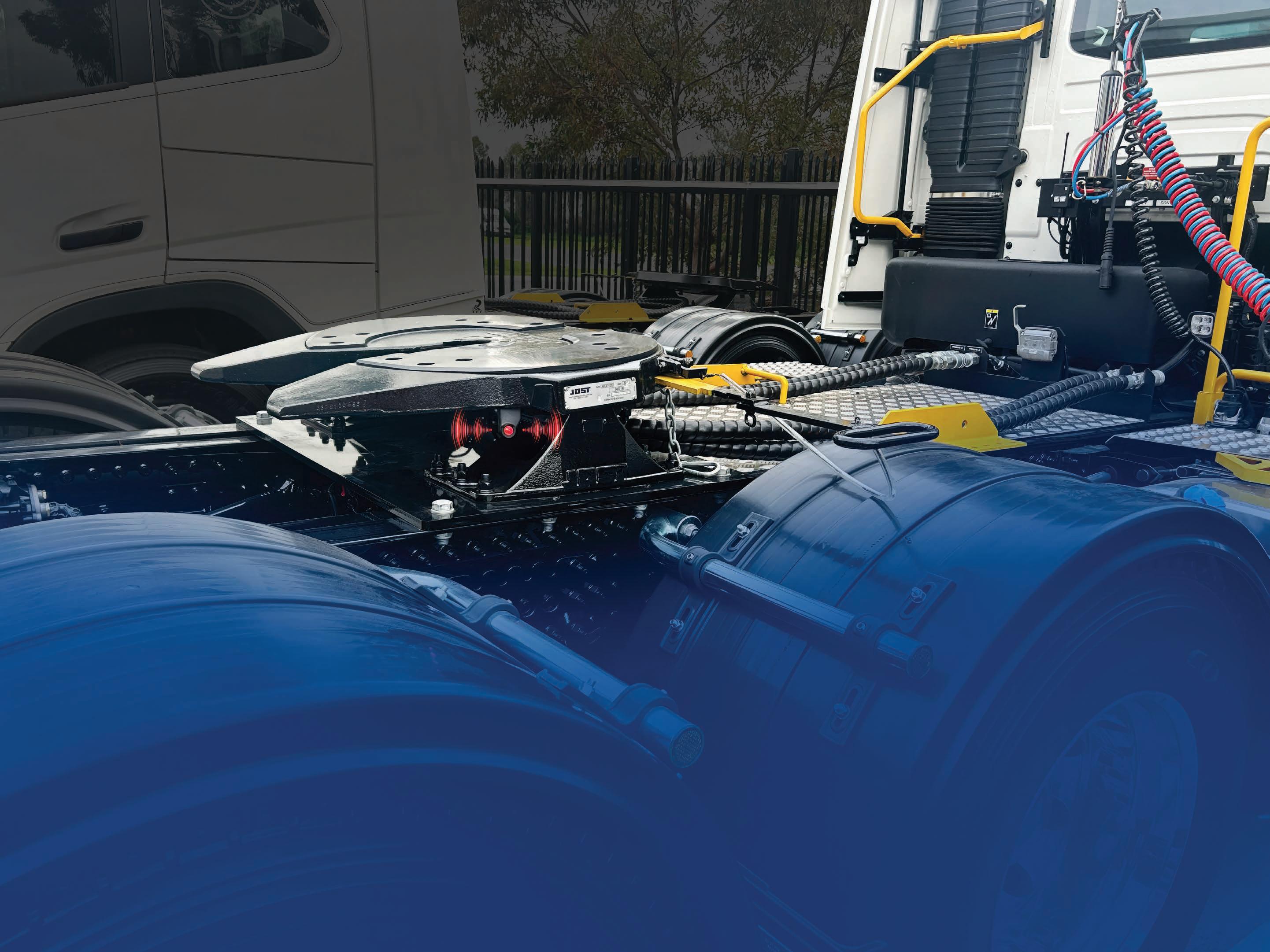



The future of internal combustion truck engines in Australia is renewable fuels according to Volvo Group Australia.
From December 2024, all Volvo and Mack trucks built at the group’s Wacol factory in Queensland will be filled with Hydro Treated Vegetable Oil (HVO) instead of diesel fuel.
Volvo Group Australia said the recent recognition of HVO100 as a fuel on the Australian market had allowed it to speed up its adoption of the renewable fuel as a part of the local manufacturing process.
“While HVO is not strictly a zero emissions fuel, it is a fossil free alternative that reduces well to wheel emissions by up to 90 per cent, which makes a significant step forward in reducing our environmental impact,” said Martin Merrick, President and CEO, Volvo Group Australia. “We will continue to take steps to cut our emissions and meet our decarbonisation targets by
thinking globally whilst acting locally.”
Volvo Trucks first adopted the HVO first fill program at its Tuve, Sweden factory in 2022, however, this Australian announcement represents the first time a multi-branded Volvo Group manufacturing facility has implemented this approach with fossil free fuels.
HVO100 is a renewable and sustainable synthetic fuel made from vetted waste vegetable oils and animal fats.
It has low carbon footprint, zero sulphur, and can be used in Volvo Group engines without any modifications.
HVO100 can be used as a standalone fuel or blended with diesel without impacting service intervals or engine components.
Volvo Group has adopted what it calls “science-based emissions targets”, as a result the group is targeting net zero value chain emissions by 2040 to allow it to meet net-zero targets by 2050. Volvo Group recently signed a
Butler Freight has acquired Coynes Freight Management, a third-generation, family-owned transport company based in Melbourne. Established in 1950 by Neville Coyne and his father, WR (Bob) Coyne, Coynes began as a newspaper delivery business and has grown into an independent transport company specialising in wharf container cartage. The 74-year old Coynes operates a modern fleet of over 70 vehicles— including Super B combinations, B-doubles, and sideloaders. Coynes offers services in container cartage, warehousing, unpacking/ packing, and goods distribution.
The Coynes Freight Management brand will continue to operate under the ownership of Butler Freight, ensuring continuity for its customers.
All members of the Coynes team will remain employed, according to the business management consultancy EP Advisors who said Butler Freight had sought to preserve the “expertise and
dedication that have been hallmarks of the Coynes operation.”
The acquisition marks a new chapter for both Butler Freight and Coynes Freight Management, as it brings together two industry leaders to better serve Australia’s transport and logistics needs.
Butler Freight Services (BFS Extra) is a privately owned Australian company with deep roots in Melbourne’s wharf transport industry.
In February 2017, Butler Freight Services expanded its operations by acquiring Extra Transport, positioning BFS Extra as one of the larger wharf transport operators in Australia.
The company’s operational facilities include a highly efficient West Melbourne wharf facility, located just 300 metres from the wharf, handling over 110,000 TEUs yearly. BFS Extra operates a diverse fleet of approximately 140 prime movers daily, comprising Super B-doubles, B-doubles, sideloaders, retractable skels, Tautliners, and other trailer combinations.
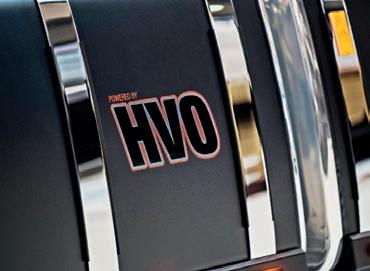
12-month agreement with Ampol to supply HVO100 to its fleet of trucks built at the Wacol QLD factory.
“Incorporating HVO100 into our manufacturing process is just one part of our multi-pronged approach to decarbonisation,” said Merrick.
“We’ve been very clear that the future of fossil free transport here in Australia will still utilise the internal combustion engine, however the fuel that the engine consumes will no doubt continue to evolve as we move to a fossil free future.”
BFS Extra utilises its proprietary wharf management IT solution, which offers web-based booking and scheduling, EDI capabilities, online visibility of scanned PODs, and extensive automated reporting.
EP Advisors issued a statement in which it said it had been honoured to act as sell-side advisors to facilitate the sale of Coynes Freight Management.
“As the family prepared for retirement, they entrusted EP Advisors with a clear mandate: to secure a strategic industry buyer who would uphold the legacy of the business,” the company said.
“The selection of Butler Freight as the acquirer ensures that the Coynes brand, team, and values will remain intact while benefiting from the resources and vision needed to drive future growth. We congratulate both the Coynes family and Butler Freight on this exceptional partnership and are proud to have played a role in this significant transition.”
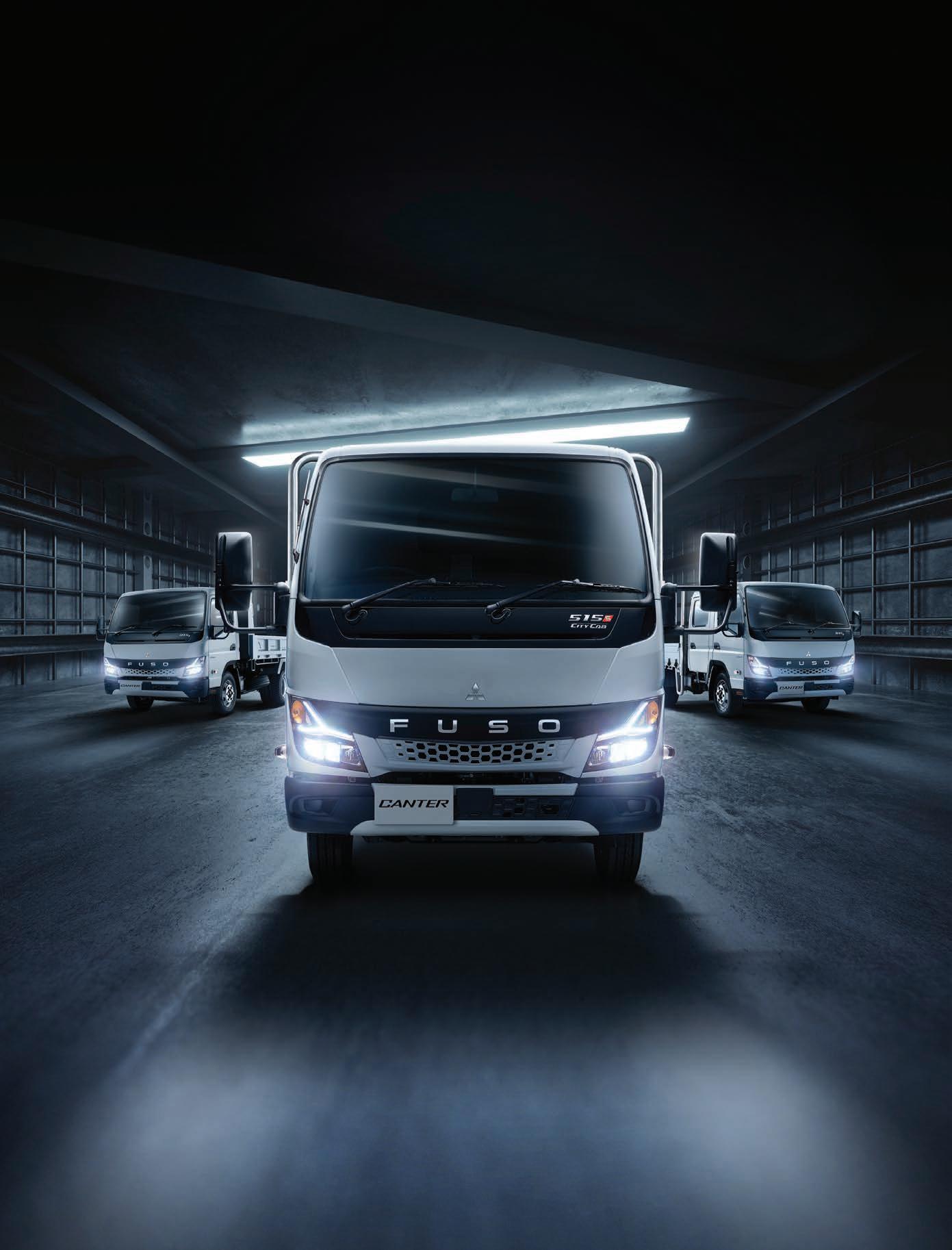
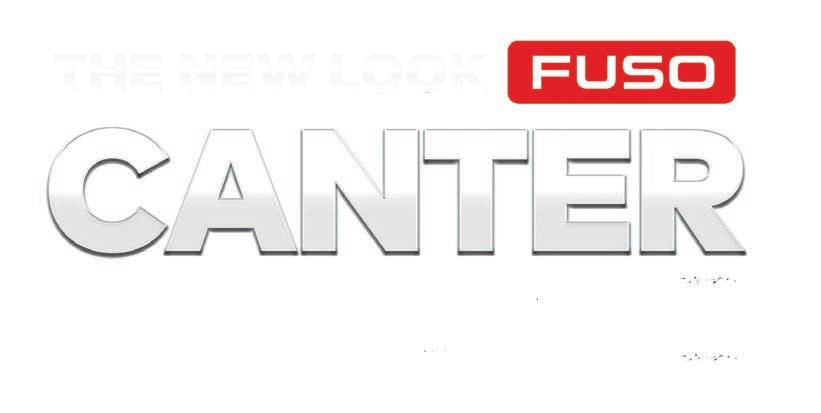

It’s the same trusty workhorse, but not as you know it. Pairing a fresh new design with the features that have made it Australia’s hardest-working light-duty truck. The new look Fuso Canter is now bringing even more to the job site – including brighter LED headlights, a sleek new exterior, and enhanced 8” multimedia touch screen with wireless mobile connectivity. Plus, class-leading payload across most models, active safety systems*, and impressive 30,000km service intervals to take your business further.
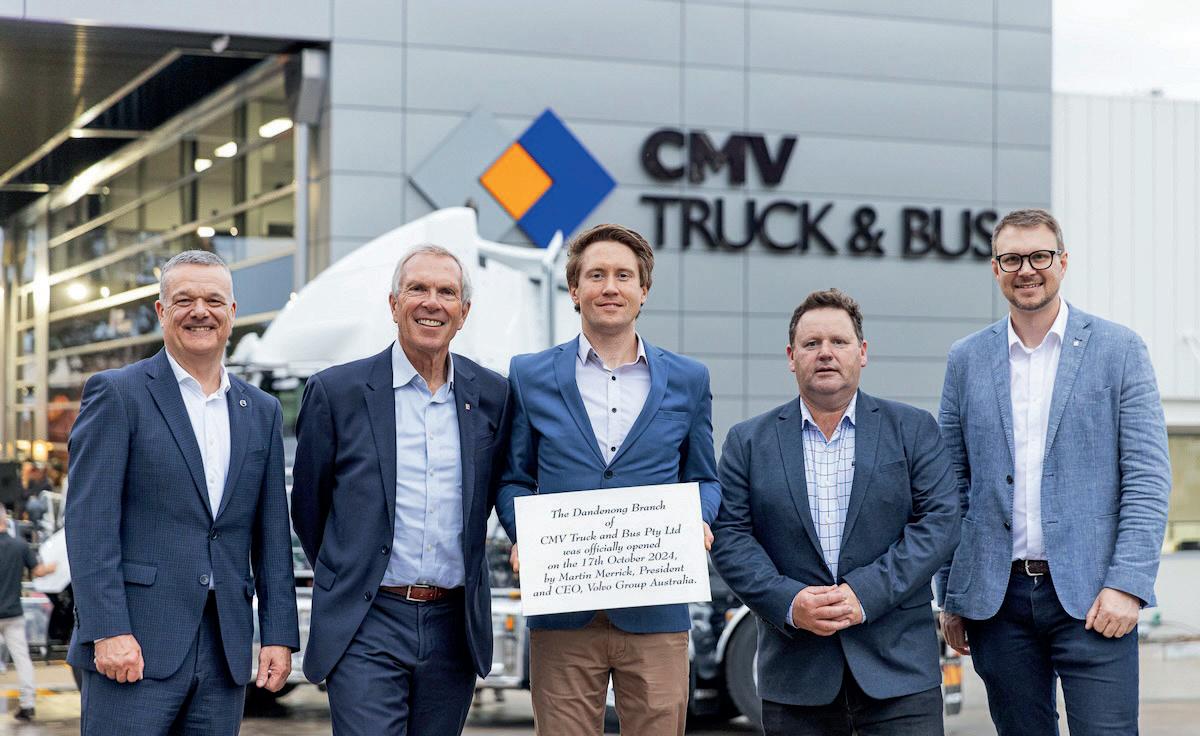
CMV Truck & Bus has unveiled its redeveloped Dandenong dealership, a facility designed with the future in mind. This state-of-the-art transformation goes beyond meeting current customer and staff needs, and has been built to create enhanced efficiencies, safer working environments and an unparalleled customer experience.
Positioned in a prime industrial location at 77-79 Princes Highway, Dandenong South, the dealership has proudly served Eastern Melbourne since 2006. Specialising in the sales of Mack and UD Trucks, with parts and service of Mack, Volvo and UD trucks, CMV Truck & Bus Dandenong has become a trusted transport partner in the area.
The redevelopment of CMV Truck & Bus Dandenong was completed following more than 18 months of intensive construction.
Strategic planning helped keep the dealership operational throughout the process, ensuring uninterrupted service for customers. A key priority for the business was to create a future-ready facility designed to support business growth and keep up with demand in the region.
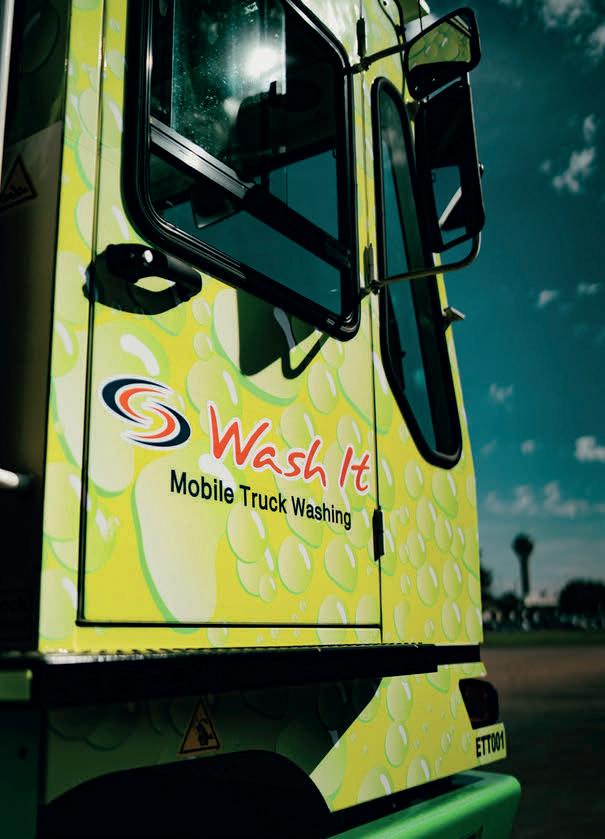
“This transformation reiterates CMV Truck & Bus’ dedication to investing in its facilities and delivering industryleading solutions to our growing customer base. Additionally, the expansion includes modern and increased office space to support this continued growth,” said CMV Truck & Bus General Manager Eastern Victoria, Anthony Russell.
With the addition of a new 20,000m² Tech Centre at the rear of the facility, the dealership now has 55 truck bays and generous space for trailers, both inside and under the fullweather canopy.
This assures the long-term viability of CMV Truck & Bus Dandenong to meet the future requirements of customers.
“Our spacious workshops are equipped with the latest diagnostic tools and state-of-the-art equipment, enabling us to reduce turnaround times and enhance efficiency, ensuring drivers can get back on the road quickly to keep their businesses moving,” said Russell.
The refurbishment involved an upgrade and expansion of the parts warehouse, ensuring rapid availability of genuine
components, minimising customer downtime.
This year CMV Truck & Bus Dandenong appointed a new Branch Manager, Adam Steenbuck, a highly respected individual who has been with the business for over 17 years and started his career as an apprentice.
“I am privileged to take the reins of this innovative dealership, which not only provides the highest level of service but puts the safety of our team and customers first. Safety is at the heart of everything we do and is a core business value, and this new facility is a true reflection of that commitment,” said Steenbuck.
Part of the investment has resulted in four 25-tonne inground knuckle lifts, which allow technicians to raise vehicles safely, ensuring they can perform their tasks with ease and precision. Additionally, industry-leading pit covers have been installed, further enhancing pit safety standards for staff during a service.
Another key addition is the separate Dangerous Goods Workshop, providing a designated area for safe servicing and repairs on customers specific vehicles.




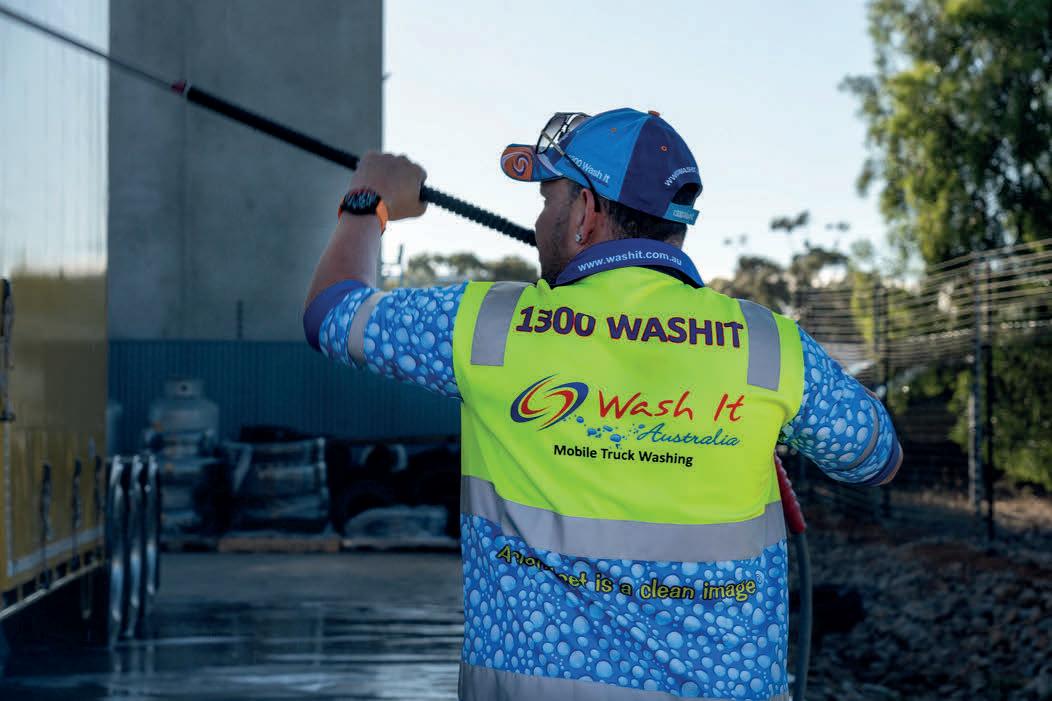

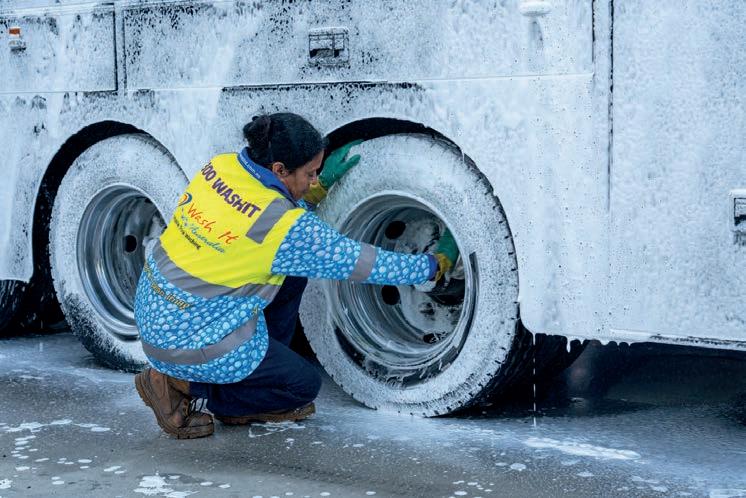
Unlike a standard wash bay, We are able to setup a temporary washbay onsite! This cuts costs and time down considerably by eliminating lengthy trips to offsite washbays. We also utilise a road legal Yard Tug, This allows our team to move trailers around your yard without setting foot on the ground!
With multiple collection methods to suit most situations, We are able to collect and remove all truck wash water from the premise to be disposed of safely. All of this is done at no additional cost!
As Australia’s leading mobile washing supplier, We are in position to service fleets sizes from 15 to 15,000! Wash It Australia is proudly the preffered supplier for Australia’s largest transport company & Australia’s largest supply chain solutions


Dana Incorporated has announced the appointment of R Bruce McDonald, a member of the Dana Board of Directors, as Chairman and Chief Executive Officer, effective immediately.
McDonald’s appointment follows the retirement of James Kamsickas as Chief Executive Officer and his departure from the Board.
Kamsickas will remain as an advisor to the company through March 2025 to support the transition. The Board has retained a leading executive search firm to identify Dana’s next permanent CEO.
“Jim is an exceptional leader with more than 18 years as a CEO in the industry. He led Dana through one of the industry’s most challenging periods while successfully building a high-performance culture, enabling a world-class manufacturing company and assembling a portfolio of leading products and technologies,” Keith Wandell, Dana’s Lead Independent Director, said in a statement. “The Board and Jim agreed that now is the right time to transition the leadership of Dana, and we thank Jim for his many contributions over his nine years leading the Company and wish him all the best.”
Kamsickas said he was proud of the work the Dana team has done over the past decade to grow revenues and successfully enhance the technology to serve all mobility markets.
“It has been an honour to lead this talented global team during that time and I am confident the company is well positioned for the future,” he said. While there was confidence in the long-term opportunity in the mobility industry, Wandell said it was undergoing a significant transformation, including protracted cost pressures and demand uncertainty.
“To address these challenges and deliver more value to customers and shareholders, Dana is taking action to streamline the business, unlock the value of its Off-Highway business and further reduce costs,” he said. “Bruce is an experienced public company CEO in our
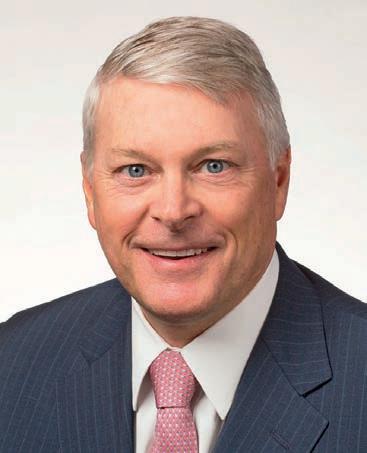
industry with significant M&A expertise, and we are confident that he is the right person to oversee this transformation while the Board conducts a search for a permanent successor.”
Dana also announced it had engaged financial advisors Goldman Sachs & Co LLC and Morgan Stanley & Co LLC to sell its Off-Highway business, as it looks to unlock substantial value for shareholders. The Off-Highway business provides drive and motion systems for heavy-duty vehicles in markets such as agriculture, materials handling, mining, construction and forestry.
A sale will position Dana with a streamlined go-to-market approach focused on serving its light and commercial vehicle customers, with traditional and electrified products that are largely shared across the remaining portfolio. Proceeds from a potential sale will enable Dana to strengthen its balance sheet through substantially reduced leverage, and to return capital to shareholders.
While the company and its advisors believe there is strong interest in the Off-Highway business, there can be no assurance that the sale process for OffHighway will result in a transaction. There is no timeframe for the conclusion of the process. As Dana continues to improve its profitability in a challenging operating environment, the company
announced further actions to support sustained long-term profitability and enhanced cash flow generation. This includes substantial reductions in selling, general and administrative costs across all the company’s businesses and engineering expenses to match current industry dynamics, including the ongoing delay in the adoption of electric vehicles.
The company expects to deliver annualised savings of approximately $200 million by 2026. Furthermore, the company plans to reduce capital spending to reflect the revised market demand for electric vehicles.
“Dana is committed to a strategy that accelerates value creation and has taken action to flex its cost structure and generate efficiencies by leveraging its core strengths through current market conditions,” said Bruce McDonald, Chief Executive Officer. “It is clear that further actions are needed, and I am confident that the new incremental cost reductions, paired with the benefits of a potential Off-Highway sale, will enhance shareholder value.
“Following the Off-Highway business sale, we believe Dana will have an adjusted EBITDA margin and free cash flow margin in excess of current levels.” Dana, according to McDonald, is differentiated by leading technology innovation and a track record of continuous improvement.
“My conviction in our businesses, the team and the opportunities to capitalise on the EV transition over the longterm remain strong. I look forward to stepping into my new role as CEO at such an important time for Dana and will work diligently alongside the Board and management team to deliver on these actions and drive value for Dana shareholders.”
Prior to his appointment as Chairman of the Board, Mr. McDonald served on Dana’s Audit Committee and as chair of the Nominating and Corporate Governance Committee.
He has been a member of the Dana Board of Directors since 2014.
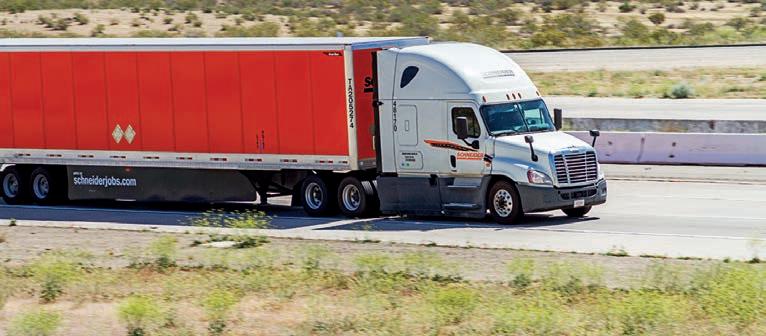
North American transport powerhouse
Schneider National has announced the company, through certain wholly owned subsidiaries, has entered into a definitive agreement to acquire Cowan Systems, LLC and affiliated entities.
The agreed upon cash purchase price of approximately $USD390 million is subject to certain adjustments.
The sale includes separate agreements to purchase certain real estate assets
relating to Cowan Systems’ business for approximately $USD31 million in cash.
Based in Baltimore, MD, Cowan Systems is primarily a dedicated contract carrier with a portfolio of complementary services including brokerage, drayage and warehousing.
Cowan Systems’ Dedicated customers include leading producers of retail and consumer goods, food and beverage products, industrials, and building
The 24th edition of Brazilian transportation fair, FENATRAN, has made history. It again proved itself the largest fair for road freight transport and logistics in Latin America, by attracting 74,000 attendees.
That was not the only record smashed. The event also achieved nearly $AUD4 billion in commercial transactions.
According to a survey carried out by RX do Brasil, the event’s organisers, the result well exceeded the $2.5 billion in revenues recorded in 2022. More than 2,000 people from 53 countries passed through the pavilions of Sao Paulo Expo, most of them from Mercosur, such as Argentina, Uruguay, Chile and Peru.
For Thiago Braga Ferreira, executive manager of FENATRAN, both the number of participants and the volume of negotiations exceeded the expectation of the organisation.
“The results achieved this year bring us a great challenge: in 2026, we want to be even better,” he said.
“We will dare, innovate and seek the best to attract exhibitors and visitors. And we have already started working on this.”
The next edition is confirmed and scheduled for the period of 09 to 13 November, 2026.
Truckmakers and other OEMs took advantage of the event to present new technologies aimed at reducing emissions and supporting industry
materials. The company operates approximately 1,800 trucks and 7,500 trailers across more than 40 locations throughout the Eastern and Mid-Atlantic regions of the United States.
The acquisition will further complement Schneider’s Dedicated organic growth success. Including Cowan Systems, Schneider will operate over 8,400 Dedicated prime movers – approximately 70 per cent of Schneider’s Truckload fleet – cementing its place as one of the largest dedicated providers in the transportation industry.
“This acquisition aligns with Schneider’s long-term vision to have customercentric dedicated solutions as the cornerstone of its Truckload segment,” said Schneider President and CEO Mark Rourke. “By complementing our organic dedicated growth success with transactions like this, we are broadening our presence to provide greater value to our customers and stakeholders.”
decarbonisation, in addition to their latest launches in terms of services, leasing, among others. Volvo, to name one OEM, achieved over $794 million in business generated by early afternoon on Friday, 8 November.
The amount includes the sale of trucks, service plans, insurance, consortium, in addition to the rental of vehicles.
Scania later announced the sale of 2,000 vehicles at FENATRAN.
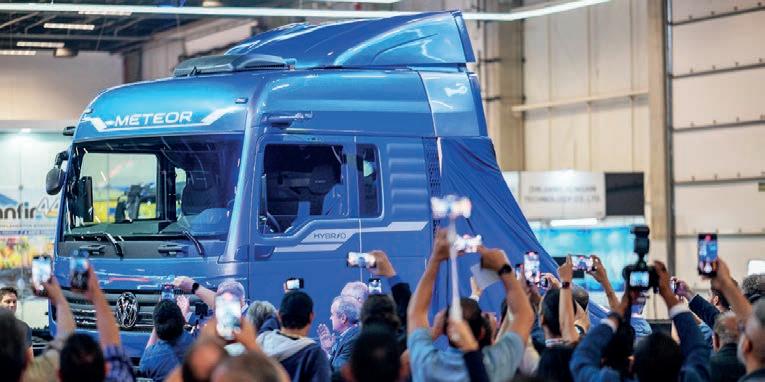



WITH THE TIMES
An
entrepreneurial family vision set in motion
Peter Sadler Removals & Logistics, a respected business that has risen above its niche origins to become a serious player across three industry segments.
Afamily business in origin, evolution and current incarnation, Peter Sadler Removals & Logistics, is a success story predicated on persistence and hard work. Conceived on the run in a pre-millennium environment, very different from today, the company commenced trading around 1997 with two 3-tonne Fuso Canters owned by a father and son team both of whom were named Peter Sadler. After some initial trial and error in several different vocational pursuits, local furniture removals, something Peter senior was already familiar with, began in earnest. Not soon after, the son secured ongoing work from Beacon Transport, a subsidiary of Linfox. Beacon’s head of ce was in Rayhur Street in Clayton.
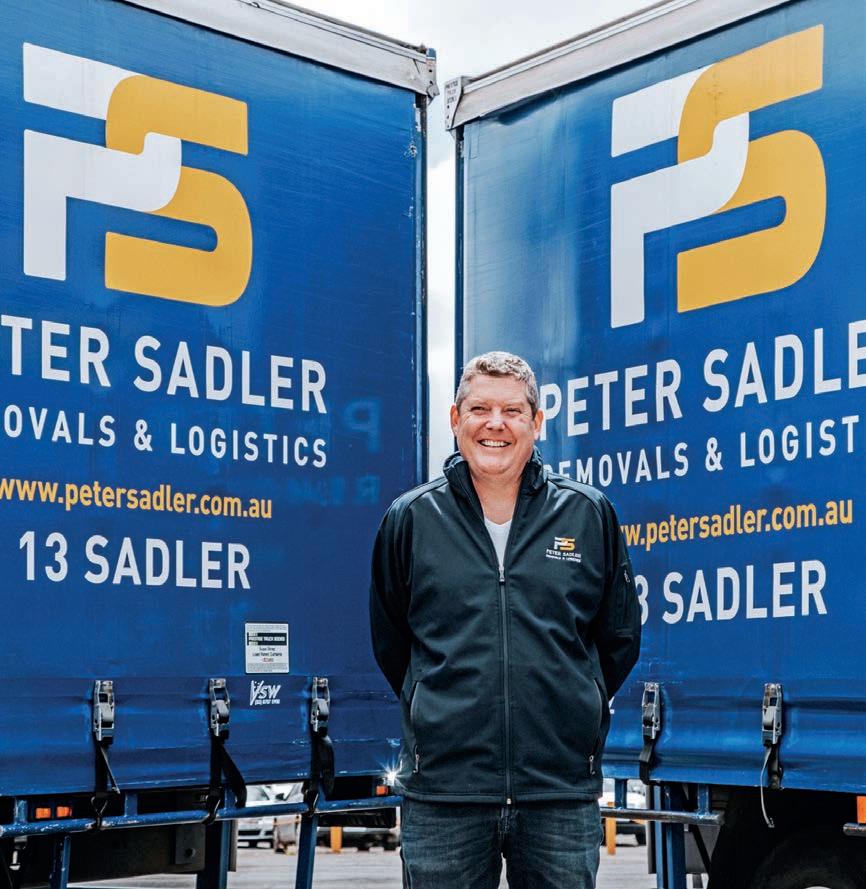
It was also where the Fox family kept many of their antique cars. Peter, the younger, then began doing personal moves to Portsea for the Fox family. The work was ongoing. Meanwhile, the son’s brother David Sadler, who was enrolled in a tertiary education but undertaking a gap year purchased a van in 1999. Over the summer period he delivered product for either Schweppes or Coca Cola. By 2000 the company was on its way to re ning its operations with David’s brother having “taken the bit between his teeth” to make it a success.
Two key discoveries were made during this period on short haul tasks in which the curtains were, to simplify it, opened and closed at delivery point. The rst was the trucks were entirely not suited; the second, soon became clear, that it would descend into a race to the bottom. In response, Peter set about curating a niche in areas where the complexity of the work made the barrier-to-entry too great for Johnny Come Lately. Aside from moving MRI machines, which are more of an anomaly, there isn’t work with a greater degree of dif culty in the fastmoving consumer goods domain. David eventually left Melbourne University with a double degree and went to work in the corporate sphere for a few years.
“I enjoyed corporate, but I came to the realisation that I wasn’t going to have any real impact any time quickly and my brother rang me and asked if I wanted to have a crack for a while,” recalls David. “I said, ‘yeah, why not?’
We’ve had mountains of ups and downs since then.”
In 2007 he of cially joined the business where he still remains as the General Manager.
“Beverage deliveries require you to go out with 30 drops for 500 cartons and you’ve got to collect cash at the same time,” says David. “Some are at service stations and convenience stores in the middle of nowhere that are still dealing in cash. The other part of the equation is the inherent dif culty of furniture removals.”
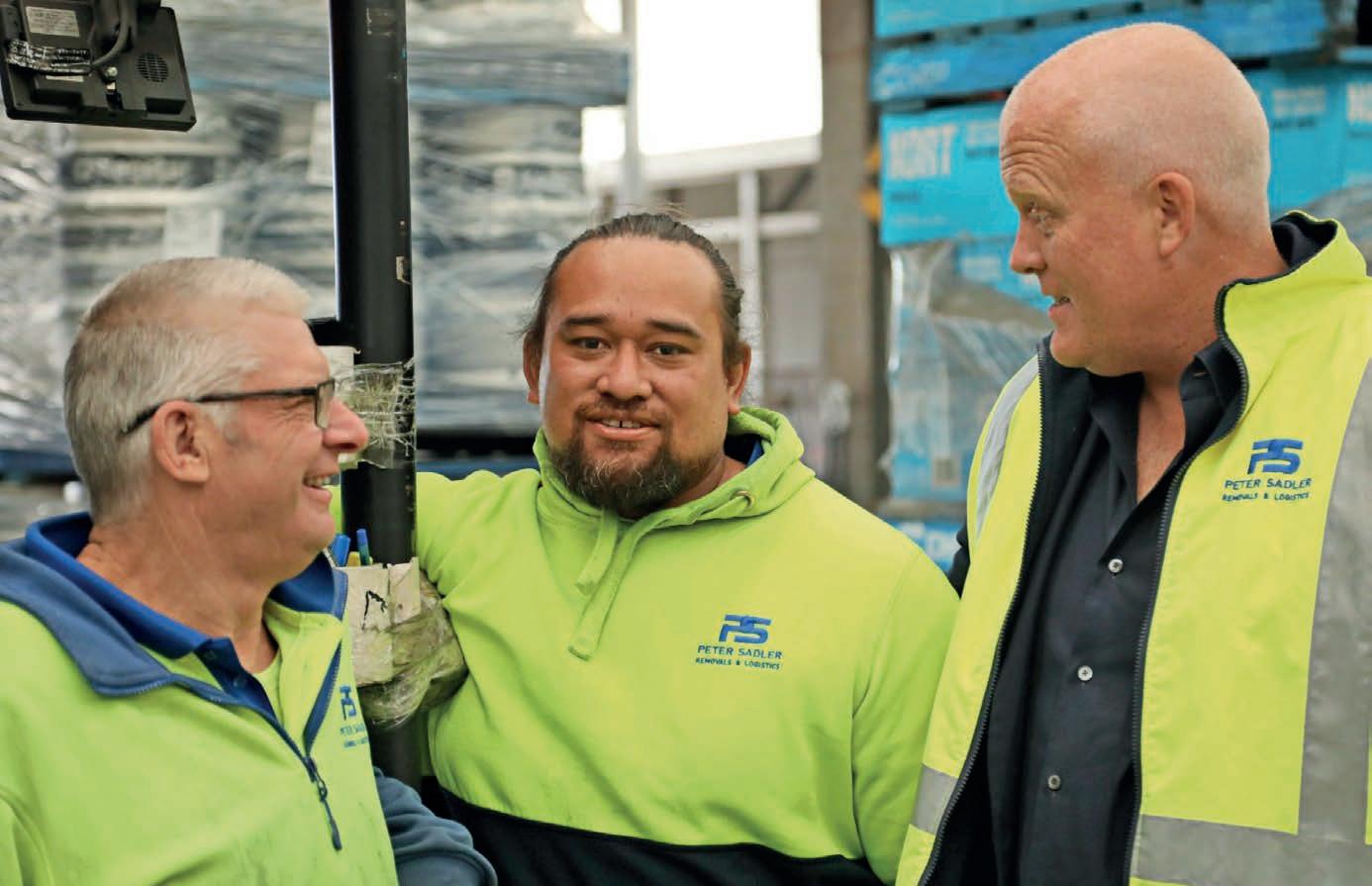
Given the bookends of the business — moving people’s houses and contract beverage transportation — in order to achieve success in those elds it became less about the truck and more about the people behind the steering wheel. The business is now modelled on what David refers to as a reverse pyramid, an idea, quite radical in its implications, that amounts to him and his brother being the least important people within the business, and the people who are out there driving and lifting all day long the most important.
“Because without them we can’t put food on the table,” says David. “When I was Head of Revenue I would say to the customers ‘you’re not as important as my drivers and they would say, ‘what the hell does that mean?’ and I would say, ‘well, if I didn’t have good drivers, you wouldn’t be a customer, so they have to come before you’. Once that sinks in, they realise that it’s pretty true.”
While the rst trucks were well suited to small furniture removals, they were not so well adapted to large furniture removals and certainly incompatible to beverage drops. Wave picks that group
orders into batches for simultaneous ful llment are problematic when there are 30 drops to do.
“Any pallet might have the stock that you want,” says David. “So, you’re clambering over pallets all day in a Pantech.”
Nowadays to nish that nal mile, Peter Sadler Removals & Logistics enjoys the bene ts of having palletised product on curtainsiders for the superior access it affords.
The two-tonne light-duty trucks are nominally operated by subcontractors these days.
“What used to be great about the twotonners that we previously owned is going out and doing 35 drops of 600 cartons of beverage or 35 drops for microbrewers where you’re handling kegs which are 63.5 kilos,” says David. “But it takes a fair bit of time to develop through the grades to get to that intensive work.”
The once traditional model for nding people and upskilling them is no longer what it was. David quotes a Sean Connery line from The Untouchables: “If you’re afraid of getting a rotten apple,
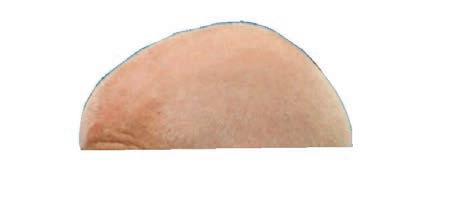

don’t go to the barrel. Get it off the tree.” Young people straight out of school or rst year of university now make the best recruits as they haven’t been indoctrinated into a particular way of doing things. The reasonable standards of what should be done in the world have diminished according to David.
“There’s a little bit of entitlement creeping into our everyday life as the generations unfold,” he says. “‘I don’t deserve to do that’ type of attitude. When we rst kicked off, we did what the business required. No matter how hard it was.”
The smaller vans helped provide a breeding ground with a steady ow of drivers progressing up to a rigid. David acknowledges that the pool to draw from isn’t as big as it was previously.
“Long story short we got rid of those vans, as it wasn’t the breeding ground it once was,” he says. “Now we take a slightly different path that takes a bit longer but eventually gets us the result we’re after.”
Typically, the eet is aligned with Isuzu through Westar Trucks in Derrimut. They have close to 40 vehicles with the lion’s
share badged by Isuzu. The eet contains Isuzu NRR 3-tonnes Pantechs, Isuzu FRRs for the 8-pallet application, the Isuzu FSD for 10- and 12-pallet vehicles, and Isuzu FVL Series for 12and 14-pallet vehicles. There are three different verticals within the business. Furniture, including residential and commercial services, a space they entered in recent years, that involves construction, joinery, high end furniture, represents approximately 20 per cent of revenue. The other segments are evenly shared between 3PL services comprising the beverage task with the exception of one signi cant customer and contract cartage which is aligned to a few select major clients whereby the eet provides a set number of vehicles a day. This will uctuate.
“We’re currently in a season where the people become more important than the truck,” David says. “We do work with a major soft drink brand where we might run 12 route loads a day through winter. That’s now upwards of 20 a day over summer and the highest point will see it get to 26 or 27 loads. With a set number of equipment, it’s really about jockey capability.”
This refers to having personnel capable of performing a double run entailing they pick up a load of up to 10-tonnes in the morning and then return for another load.
“Having a jockey with them is making sure that they are going to stand the best chance of being injury-free and stand the best chance of being fatigue free because it’s quite physical work,” says David. “It’s a unique business because
there’s nothing particularly similar about the verticals with the exception of some contract cartage and 3PL services. There’s a need for highly skilled people to be undertaking the work in each of those verticals.”
That can mean complex project management on a commercial furniture task, delivering a keg down a cellar, taking couches upstairs or picking the keg on overnight pick or delivering on contract cartage when multiple drops are the order of the day.
The current headquarters in Laverton North have recently been refurbished to increase onsite capacity. Peter’s original truck, which sits out front, will get a makeover next to further celebrate the company heritage. It’s certainly come a long way as it now employs 175 staff.
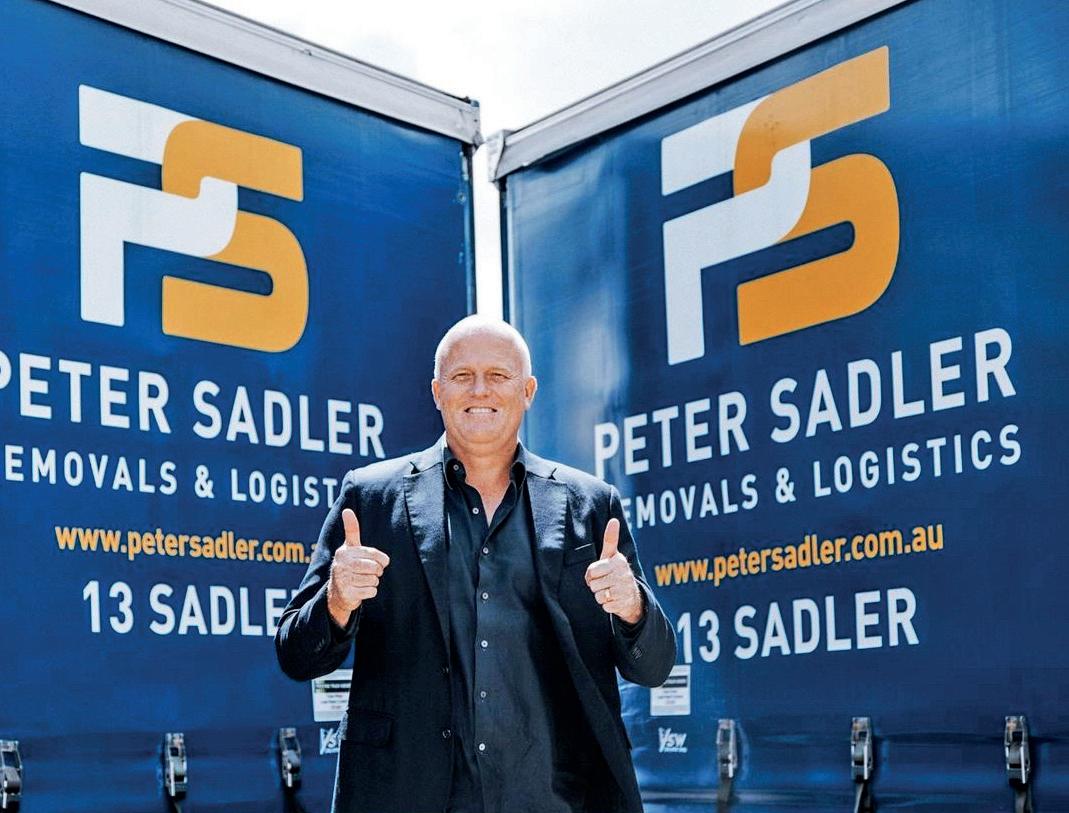
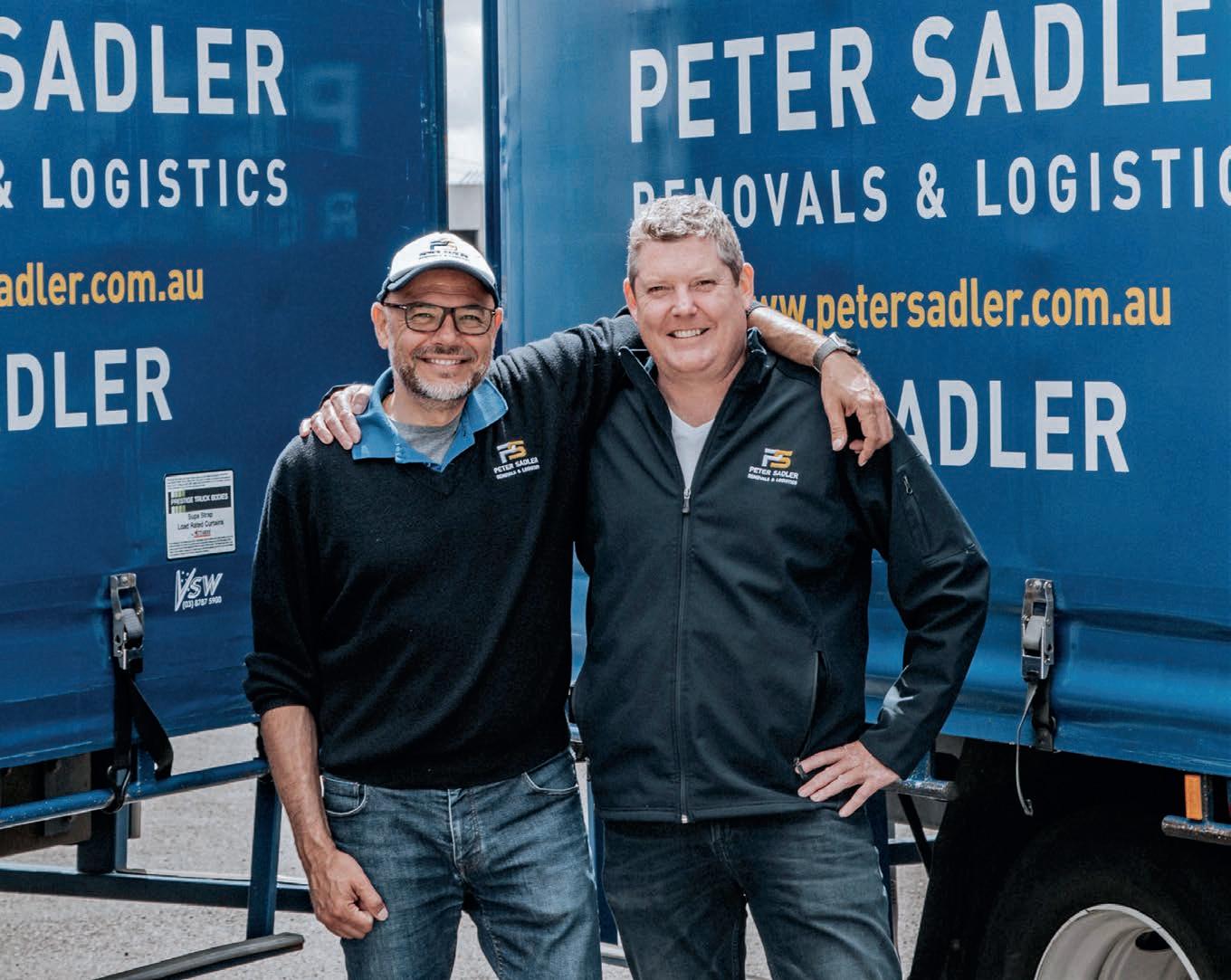
Employees like Phil Payne have been with the business nearly as long as it has existed. This year will be his 22nd. He joined in 2003. His utility to the business is widely regarded both internally and externally, having worked as a removalist, a multi-drop route driver, within the warehouse, “exactly whatever the business needed,” as David describes it.
“Phil tted in straight away. Nothing was too hard,” says David. “He’s as loyal as the day is long. He’s one of a kind.”
The organisation recently launched a new set of internal values. These are Community, Grit, Leadership, Partnership and Adventure.
“These are values we have always abided by in terms of our behaviour and our actions,” says David. “Recently, the executive leadership team made the
decision to formalise these values.”
In addition, the senior leadership is set to report on its return on investment (ROI) analysis for going green. Initially the transition will target very speci c verticals in the business. The most obvious one is in the furniture space says David.
“Why? Because the consumer is probably a little bit more inclined to say that’s something I want to be involved with,” he explains. “In tough economic times these priorities can also be delayed if the cost for the customer proves prohibitive in the short-term. But there’s not many providers that are truly ready to have an 8-, 10- or 12-pallet vehicle carrying 6, 8 or 10-tonne for a sustainable period of time via an alternative fuel service. Rarely does your household contents get above 1.5 or 2-tonnes. Rarely are you doing more than
one or two stops. It’s not a multi-drop task moving homes.”
Being as lean as possible is an imperative for the business at the moment. Hazard Analysis Critical Control Point (HACCP) and ISO accreditations are next on the agenda with a possible move into New South Wales.
“That would be the point of which it would be very logical for us to get into some linehaul work,” says David. “We’d start looking at prime movers and we’d start looking at running return on investment type of analysis. That’s not to say we can’t do it with our current con guration. It just hasn’t been the highest priority, so we’ve chosen to use different carriers, whether it be interstate, whether it be local, whether it be regional.”



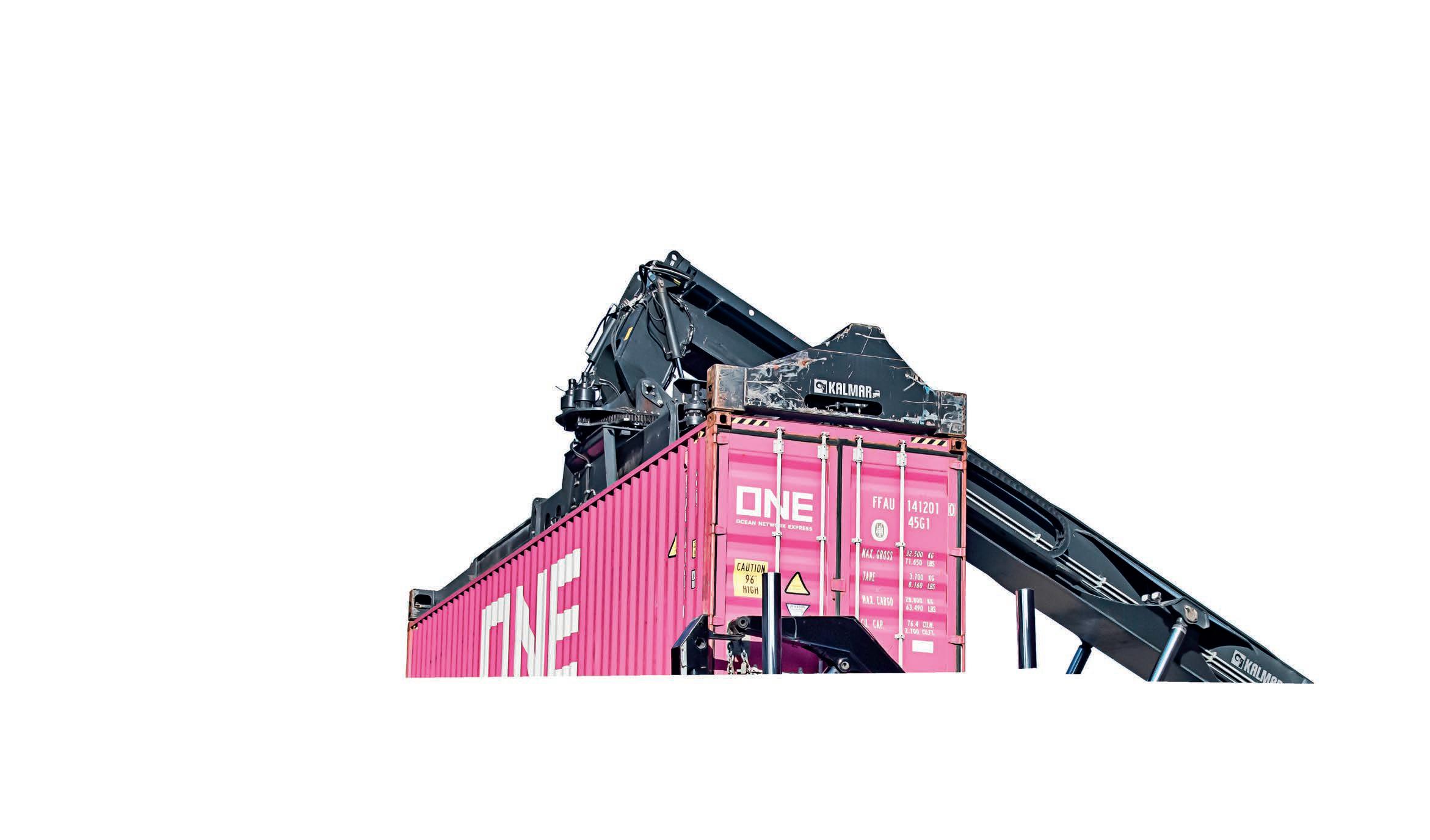
Gary subcontracted initially for NQX and then a smaller company based out of Rocklea. It had a small eet of ve trucks. They eventually went bust but not before Gary purchased the eet, bringing into existence the company that now bears his name.
A second major turning point for Rogers Transport occurred when it landed a contract with global paint supplier PPG. That partnership has lasted for 32 years. Reliability springs eternal. As a testament to the company’s levels of commitment, some of its initial customers are still being serviced today. Gary and Val’s three adult kids now all work within the business. Chantelle
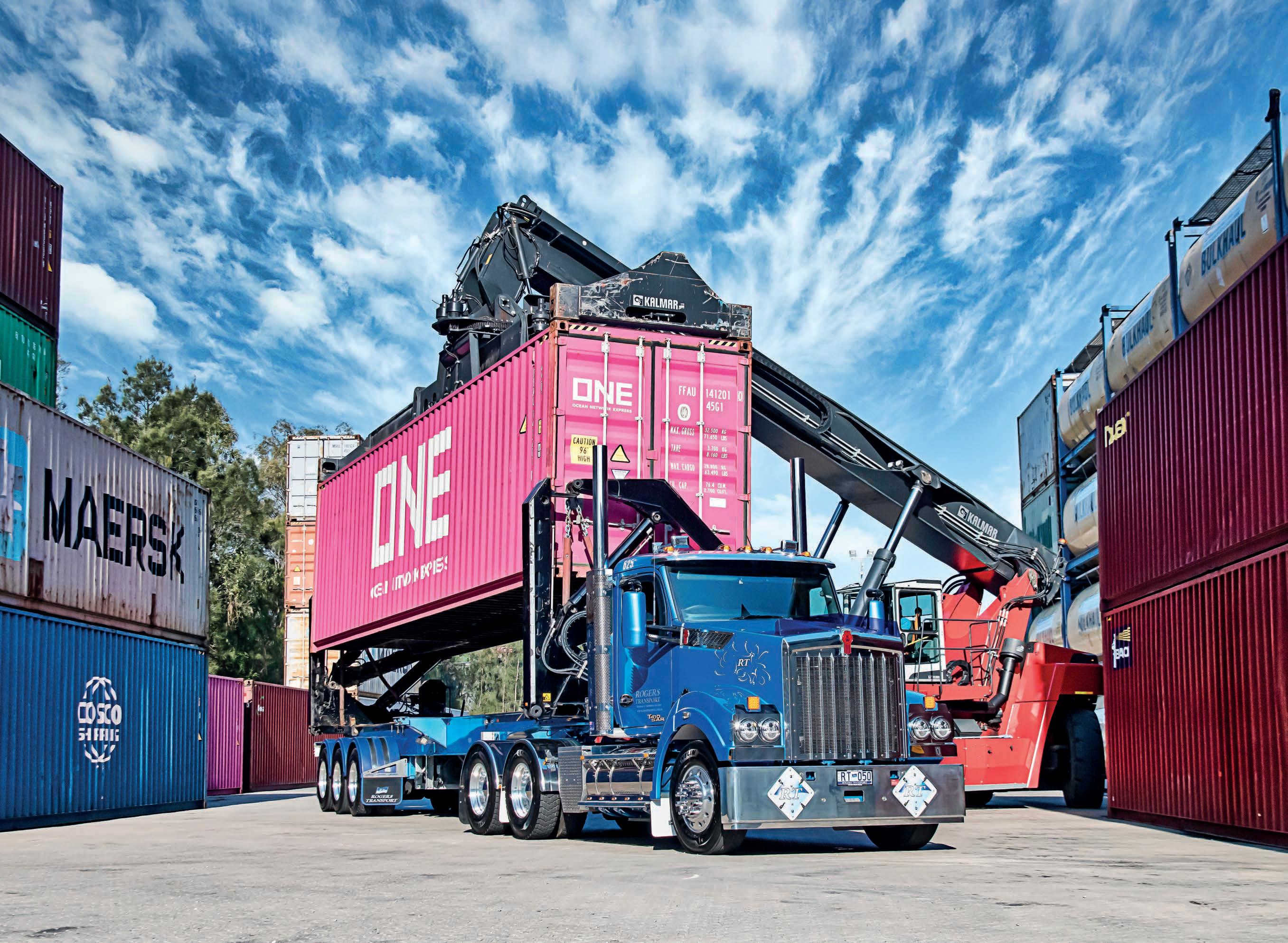

Rogers serves as Warehouse & Finance General
“He’s always had a philosophy or growing organically,” she says of her father. “He was mindful of not wanting to grow too big, too
As Gary secured more work he added to the eet. Presently, there are 45 Kenworth prime movers supported by eight Isuzu FVL Series 240-300
A tyre import business, sold many years ago, may have been the forerunner as to how they got into port cartage according to Brad Rogers, General
“A sideloader was purchased at one point to shift imported containers full of tyres,” recalls Brad. “The container distribution portion of the business right now accounts for about 25 per cent.”
The warehousing segment represents roughly another 30 per cent of revenue while linehaul achieves approximately 35 per cent due in part to accelerated ROI.
The Kenworth trucks in their linehaul and container cartage operations range across the board with a W900SAR LEGEND, T610SAR, T410SAR, T408SAR, T409SAR, T409, T610s, T410, K200s, K220, T909s, K104B, T350 and T388.
The Brown and Hurley dealership at Darra and


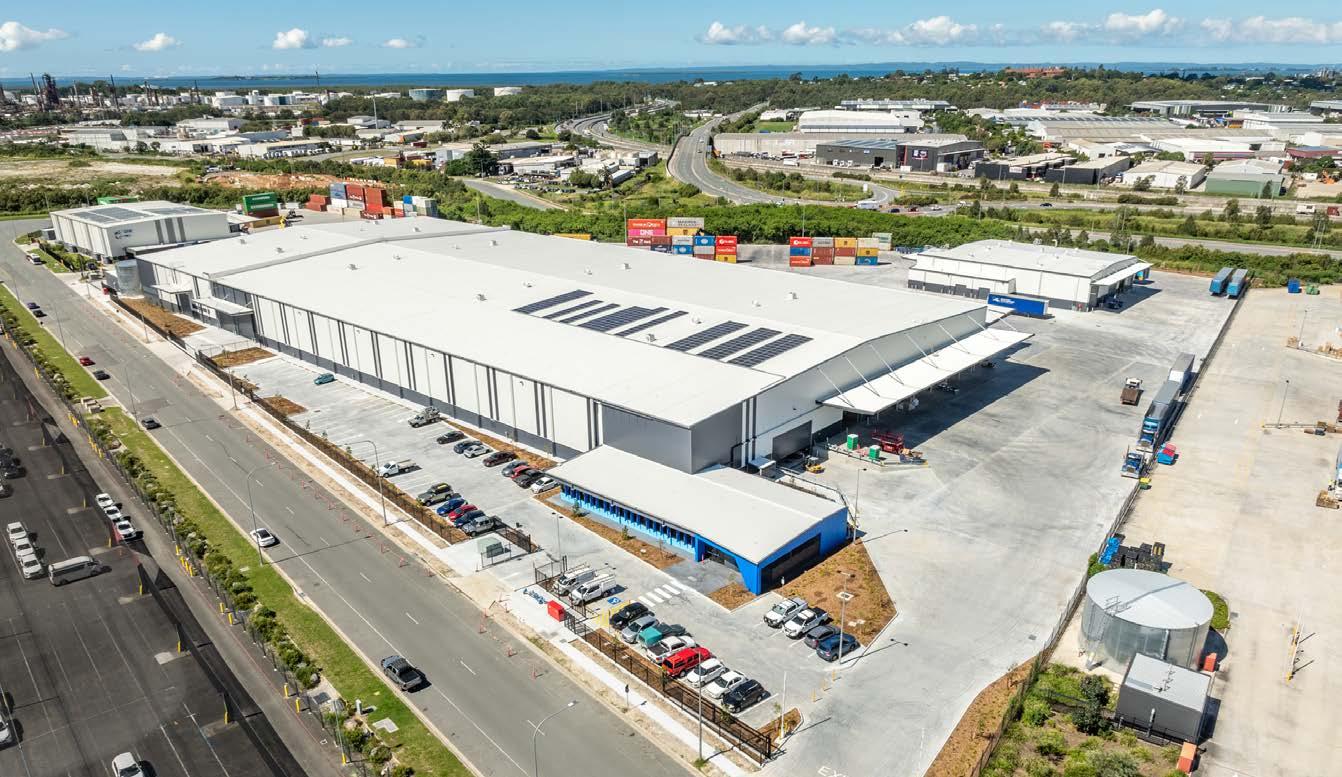
salesman Scott Coleman have delivered every prime mover in the contemporary eet undergirding the long-term solidarity of the partnership.
“The majority of the Kenworths come in a manual transmission,” Brad explains.
“You get a better calibre of driver with a manual transmission, but they are getting harder to nd.”
Each Kenworth is spec’d for roadtrain detail. While none of the trucks currently in operation perform this kind of work it enhances their resale value while also providing Rogers Transport an option, should they need it, in future.
“You never know what work will pop up,” says Chantelle. “We’re in the business where we won’t say no to any opportunity if it’s something we can make work we’ll be willing to consider it.”
The other ten per cent of the business is local distribution.
Five of the rigids are on contract wet hire arrangements with the same two customers they have serviced for the last 30 years.
The linehaul eet consists of 22 units and though primarily dedicated to the east coast regularly ventures inland.
“The eet travels all over Australia depending on what our customer needs are,” says Chantelle. “We try not to pigeonhole ourselves on just the main routes. We do a lot out in rural
Australia. We also have contract work where we hire out our drivers who complete the customer requirements on a contract basis.”
Effecting a functional one stop shop model, incorporating wharf cartage to customers and back to base, in addition to unpacking and storage in the warehouse both racked or bulk, cross-dock and redeliver have been greatly optimised since the company relocated to its new facility at the Port of Brisbane last March. Prior to the move they were in Rocklea and Lytton with some off site storage at the Port. The whole site is 55,000m2 – just under double the size of all three depots combined previously – with 18,000m2 under cover. They also have their own workshop and truck wash facilities on site. Consolidation, according to Chantelle, provides useful synergies.
“Obviously with the three different sites, we lost a lot of man hours moving drivers between them. With the one depot, if you’ve got a driver who has become free in your container division you can easily shift them across to your local division,” she says. “You’re not having to run people across to different sites meaning those hours are used to service our customers instead. With the two different warehouses, sometimes you’d end up with some product at one warehouse and some at the other. In order to consolidate
a load, you would have to drive from one to the other.”
The new setup greatly advantages the workshop as it no longer needs to cart parts and equipment between the sites for servicing.
“To be fair, we probably outgrew the previous sites years ago,” says Brad. “There was probably not really any opportunity for growth. That’s the biggest advantage — we’ve now got the opportunity to grow.”
The new facility enables Rogers Transport to expand its offering in both 3PL and carrier divisions.
“Medium-term, we have goals to not only grow the business but also work towards being the best business we can offer through enhancing safety measures, improving our operational ef ciency and boosting our customer satisfaction as we continue to offer the same personalised service that our customers have grown to love, no matter our size,” says Chantelle.
Longer term, however, the expectation is the baton will be passed onto the next generation of the company while shining a light on Gary and Val, who have worked tirelessly to build the company. Investments in IT and green technology are anticipated. Their younger brother Troy also works at the business in an of ce role.
Growing up around the business, with Brad often sweeping the yard on

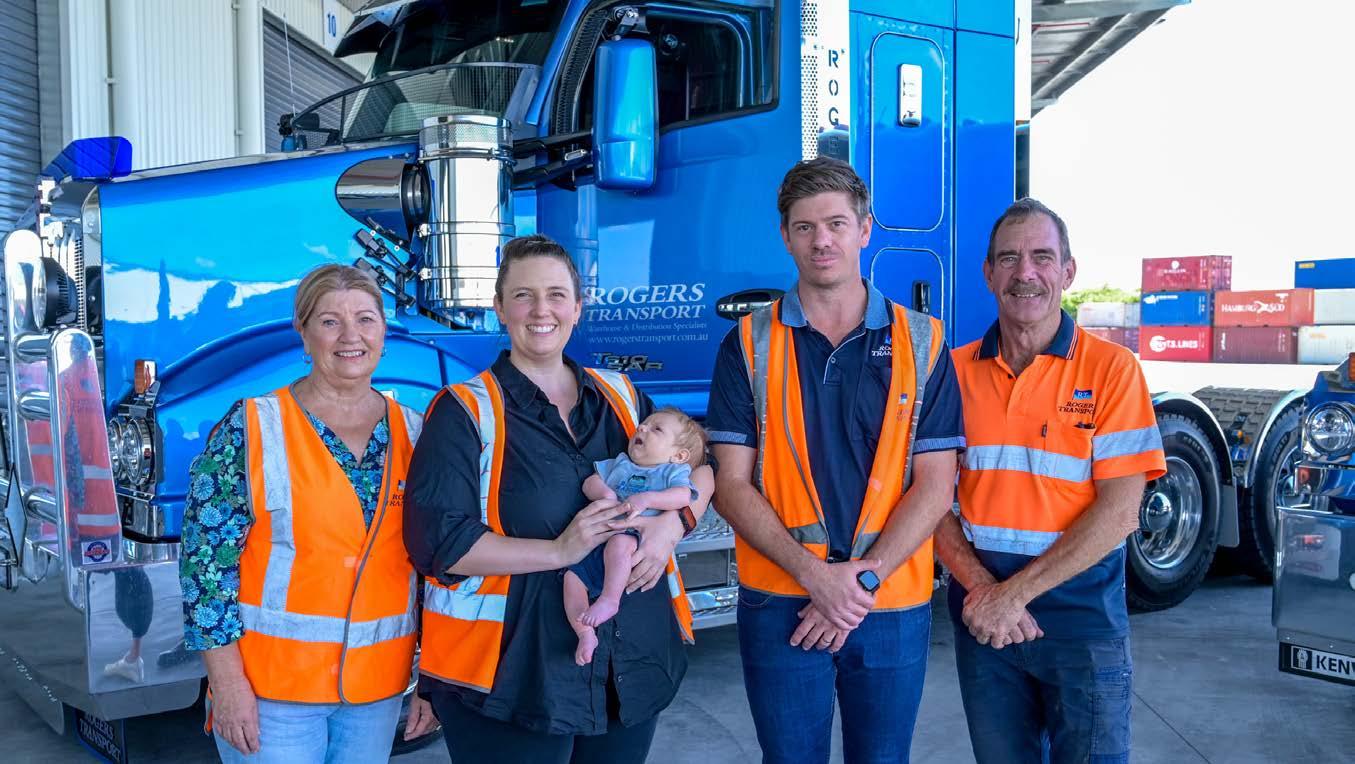
weekends and Chantelle handling administrative tasks like ling, their parents encouraged them to seek experience elsewhere as part of their development.
“It was strongly suggested to both of us that we do something else,” Brad notes with a laugh. And he did. That resulted in construction management studies which subsequently saw him posted in that industry for the better part of ten years before Gary asked him if he was ready to join the family business.
Chantelle, who had persisted six months at university knowing it wasn’t for her, began delivering automotive parts for Chrysler, Jeep and Dodge in a Triton ute. She loved it. While she was on holiday in New Zealand, the replacement driver rolled the vehicle which was substituted with a “hideous” parts ute with body cage that hadn’t been used in several years.
“The doors wouldn’t open, and they wouldn’t shut. That’s when I was complaining to dad one day and he offered me a job here,” she recalls. “I think it was inevitable anyway, but I think it helped move up the timeline.”
That was 16 years ago. More than enough time to develop a standard by which to compare present circumstances with the past. Rates and driver shortages will, in her view, continue to vex the
industry for the foreseeable future. The overarching issue is the disconnect existing between operational realities and consumer demands, which are becoming increasingly unrealistic under the “now society” as she describes it.
“Without any background into how many cogs are turning in the supply chain to meet these consumer demands, coupled with issues surrounding driver shortages, declining rates and a more heavily regulated industry to ensure the safety of our drivers, it’s
Rogers Transport also runs regional B-doubles.
certainly becoming a challenge to meet both customer demands while also maintaining the pro tability of the company,” she says. “Viability has always been important in this industry however we have seen rates on a downward trend while costs continue to rise. This means viability is now becoming more important than ever – every kilometre the truck covers needs to be running in the most optimised and ef cient way possible in order to hold our share in the industry and continue to thrive.”
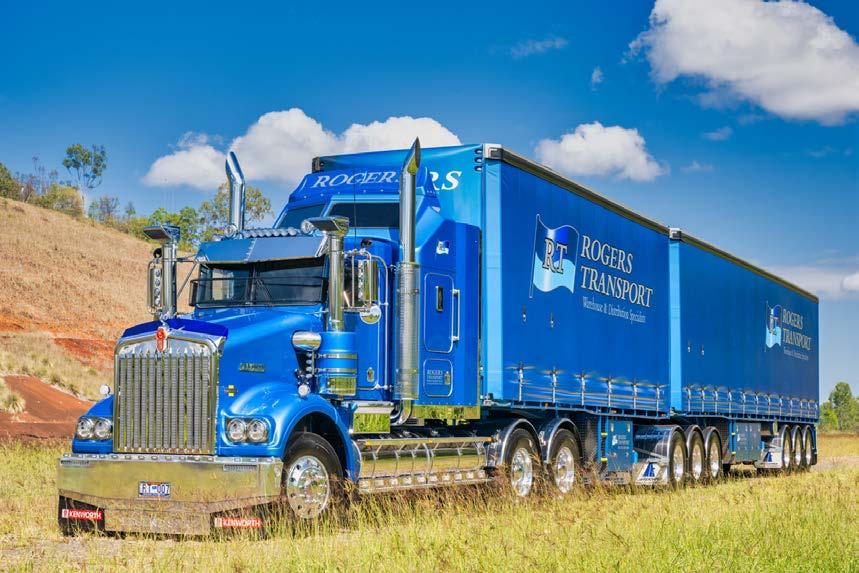
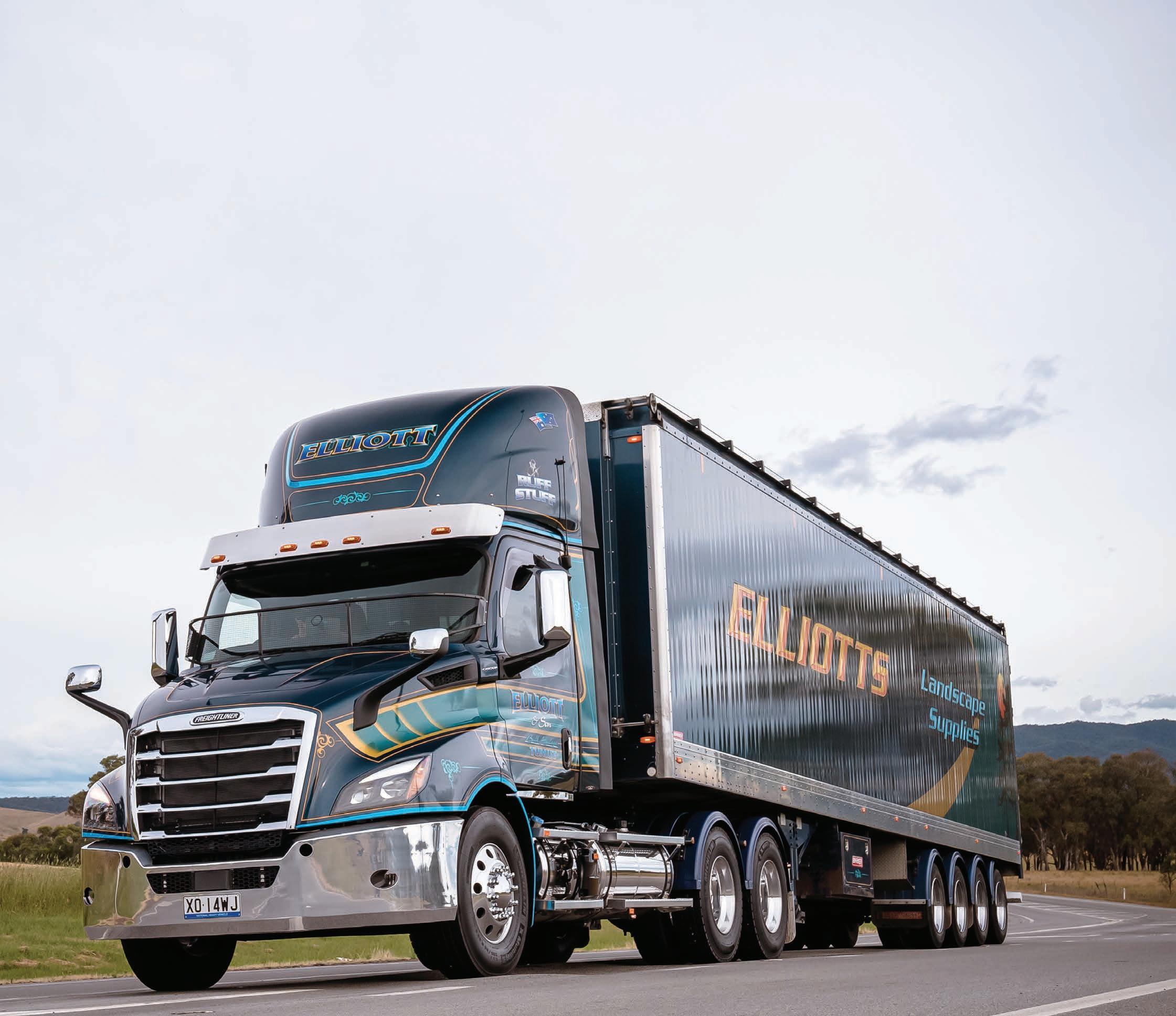
E ciency is a major factor in the Elliott’s Bulk Haulage operation which is based in the town of Tumut in the foothills of the NSW Snowy Mountains.
Achange in career away from his trade as a panel beater and spray painter saw Graham Elliott buy his rst truck in 1962 which was a tipper he drove for various organisations in the Tumut region such as Tumut Council and the Forestry Corporation. Graham also established a small landscape products supply service for materials such as sand and gravel. Graham’s business grew quickly after he began doing transport work for local sawmills hauling wood chips with semi-trailers between mill sites located in Tumut. This area of operation grew to include four trucks working from the mill sites and Graham also ventured into the pine bark business. Graham purchased the raw bark material, which until then was
mostly considered a waste product, from the mills, built a bark grading plant in Tumut, which sorted it into different sizes, before it was delivered to mainly Sydney based customers.
An industrial accident laid Graham up for many months and his son Grant, the “Son” in Elliott and Son Bulk Haulage quickly took over the running of the operation.
“I was just a young truck driver which back then was all I ever wanted to do,” recalls Grant. “I didn’t want to come into the of ce but didn’t really have a choice.”
With four trucks then on the mill work and another running to Sydney daily, Elliott’s was also supplying a lot of graded pine bark to various Sydney landscaping suppliers who would arrange their own transport to pick up eight to ten loads each day.
The Elliott’s entrepreneurial minds sought to expand the business without affecting ef ciency.
“I thought there was a better way, so I got the Sydney Yellow Pages and started to ring every single landscape yard in the book,” says Grant. “Within 12 months we grew to four trucks running


daily to Sydney, expanding eventually to 19 trucks and 68 employees with a 24-hour workshop staffed by six diesel mechanics.”
Grant was managing both the burgeoning landscape yard and the growing transport business and by 2017 was stretching himself too much so the decision was made to sell the pine bark business to Martin’s Fertilisers in Yass. Later that same year devastating bush res saw all of the sawmills in the region go from 24-hour operation to ten hours on just four day weeks. The forestry industry lost half of its timber resources and for the next 12 months Elliott’s dealt with burnt pine bark as loggers attempted to salvage what they could.
“It changed the landscape up here forever,” says Grant. “It takes 22 years to grow a ‘saw log’ so it’s not going to change up here for another 15 years or so.”
Elliott’s currently has six prime movers with two more on order. Two Freightliner Cascadia 116 day cab prime movers have joined the predominantly Kenworth eet at Elliott’s and the move came about mainly due to Grant’s longterm relationship with Dave Warren who became the Dealer Principal of the Daimler Trucks dealership in Wagga Wagga. The Fuso Canter tipper which delivers material from the landscape products yard also came via Dave Warren.
“Dave’s been a friend for years and he was our Kenworth salesman, and I’ve bought many trucks from him over the years,” says Grant. “I normally keep trucks for ve years and I’d never really looked at Freightliner, but back then there was a long wait for Kenworths, so I ordered the two Freightliners.”
The Cascadia’s are performing mostly local work, hauling wood chip ten to 12 hours per day from Tumut sawmills to the VISY plant, then the afternoon shift hauling ungraded pine bark to Yass, then going to Canberra to pick up loads of woodchip which is in turn delivered to the VISY papermill back in Tumut. Working about 20 hours a day,
each day, the Cascadia’s have travelled around 170,000 kilometres over 12 months. The Freightliners are powered by DD13 Detroit Diesel engines rated at 505hp and 1850lbs/ft of torque and are equipped with DT12 overdrive automated transmissions and Meritor diffs riding on Airliner rear suspension. The bespoke liveries are not wraps but are actual paint and were designed back in 1988 by Graham Elliott who rst applied them to his then brand-new Ford LTL 9000. The standout paint schemes have won Elliott’s the prestigious PPG Fleet of the Year award twice.
The Cascadias are connected to fouraxle Barker moving oor trailers which feature self-steering rear axles and have a capacity of 100 cubic metres. Operating on the Higher Mass Limit of 50.5 tonnes the combinations deliver a 30-tonne payload.
To give each truck its individual identity they are named for AC/DC songs, an idea
Grant’s wife Tanya came up with.
“The fuel consumption from the Freightliners is exceptional,” says Grant. “Bear in mind they’re doing local work and unloading up to ten loads per day with the moving oor, sitting there at idle pumping the trailer out. The trucks the Cascadias replaced averaged 1.67km/ litre and the Cascadias are delivering 1.84 km/litre. That’s a big saving.”
The strategic downsizing of the Elliott’s business in 2017 subsequently led to a compact and more ef cient operation according to Grant.
“We can’t downsize any further than what we are now. At the moment we’ve got a very ef cient, very easy business,” he says. “Gone are the days of trying to organise 68 people and trying to nd loads all over the place. Our drivers now basically have a roster three months in advance and very rarely do we have to vary anything. We’ve got long-term drivers — some have been here over 20
years. We’ve been very mindful of being in the situation over the next few years when those drivers retire, they’re going to be very hard to replace. Today, we’re not looking for drivers, we don’t currently have a driver issue and haven’t for years, but as these drivers retire that’s going to be a challenge replacing them with good drivers.”
Re ecting on the continued success of the business Grant praises his father Graham’s vision.
“My father saw a market for pine bark many years ago when it was considered a waste product and over the years we’ve managed to get everything tied in to work together even though there are separate contracts for pine bark and wood chips,” he says. “We also haul Tumut’s local household waste to Jugiong every day. Everything that we do ts in with the other pieces of the puzzle to make it a very ef cient and pro table business.”
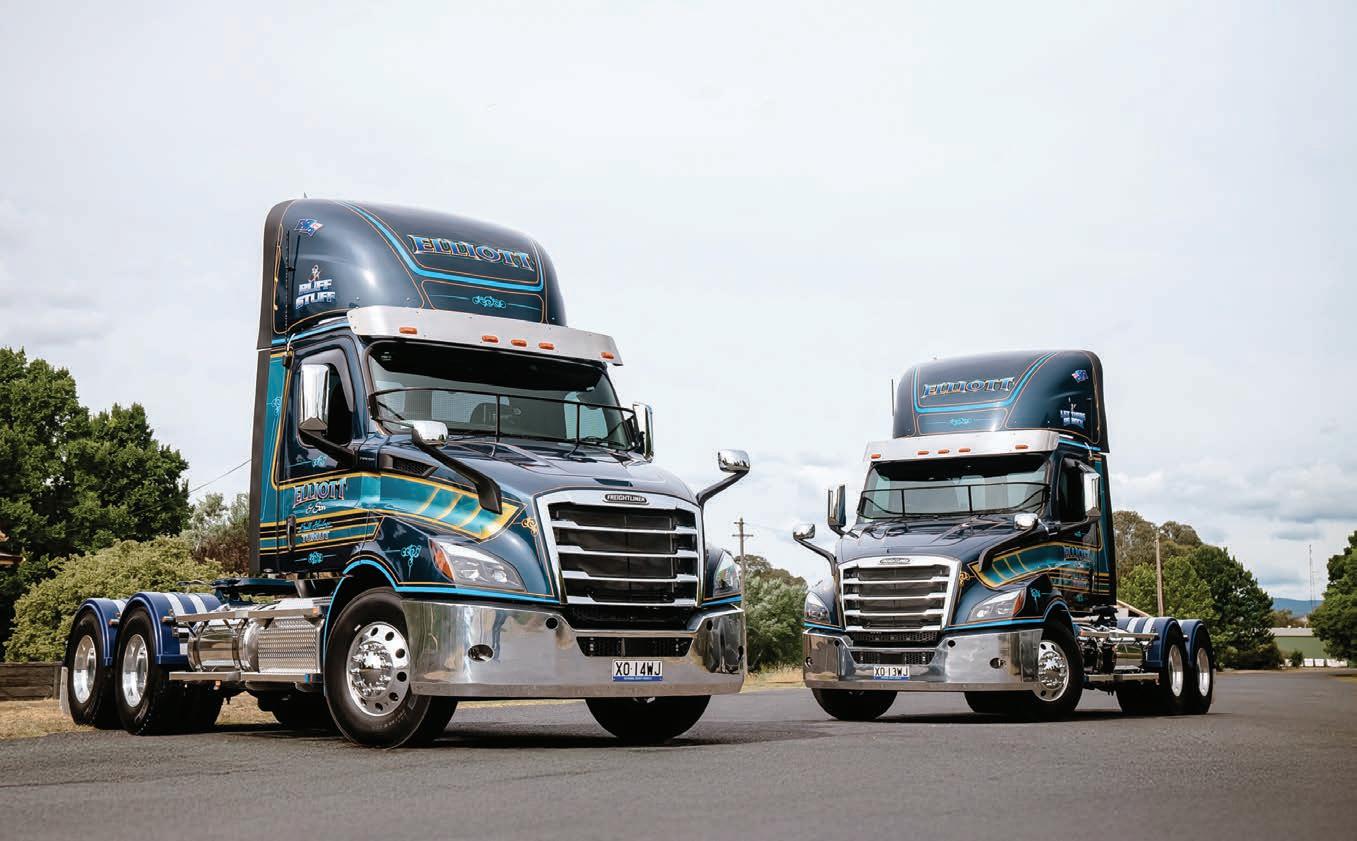







The eet at JOPA Queensland has grown to 20 trucks in its twentieth year. It’s a successful operation built on the back of strong relationships with both customers and suppliers.
In the highly competitive world of bulk construction supplies, service and innovation are two of the crucial factors required for a successful business not only to survive but thrive. JOPA Queensland is celebrating its twentieth year of operation with the delivery of its twentieth Hino truck, which is itself a signi cant milestone in the company’s journey. The company name JOPA Queensland is inspired by the owners’ names JOdy and PAul Curtis.
JOPA doesn’t operate from a typical retail landscaping supplies yard, instead the company uses a bulk holding yard in a strategic location adjacent to the Logan Motorway, providing easy access to not only the Gold Coast, but also the northern suburbs of Brisbane as far as Caboolture, and west to areas around Mount Marrow and Fernvale.
A feature found on most of the JOPA trucks is the centre tailgate tted to the tipping bodies which accommodates the transporting of two different bulk products at the same time, delivering an obvious ef ciency bonus as well as a reduction in JOPA’s carbon footprint by signi cantly reducing the number of truck movements required to deliver their customers’ needs. The loaders at the yard have special buckets to suit the two compartment tipper bins. Most of the trucks initially leave the yard in the morning fully loaded from material stocks held there, and then after that rst delivery is achieved, they often reload at various suppliers’ facilities throughout the rest of the day, reducing the need to return several times to home base and delivering a more ef cient service to the now more than 350 regular customers.
“I explain to people that, just like Uber, the material is our passenger and we work our way around and can be in and out

of different quarries throughout the day,” says Paul. “We’re not married to one supplier, as much as the suppliers may want us to be. Theoretically, we’re a transport company and instead of transporting parcels or freight or bricks, we deliver the sand, gravel, road bases and similar bulk products for the construction industry.”
The inspiration for the divided tipping bodies came to Paul back before 2010 when he was driving behind a small landscape supplies truck which had a divider tted and had bagged cement at the rear and some bulk product at the front. Paul immediately realised the better option this offered, as distinct from the established method of using a tarp to separate different products being carried in the one tipper body. Paul experimented with a number of different con gurations to determine where to put the additional centre tailgate before arriving at what has since proved to be the optimum design.
“The majority of our clients, such as drainers, would buy six metres of one type of material and two to three metres
of another material,” says Paul. “Hence we had to put the biggest sector on the back so we can legally carry six metres of material in the back compartment and, depending upon the product, carry up to four cubic metres in the front. We had a few smaller trucks in the early days which could carry around seven cubic metres and we had a different con guration of split but it wasn’t safe, so we came up with the idea that a small truck can’t carry big loads, but a big truck can carry small loads.”
The smaller trucks were progressively changed over to Hino FM500 models which have since become the standard units in the JOPA eet.
The bespoke tipping bodies, on the other hand, are manufactured by MiniBody Engineering at Acacia Ridge, and Auzprint in the Brisbane suburb of Hillcrest take care of the graphics, including a special twentieth anniversary livery for the latest Hino 500 Series FM2628 auto which also becomes JOPA’s twentieth Hino. The JOPA livery has evolved over time and still retains the JOPA logo in yellow with the entire tipping bin now wrapped in
black vinyl which can be easily removed when the trucks are on-sold, leaving the aluminium looking like new.
Prior to establishing JOPA, Paul’s background was in the parcel freight industry and the JOPA Queensland business commenced in 2005 with a modest $15,000 start-up investment. This included a little Daihatsu Delta tipper which was traded less than a year later.
Paul admits he didn’t know a lot about the market when he started out but armed with an honest approach to customer service and the promise of ontime deliveries provided customers with an option and a reason to change the way their businesses were serviced. Initially he was intent on buying a truck that could carry ve cubic metres tantamount to around 6.25 tonnes in payload.
“Hino at Coopers Plains had a factory tipper called a Hino FC Dump which could carry 6.4 tonnes,” recalls Paul. “I thought we’d halve our workload because we had a truck twice as big, but in actual fact it doubled our workload because the business grew.”
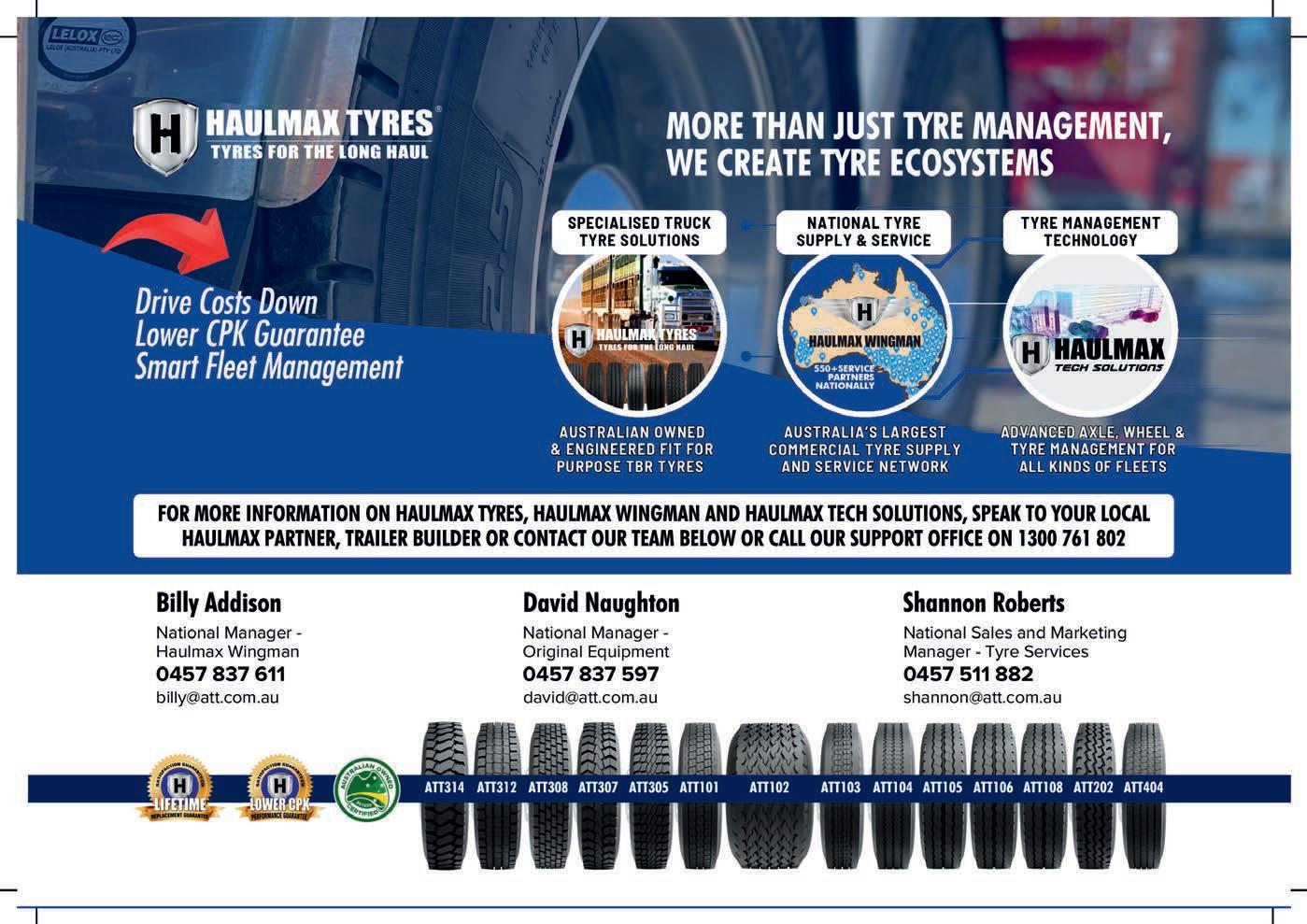

On the advice of Brad Elliot at Sci-Fleet Hino, JOPA purchased its rst tandem drive Hino FM500 in 2007.
“Sci-Fleet were just so helpful and the following year we bought another one, so within three years we had the two tandems and still had the little Hino FC Dump which we hung onto for ages,” Paul adds.
Prior to the pandemic Paul would order a new Hino from Sci-Fleet when the JOPA eet’s oldest truck reached 300,000 kilometres and by the time 350,000 came around the latest truck was available and ready to replace it.
“When COVID came in it was hard to get trucks so we’re running trucks now up to the 400,000 kilometre mark, which in the lifespan of those trucks is actually nothing,” says Paul. “Now we’ve reached a stage with the twentieth truck — the oldest one we’ll keep as a spare.”
The Hinos are not on a service contract and visit the dealership every 20,000
kilometres, taking advantage of SciFleet’s night servicing and the use of a courtesy ute for the driver.
“We’re not mechanics so we let SciFleet’s mechanics do the mechanicing, the same as we let our accountants do the account stuff,” Paul says.
Demand for JOPA’s products has recently proved so strong that JOPA has co-opted a truck and dog owned by Aaron McKenzie’s Queensland Bulk Landscape and Civil Supplies (QBLCS) to deliver some of the larger bulk loads.
Supporting Jody and Paul in meeting JOPA’s “You ring, we bring” service commitment, is son Matthew and his wife Olivia, along with an enthusiastic and experienced team of drivers and of ce support staff.
“Matthew has been here for 15 years and basically runs the operation with assistance from Zane Ellison,” says Paul. “These young blokes are amazing and are moving about 1,200 cubic metres
a day around the greater Brisbane area. People have to have places to live, and the housing industry continues to grow, and our data base of customers continually grows.”
Twenty years ago, JOPA’s rst customer was Ownit Homes, an award winning building rm which remains a valued client to this day.
An online presence has been developed and existing and potential clients can obtain a quote by using the JOPA Queensland website.
JOPA has built a strong foundation by providing exceptional service to existing customers utilising some innovative equipment and continues to show strong growth despite never having to advertise.
“It’s all just word-of-mouth,” says Paul. “I just couldn’t say ‘no’ to people. To be honest I had no idea that it was going to be like this. I’m humbled by it and I pinch myself every day.”

A new tribute truck honouring the former General Manager at Red Horse Transport reveals a story of integrity, commitment and sel ess leadership.
Fledgling freight carrier Red Horse Transport in a little under a quarter century has diligently carved out a respectable reputation, initially in southeast Queensland and now as an interstate player. Determined to become a national presence, the company, it’s fair to say, has appraised the wider Australian transportation and logistics sectors and likes what it sees. While market share capture is not one of its stated aims, the business is having an industrious period of growth all the same.
Shortly after it opened a 5000m² warehouse in Stapylton, strategically located between Brisbane and the Gold Coast, Red Horse Transport commenced plans to establish a new

site in South Australia. Widely regarded as a key growth corridor for logistics and freight carriers, South Australia is still largely untapped on the national network for companies looking to offer advanced storage solutions downstream from their transport services. That facility opened late last year. It marks another milestone in the organisation’s recent ascent.
Internally, the investment is viewed as an opportunity for Red Horse Transport to deliver leadership in the logistics sector by better equipping itself to serve clients with greater ef ciency and care, one of the hallmarks of the business according to the company, which was founded in 2001. The mandate has drastically diversi ed since it rst began as a metro
last mile provider de ned by its use of commercial vans. The opportunity to evolve alongside the country’s growing logistics demands prompted the company to steadily expand to the national bulk freight transportation specialist it is today. The eet has grown to nearly 150 mobile assets including prime movers, rigids, LCVs and trailers. Heavy cargo in its oversized load management is handled by Kenworth and Volvo prime movers. Smaller freight tasks are allocated to rigids including new Hyundai trucks. The Toyota HiAce is the van of choice.
Two areas Red Horse Transport likes to pride itself on are innovation and customer service. Indeed, the three core values celebrated at Red Horse Transport
— family, teamwork, and safety — were embodied by the late General Manager Patrick Glassborow, whose sad passing in 2024 has been commemorated on a new Kenworth K220 dedicated to his memory.
The single steer tandem drive prime mover built for roadtrain work is powered by a Euro 5 Cummins X-15 600hp engine that is capable of delivering 2050lb/ft in the old scale. The powertrain incorporates an 18-speed Endurant XD Pro transmission running through Meritor MFS73 single steer axles with a 7.3-tonne capacity. Suspension is on taper leaf steel springs. The rear axle is standardised to a ratio of 4.10. According to Fleet Manager Joe Xi, the new truck in intended to serve
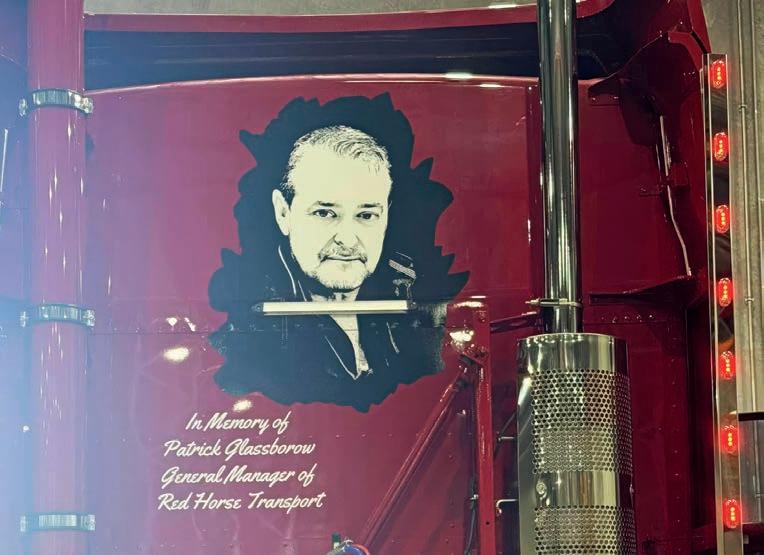


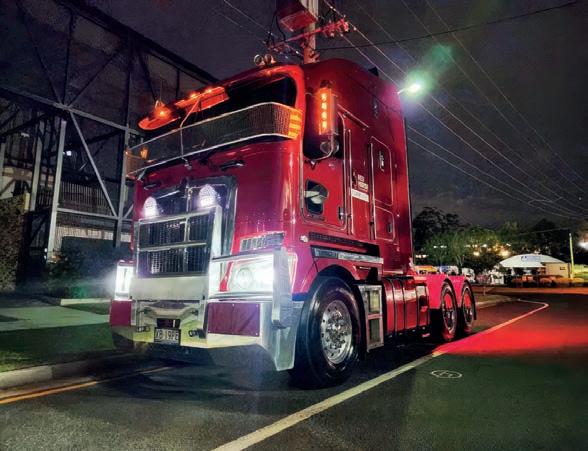
as a moving testament to Patrick’s unwavering leadership and profound impact on the company. Big Red, as the Kenworth K220 has been dubbed, is more than just a vehicle—it’s a symbol of the spirit and vision Patrick instilled in Red Horse Transport.
“As it travels across Australia, it carries not only goods but also the memory of a man who transformed a small operation into a trusted logistics provider,” he says. “This tribute is a daily reminder of his values, dedication, and the family-like culture he fostered within our company.” Patrick’s colleagues at Red Horse Transport recently offered their thoughts on the positive impact he had on the organisation.
Daniel Tilby, Operations Manager, joined the company 12 months ago. His decision owed in part to the vision and experience Pat had for the business and the industry in general.
“Along with the directors, I was drawn to the standards at which Pat had encouraged and set and the expectation of service that was expected for it to be a successful company,” he says. “Pat had deep experience, knowledge, leadership and daily commitment. I wanted to be part of something special alongside him and the directors and help build a great company so joining the team and having the chance to learn from Patrick and follow his leadership was one of the best decisions I have ever made.”
After 35 years in the freight industry

working for some major businesses, Daniel still believed there was much more to learn. Pat, he recalls, was the perfect leader to provide mentorship for not only developing skills but adding to his knowledge base that had been lacking in his previous roles.
“His experience was invaluable, his leadership solid and honest in how he dealt with everyone from his team to our valuable customers and suppliers,” he says. “It was easy to see what his vision was for the future and for the company on the back of the foundations he has already set in place.”
Mayzee Wells, Red Horse Transport
Compliance & Customer Of cer, says it was apparent that Pat was very different from the moment she rst met him.
“He wasn’t like a normal run-of-the-mill General Manager,” she recalls. “He was a straight shooter, straight off the bat and his humour was out of this world funny. He had a very down-to-earth, calm demeanour which made me feel very comfortable and at ease and I feel so privileged to have been able to work with him for the time that I did.”
Pat was also a mentor gure to Mayzee, having taught her considerably about business intricacies across a range of concerns.
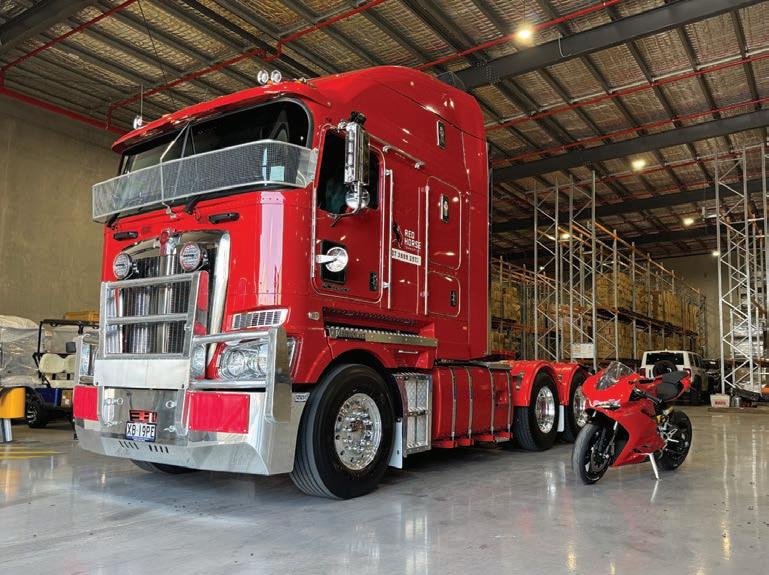
“What stood out most for me, is the actual way he taught, the way he worked, and the way he managed his staff,” she says. “He treated everyone as equals, there was no difference if you were a manager or administration at Red Horse, we were all respected and treated the same and felt as though our jobs were all as important as each other’s which I have never felt before in a workplace, and I strongly believe that it was Pat that instilled that culture.”
She took advantage of the fact that Pat was very knowledgeable by trying to learn as much as she could from him, which he was always more than happy to share despite being very busy.
“He would always have time for you whether it be for work or even just daily life, he would give you his time and he was genuine and for that, I will always be grateful,” she says.
Patrick had been exposed from a young age to road transport. His father had been a workaday truck driver for Mullins Transport in Melbourne. Pat’s own path to trucking was circuitous having worked
in health then later becoming an owneroperator himself before he attended university where he received a bachelor’s in business studies. From there he worked his way to State Manager and ultimately General Manager of Red Horse Transport.
“Pat had the ability to understand all perspectives of business and was a champion for drivers as he knew how hard they worked,” says his widow, Allie Glassborow. “He understood customers’ needs and wants and was able to make things happen. He was also good at nance, sales and all things business management. There aren’t many in the industry like him and he had a large network of people across the country that relied on him.”
Pat passed in June. He was 58. He is survived by wife Allie and two adult children, daughter Searsha, and son Lachlan, who supported and cared for him through his years of illness.
“Pat struggled health wise and showed great strength and determination to overcoming his health issues on a day-to-
day basis and remained positive,” adds Allie. “Work was a great motivator for him, and he always strived for success.”
A mentor at a suicide prevention group called Brothers in Arms, spending time late night helping others, often strangers on the phone, Pat was called “inspirational and a high achiever,” by Phillip Mills CEO of Beattie Transport, a company he previously worked at.
“Regardless of his personal struggles, Pat pushed his challenges aside and soldiered on in a sel ess manner,” noted the former colleague of Pat. He eventually met his end with dignity and poise.
Though the last few months of his life were really hard, Mayzee says he would still turn up to work and give 100 per cent.
“I think that is very admirable. He was a family man, and they were his driver, the love for his wife, son, and daughter was very obvious by the way he spoke of them,” she adds. “There will never be another Pat, he was one of a kind. I am very thankful to have been a part of his journey here.”
[Park Pty Ltd (ACN 093 014 129)
Park Pty Ltd (ACN 093 014 129) convicted and fined for water and land pollution offences
Park Pty Ltd (ACN 093 014 129) (Park) was prosecuted by the NSW Environment Protection Authority (EPA) and pleaded guilty to one offence of water pollution and one offence of land pollution.
Park is an Australian fuel supply company that sources, supplies and distributes petrol and diesel and is based in NSW. On 3 June 2022, during a fuel unloading operation at a service station in Bowral, a Park employee incorrectly connected the hoses between a fuel tanker and an above-ground storage tank. As a result, a large quantity of diesel spilled from Park’s fuel tanker into the environment. The diesel subsequently spilled over land and travelled into a stormwater system, connected to Mittagong Creek. Park engaged contractors and its own response team to remediate the creek and land after the offence.
On 15 November 2024, the Land and Environment Court of New South Wales convicted Park Pty Ltd for land and water pollution offences and made the following orders:
1. In proceedings 2023/000175317 the Court makes the following orders:
(a) The Defendant is convicted as charged;
(b) The Defendant is fined the sum of $101,250;
(c) The Defendant is to pay the Prosecutor's legal costs of the proceedings in the amount as may be determined under s 257B of the Criminal Procedure Act 1986 (NSW);
(d) The Defendant is to pay the Prosecutor's investigation costs in the agreed sum of $8,849.25 pursuant to s 248(1) of the Protection of the Environment Operations Act 1997 (NSW); and
(e) Pursuant to s 122 of the Fines Act 1996 (NSW), a moiety of 50% of any fine determined by the Court be paid to the EPA.
2. In proceedings 2023/000219647 the Court makes the following orders:
(a) The Defendant is convicted as charged;
(b) The Defendant is fined the sum of $33,750;
(c) The Defendant is to pay the Prosecutor's legal costs of the proceedings in the amount as may be determined under s 257B of the Criminal Procedure Act 1986 (NSW);
(d) The Defendant is to pay the Prosecutor's investigation costs in the agreed sum of $8,849.25 pursuant to s 248(1) of the Protection of the Environment Operations Act 1997 (NSW); and
(e) Pursuant to s 122 of the Fines Act 1996 (NSW), a moiety of 50% of any fine determined by the Court be paid to the EPA.
The Court’s judgment may be accessed at https://www.caselaw.nsw.gov.au/decision/193239269ea6321a8435943f.
The Mercedes-Benz truck plant in Wörth combines typical German manufacturing e ciency with preparation for the biggest change in truck power in more than a century.
The Mercedes-Benz Trucks production facility in the city of Wörth in Germany’s Rhineland region covers an area of almost three million square metres (740 acres), making it the largest in the Daimler Truck global network and more akin to a mini city than a simple ‘truck factory’. This largest truck production facility in Europe currently has 11,000 employees comprising of 70 different nationalities working at the site which commenced production of trucks in 1963. Up to 470 trucks built to customer speci cations can leave the Wörth plant per day, commonly at the rate of one new truck every 130 seconds. To date, more than 4.4 million trucks have been constructed at the plant and one in ve current model European trucks of all brands is being manufactured there.
The Mercedes-Benz Actros is the most produced truck model from the plant, and Arocs and Atego trucks are also built at the factory along with the MercedesBenz Special Trucks Econic, Unimog and Zetros models. Series production of the battery-electric Mercedes-Benz eActros 300/400 models commenced in 2021, followed by the second series electric Mercedes-Benz eEconic municipal trucks in 2022. The eActros 600 for long-distance transport went into series production in the Wörth facility at the end of November 2024. The production process employed at the plant allows for maximum exibility accommodating
different individual truck models and not just making batches of similar units which is more typical in vehicle production. Contrary to the astounding rate of nished vehicles each day, human activity on the production line itself does not appear to be frantic. Since production began, in addition to completed trucks, around 790,000 Completely Knocked Down (CKD) vehicle kits have also been shipped to numerous overseas markets for nal assembly.
Items ranging from tyres to radios to bolts make up the 550 inbound truckloads of components which arrive every day and the Wörth plant’s automated component warehouse utilises 12 robotic placement and pick up machines which are 14 metres high and have 150,000 unique parts locations.
Mercedes-Benz Trucks is focusing on electric trucks in its own supply chain and aims to electrify 100 per cent of delivery traf c into the Wörth plant by the end of 2026. Currently, 20 per cent of the deliveries of production materials ordered directly by Daimler Truck have already been electri ed. An integral part of this future concept for inbound logistics using emission-free delivery traf c has been the establishment of a plant-owned charging infrastructure at the Wörth site with eight charging points already installed and operating within the factory precinct. This inhouse charging infrastructure ensures transport companies can charge their
electric trucks during waiting and unloading times.
The plant has its own harbour facilities on the adjacent Rhine River and its own electricity generating station. The recent installation of extensive photovoltaic systems on the roofs of many of the Worth plant’s buildings is contributing to the ‘green’ power credentials of the overall facility.
The various individual panel components of the cabs are stamped at another Daimler Trucks site and are robotically assembled and welded within the Wörth plant through the use of 240 robots. During our visit to this section of the facility the almost total

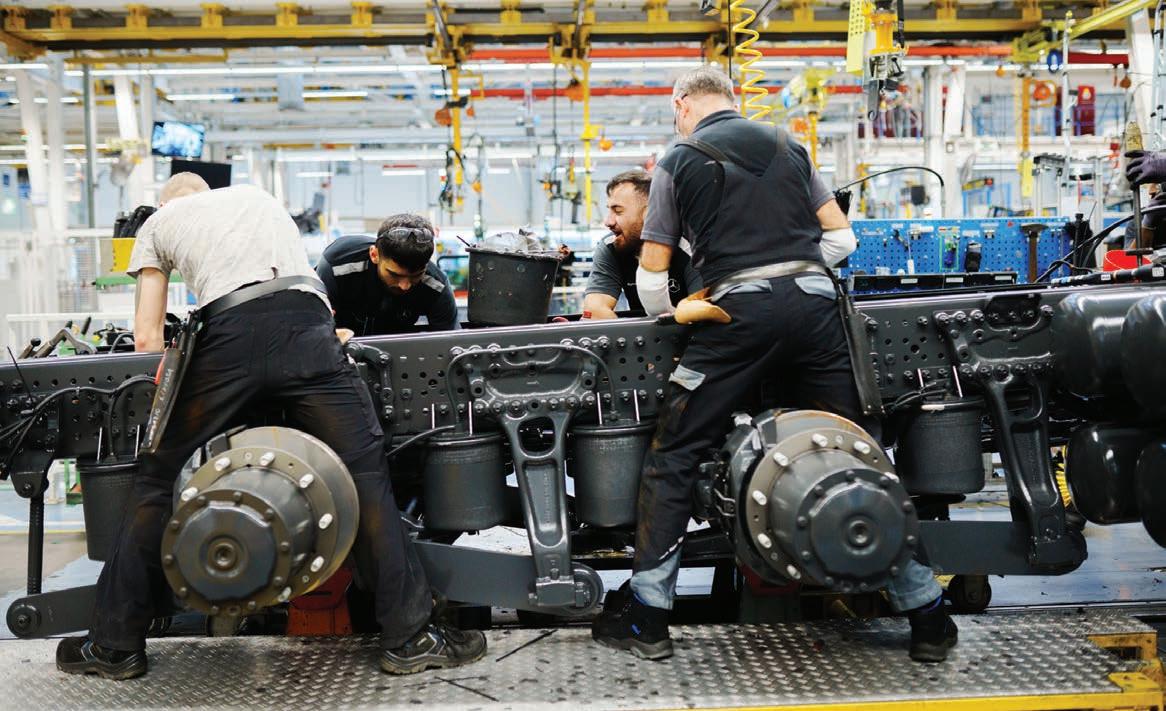
absence of any human workers was noticeable until the tour guide explained that it was the morning tea break, something that robots don’t require. Cathodic immersion priming is the term given to the dunking and rotating of complete cabs in huge tanks of primer paint. The cabin and the paint are given
opposing ionic electrical charges, so they are literally attracted to each other. Once the primer is dry the topcoats are applied using a robotic spray system with a similar opposing electrical charge system that is so ef cient only four litres of paint is required per cab. MercedesBenz offers a selection of up to 450
different colours including 40 shades of blue which allows eets to have their corporate colours applied at the factory. Once welded together and painted each cab is checked for accuracy by cameras using 150 reference points. Should a deviation from speci cations be identi ed it is recti ed and then

subjected to a further check using lasers scanning 1,000 attributes.
The frame assembly line is one kilometre long and each chassis is pre-marked by lasers so the workers can identify the exact locations where various components are to be mounted, and the markings even determine which bolts are used in the multiple of predrilled holes.
The engines are manufactured at the Mercedes-Benz engine plant 60 kilometres away in the city of Mannheim. The drivelines meet the chassis in what is called the ‘Engagement Station’ and the relationship theme is continued at the ‘Wedding Station’ where the cabs are tted to the now-complete chassis. As the future for Daimler Trucks is committed to include electri ed transport, the company launched the new TruckCharge
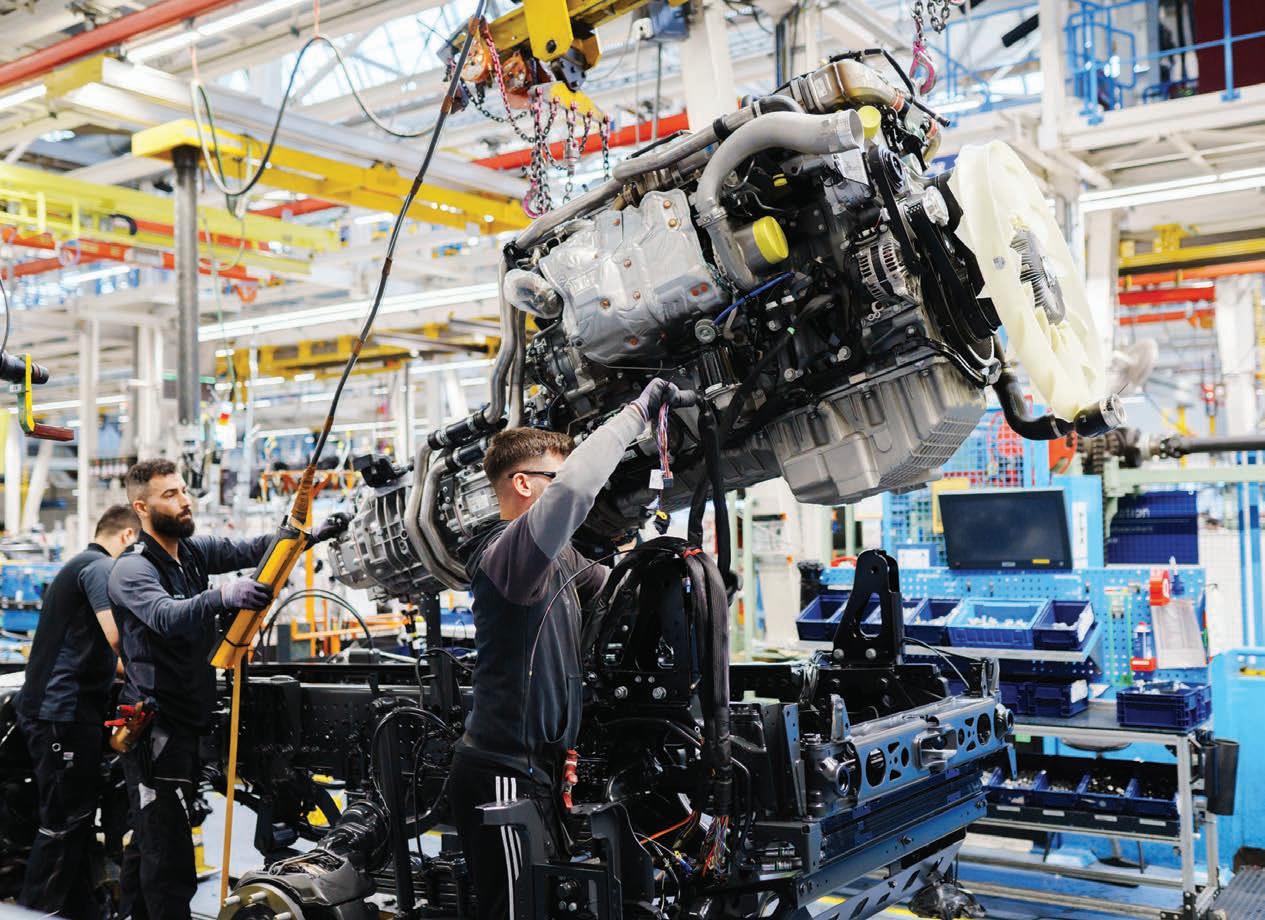
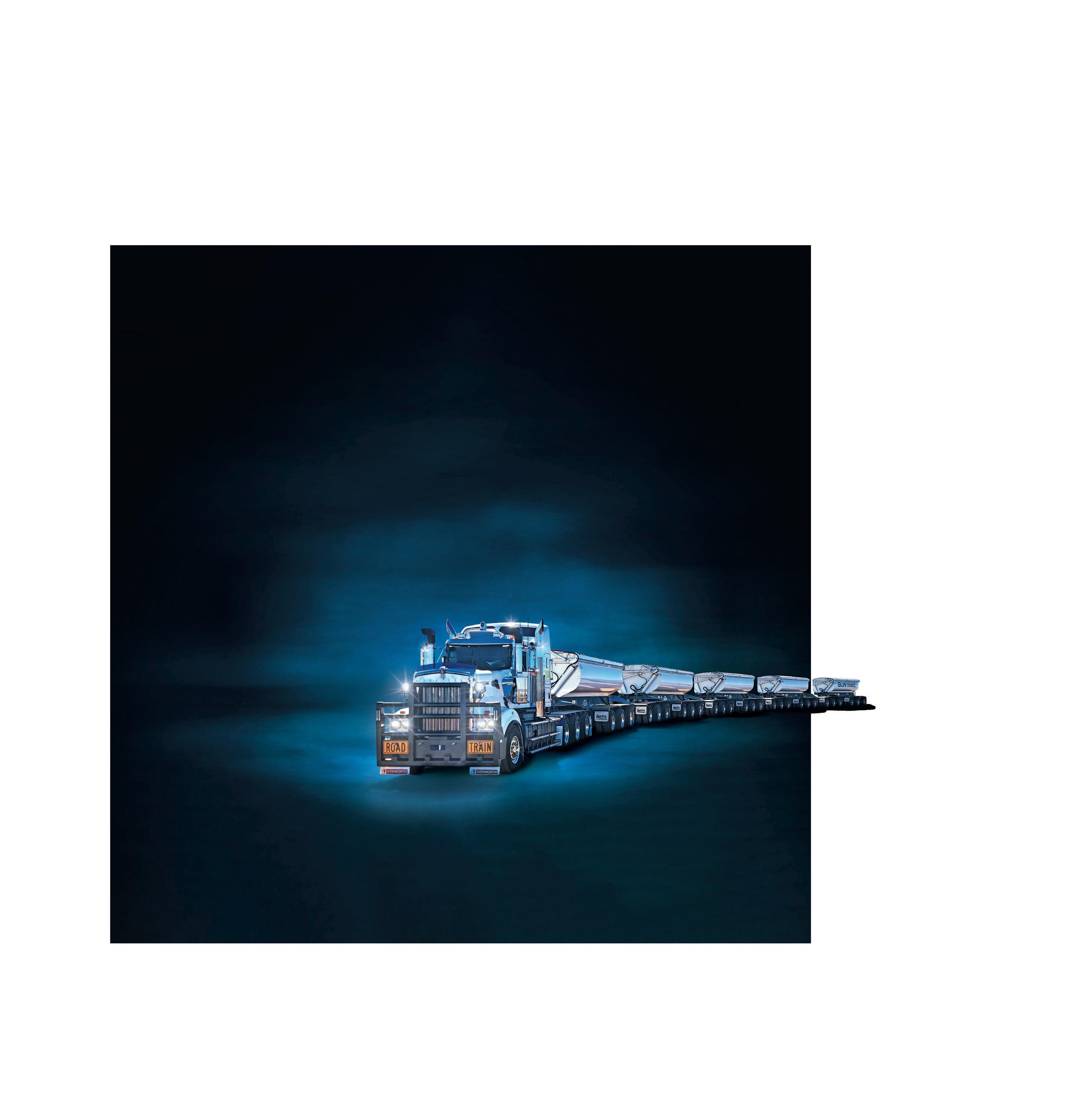
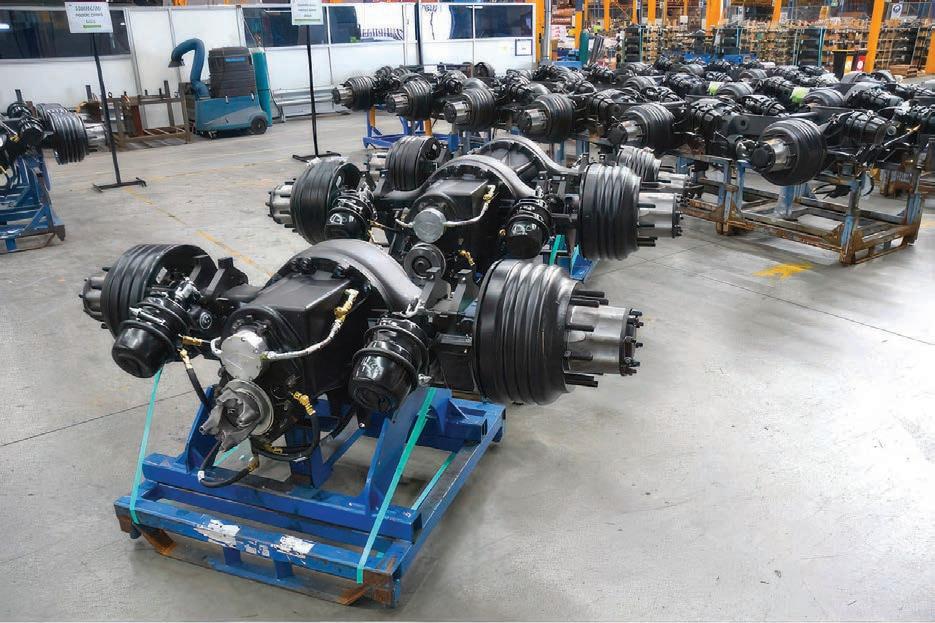


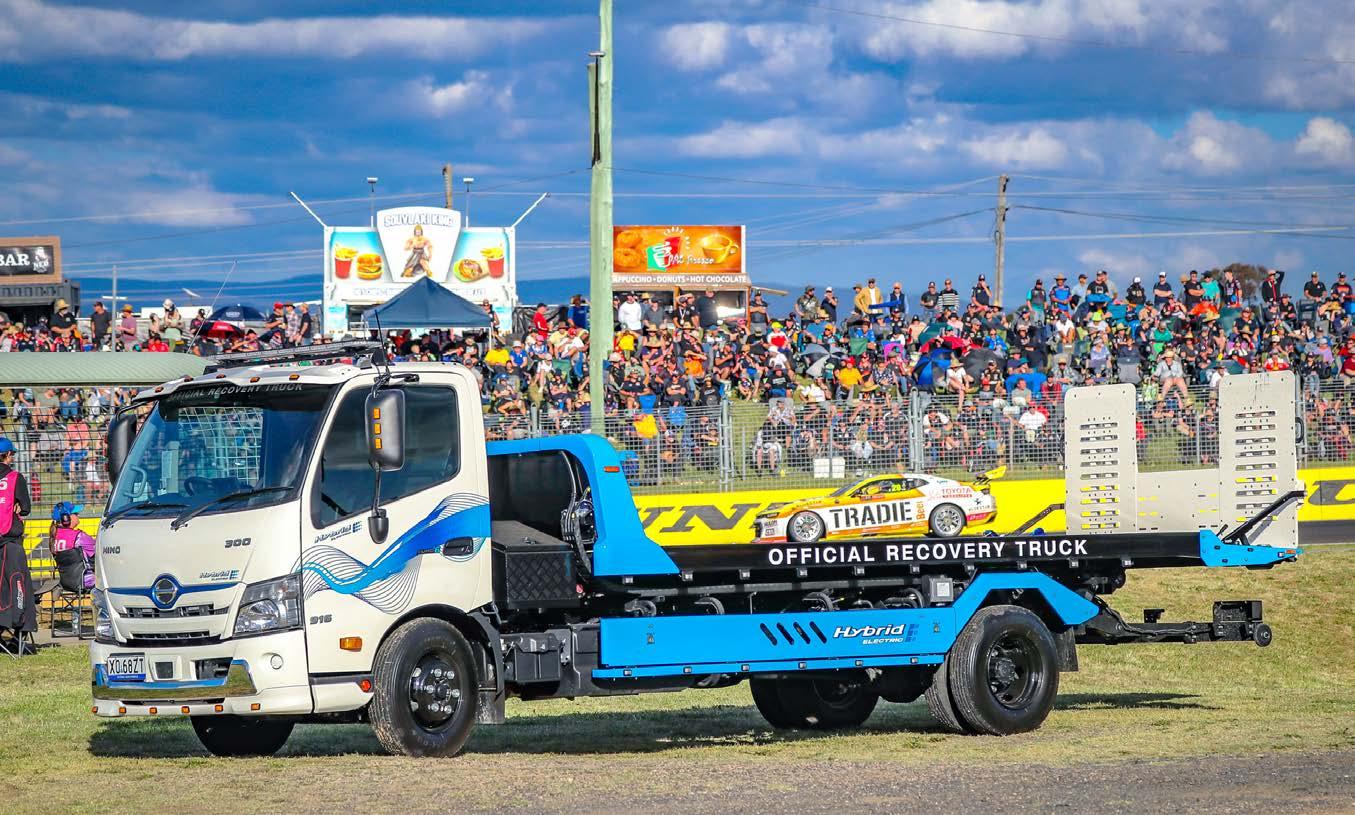
This Hino 300 Series Hybrid Electric truck demonstrates another application suitable for this type of lower emission technology.
Hino has a long-standing relationship with Supercars racing in Australia involving a suite of Hino-themed features such as the informative ‘Hino Hub’ which looks at the technology of the race cars and the impressive Hino Sports Deck semitrailer which transforms into a mobile hospitality suite and viewing platform at the touch of just a few buttons. Hino tilt tray recovery vehicles are also a part of the Supercars scene, clearing away the damaged race cars following the inevitable “shunts” which occur in high speed racing.
The 2024 Bathurst 1000 saw the debut of a Hino 300 Series Hybrid Electric recovery vehicle equipped with a unique Kyokuto single car tilt tray body which has been engineered to provide a loading angle of essentially zero degrees. This is important
for permitting easy removal of low ground clearance race cars, particularly after they have been involved in a crash resulting in damaged wheels and de ated tyres. The zero-angle feature is also applicable to non-racing applications when modern passenger cars need to be towed for any reason, including post-crash or mechanical issues.
One of the many bene ts of the Kyokuto tilt slide tray is once it is on the ground, loading the damaged vehicle and securing restraint equipment can happen at ground level, eliminating the risk of an operator falling from the height of a conventional tilt tray truck. The slide tray mechanism is operated by a single button remote control, which allows the operator to keep safely well away from the mechanicals of the truck.
The underpinnings of this particular truck
is the wide cab Hino 916 Hybrid Electric with a 3.9 metre wheelbase and a GVM of 8500kgs. The four cylinder diesel engine produces 150hp (110kW) and 470Nm of torque. In combination with the 35kW electric motor the maximum torque is available from as low as 1,000rpm. The electric drive motor is located between the diesel engine and the six-speed automated manual transmission. The hybrid system operates by continuously seeking to supplement the diesel power delivery by feeding electric power into the driveline, and the truck is constantly transitioning between diesel engine drive only, a combination of both electric motor and diesel engine drive, and can also utilise electric drive only during certain low load take-off situations.
The transmission has a relatively wide spread between ratios, taking advantage of
the available torque when accelerating, and maximising the rate of battery recharging when decelerating. The hybrid driveline management system ensures the diesel spends plenty of time in the green band shown on the dash as the electric motor supplements the power delivery. Take off and shifting are remarkably smooth.
The “retarder” wand is located on the steering column in the same position where the exhaust brake control would be on a diesel-powered Hino and produces a similar auxiliary braking effect in slowing the truck by increasing the electrical resistance on the driveline, harnessing the otherwise wasted kinetic energy and adding to the charge of the battery. A driver can in uence considerable in uence on the rate of battery charging by the use of this feature.
The Hino Hybrid Electric also features an engine stop-start system which all but eliminates engine idling time and allows the operation of the electro-hydraulic tilt tray mechanism to take place without the need for the diesel engine to be running.
This becomes a major contributor to the improvement in fuel consumption by eliminating engine idle time and creates a potential saving of up to 5.1 tonnes
of CO2 emissions and over $4,000 per annum in fuel savings per truck.
In addition to direct operational savings the Hino Hybrid brings with it a reduction in maintenance costs as the electric motor replaces the diesel engine’s starter motor and alternator, while regenerative braking recharges the batteries and extends the operational lives of braking components such as disc rotors and pads.
The reduced fuel consumption afforded by the hybrid system means a smaller 80-litre fuel tank in place of the 100-litre unit used by equivalent diesel-only Hino 300 Series trucks.
As in all Hino 300 Series 4x2 models, the Hybrid models features Hino SmartSafe, Hino’s comprehensive safety package which includes a Pre-Collision System (PCS) with Autonomous Emergency Braking (AEB), Pedestrian Detection (PD) and Lane Departure Warning System (LDWS).
This is in addition to Vehicle Stability Control (VSC), reverse camera, dual SRS airbags, four-wheel disc brakes, UN ECE R-29 cab strength certi ed and the Easy-Start to prevent rolling back on hill starts by holding the brakes until the accelerator is depressed. With the Hino
Hybrid Electric operators can reduce their running costs and improve fuel ef ciency immediately, as well as reducing emissions. There are no operational restrictions that would not be inherent to a conventional diesel truck. As the Hino Hybrid Electric is essentially selfcharging and doesn’t require connection to a charger drawing from the electricity grid, the scope of its operation is wide in a geographical sense. It only needs to have the diesel tank topped up. This particularly suits the Supercars application as the requirement for a recovery vehicle can vary from race to race, as demonstrated at Bathurst which in 2024 only had one safety car period. The recovery trucks need to be on standby and ready to get out on the circuit at very short notice, a situation which doesn’t suit an all-electric vehicle which would require monitoring of the charge levels and time could be lost in disconnecting from the charging outlet.
Now after 15 years in Australia, the Hino Hybrid Electric truck range is built around what can now be certainly considered mature technology, and this recovery truck example shows yet another application to which hybrid vehicles are well suited.
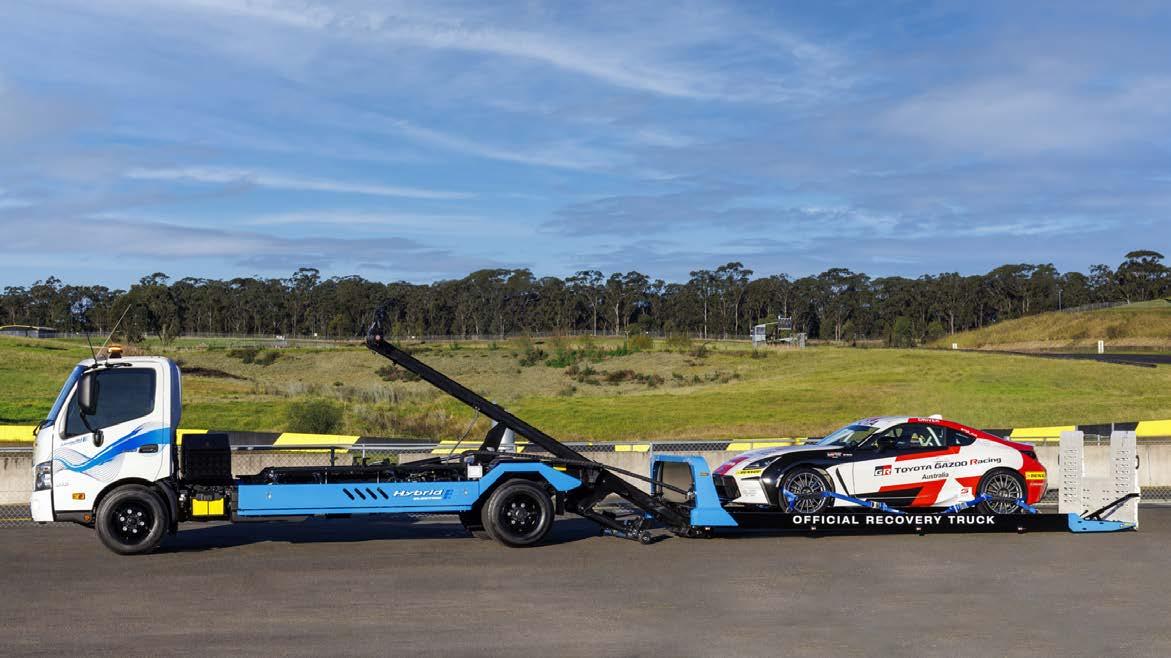
Isuzu is launching a generational change across its entire truck line up for Australia.
Isuzu has held the lead position in Australian truck sales for 36 years and has shown it isn’t resting on its record by announcing during late 2024 that the year 2025 will witness the biggest launch in Isuzu’s history with new models, new drivelines, new cabs and interior appointments, and a class-leading focus on safety. Isuzu’s most recent comprehensive model launch was back in 2008.
A critical element across the entire range of the Model Year 2025 (MY25) offering is Isuzu’s rst-in-class suite of safety features which will signi cantly enhance active, passive and driver-assist safety functions, several of which go signi cantly beyond the requirements of the impending Australian Design Rules (ADRs) including ADR35/07 which mandates Electronic Stability Control (ESC) on all new heavy vehicles from 1 February 2025 and ADR97/00 which requires Advanced Emergency Braking (AEB) for those vehicles from the same date.
Many of Isuzu’s current Australian models in the N, F and FX-FY Series already employ a range of safety features and driver ergonomic bene ts, and the new range takes the overall concept of truck safety to a higher level, underpinned by a new advanced electrical architecture. Additional safety features will include Full Speed Adaptive Cruise Control (F-ACC) on all two-pedal models, Miss Acceleration Mitigation (MAM) on selected models and Bi-LED headlamps with integrated Daytime Running Lamps (DRL). The MAM system reduces the chances of the vehicle colliding with objects either in front or at the rear if the accelerator is accidentally depressed from a stationary position. Isuzu Australia’s next generation products also deal directly with driver well-being with numerous comfort and

ergonomic improvements, starting with a new cabin structure which delivers a new-look exterior and a roomier, more accommodating interior space with enhanced appointments. Cabin strength has been increased including the addition of anti-intrusion beams. As well as conventional diesel engines, Isuzu will offer a broad carbon neutral line-up suitable for many applications which will include Internal Combustion Engines fuelled by CNG, LNG, hydrogen, HVO and biodiesels. Currently under test in Australia are examples of fully electric Isuzu NLR and NPR models.
The Isuzu strategy of increased safety across the new 2025 model line-up has the aim of reduced incidents and also reduced damage in the event that an accident is inevitable. Isuzu has drawn heavily from its The Future of Trucking (FoT) report data which at its core has a collective desire to have safer conditions for all road users, combined with a strong focus on truck occupant wellbeing. The FoT found
that alongside total cost of ownership equations, safety technology remains a major purchase consideration for many operators.
A three-factor approach to safety is being applied across the MY25 range with ‘Foundational’ safety relating to the ease of driving in relation to such factors as stability, visibility, driving position, and the exibility and comfort of operation. The driver focus will include addressing noise reduction, vibration and vehicle ride and handling. The ‘Active’ safety elements will cover driver vision support, blind spot reduction and reduced damage in the event of an accident, while ‘Passive’ safety relates to driver and passenger protection and other road user and pedestrian protection. The new Isuzu N Series also receives Traf c Sign Recognition (TSR) using stereo camera technology and combines this with an Intelligent Speed Limiter (ISL) function to assist the driver to stay within posted limits. Features such as these add to the “ute to truck” strategy which Isuzu has pursued successfully in Australia, particularly in relation to applications involving towing.
For Medium Duty applications, the MY25 Isuzu F Series also receives a comprehensive safety boost. In a substantial upgrade from previous systems, every model across the F Series range, including Isuzu’s 4x4 models, bene ts from a comprehensive baseline suite containing 12 active and passive systems, including the Auto Lighting System (ALS). Depending upon the application, some models come equipped with even more systems, such as a typical FV model variant, which receives a total of 17 active and passive safety features. Full Speed Adaptive Cruise Control (F-ACC) also nds its way into nearly every model in the F Series
range except 4x4 and manual transmission FRR and FSR models.
At the heavier end of Isuzu’s all-new line-up, the FX-FY Series also receives additional safety related features. As per ADR regulations, all models now come tted with Electronic Stability Control (ESC), and the addition of F-ACC in this weight range, across all models, offers a host of important safety actions for highway and metropolitan driving. The addition of the Lane Keep Assist (LKA) to this market segment, is a boon for eet customers mindful not only of driver and road user safety, but of compliance obligations as well.
The Isuzu MY25 cabs have been designed to signi cantly improve overall safety, dimensions, visibility and storage with a smart, new-look exterior and a roomier, more accommodating interior space, ensuring operators have an ergonomic, comfortable and safe environment in which to work. Driver seating has been closely considered to reduce fatigue, with Isuzu’s new suspension seating added to a large selection of the range as standard. Isuzu claims the new driver’s seating will be noticeably more comfortable, and driver positioning has been optimised to be more car-like, accommodating greater visibility, easier access to driver controls including stalks and other dash functions. Impact absorption is enhanced through the use of three-piece resin bumpers and front panels which are more pedestrian friendly while reducing repair costs. To further minimise the incidence of pedestrian and cyclist injuries Isuzu has eliminated protruding windscreen washer nozzles and equipped MY25 models with “wet wipers” which have the cleaning uid applied directly to the wiper blades. Even the pedal layout has received a
rethink and Isuzu’s new smaller steering wheel has been further enhanced using electric actuators for advanced driver support functions and ease of use, and it’s also been optimised to work seamlessly alongside on-board safety technology such as Isuzu’s Advanced Driver Safety System (ADAS), audio prompts and hands-free functions via the in-dash multimedia unit. Further safety functionality is available via a new seven-inch, easy to see, meter cluster display screen located directly in the line of sight of the driver positioned in between the traditional speedometer and tachometer needles which oversees a range of ADAS related safety controls as well as vital trip, range and economy intelligence. Included in the MY25 cab changes is a revised glass speci cation, again with
driver comfort, safety and well-being rmly in mind. A huge 99 per cent reduction in ultra-violet (UV) and a 59 per cent reduction in infra-red (IR) cut-through has been achieved, helping to dramatically enhance visibility, prevent sunburn, and retina damage and markedly improve cabin insulation, taking pressure of the HVAC system.
A replacement for the Heavy Duty Isuzu Giga model is still a “year or two away” according to Isuzu Australia Limited Director and Chief Operating Of cer Andrew Harbison, and speculation is the truck will be a rebadged UD with a 13-litre engine.
The new range of Isuzu trucks is scheduled for its public launch at the Brisbane Truck Show in May.
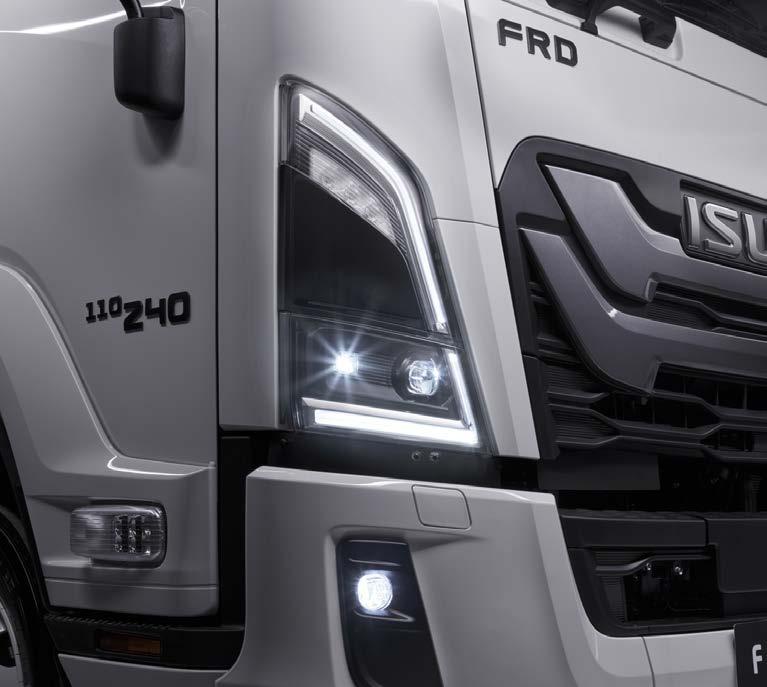
Gilbarco Veeder-Root’s fuel management technologies unlock the power of integrated energy and asset management.
Since 1929, Gilbarco VeederRoot has been a pioneering force in the fuelling industry, consistently blending tradition with innovation. Originally from the United States, the company expanded to Australia and, in 2002, adopted the name Gilbarco Veeder-Root as part of the Vontier Corporation, a global leader in mobility and sustainability.
Central to Gilbarco Veeder-Root’s offerings is the promise of real-time
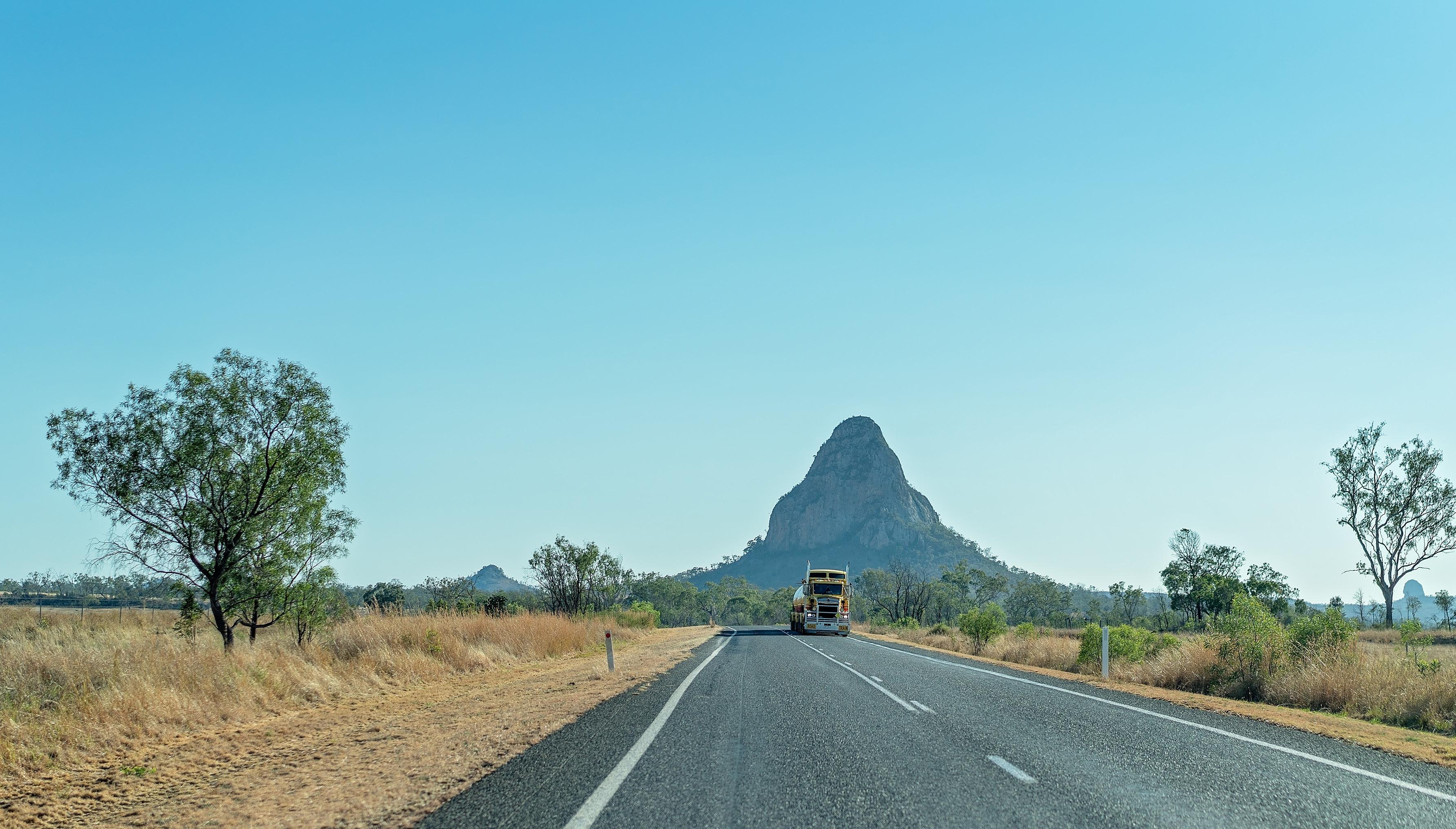
visibility and control. Their Energy and Asset Management Solutions allow businesses to track fuel and assets seamlessly, from receipt to storage and dispensing—all from a centralised hub. Luke Dorn, Gilbarco Australia’s Commercial and Industrial Manager explains.
“This comprehensive approach equips managers with the tools they need to optimise distribution, monitor fuel levels, and ensure compliance,” he says.
Energy and Asset management are facilitated through Gilbarco’s hardware and software tools. Physical probes as well as wireless radio-frequency identi cation (RFID) tags relay crucial information from the vehicles to Gilbarco’s proprietary tracking software. Customers can then comprehensively view their fuel data and make necessary changes to dispensation across a eet or site. Built for resilience, the equipment is designed to withstand harsh natural
environments, ensuring peace of mind. These solutions also enable businesses to optimise fuel tax credits by utilising automated and accurate GPS tracking data. This results in signi cant time savings and considerable nancial bene ts, which are particularly advantageous in the current economic downturn.
Enhanced visibility, security, and asset performance are other key bene ts. Realtime monitoring of the fuel supply chain, combined with centralised and remoteenabled dashboard access, enables datadriven decisions from almost anywhere.
“Our solutions give businesses the con dence to make informed decisions, reduce losses, and optimise asset performance in real-time,” says Luke.
The scalability of Gilbarco’s services is also a major point of distinction.
Dorn and his team work closely with customers to ensure they receive the best possible solution for their business
“Our solutions give businesses the con dence to make informed decisions, reduce losses, and optimise asset performance in real-time.”
Luke Dorn Gilbarco Australia’s Commercial and Industrial Manager

by offering a range of options that are modular and scalable according to customer needs. As the original equipment manufacturers of all products within their system, they provide customers with unparallelled integration and exibility in their choices for energy and asset management.
Without a system like Gilbarco’s, customers often endure manual data entry that is prone to errors and consumes additional time and resources.
“With Gilbarco’s solutions, this isn’t the case,” says Luke. “By reducing the time spent on manual tasks, our customers
can focus their energy on achieving their primary business goals. Our experience has shown remarkable customer ef ciency improvements that have translated to signi cant cost savings and streamlined processes.”
With these robust energy and asset management solutions, Gilbarco is leading a transformative shift in how businesses approach their eet and logistics management. By integrating advanced technology with a focus on ef ciency, compliance, and performance, the company aims to rede ne the industry into this new era.
MTData has provided telematics devices to truck eets for over 20 years. Today, the company’s newest product, the 7000AI, adds high quality fatigue and distraction detection to its comprehensive tracking and compliance capabilities.
Since 2003, MTData has catered to a wide variety of transport tracking and compliance needs for many customers in the industry — developing a product range that has only grown in the intervening years. Starting with a basic GPS tracking device, the company expanded to offer CANBus engine interfaces, G-Force Sensors and other products. In the following years, MTData developed further technology designed to tackle fatigue and speed management among drivers and implemented this telematics equipment for much of Australia’s taxi services. This momentum was continued with the development of personnel tracking device units for police forces, security, and precision farming companies.
Launched last year, the 7000AI is the latest of MTData’s technology and has the potential to transform the industry with its all-in-one design, uniting GPS telematics and compliance, Digital Video Recording from up to eight cameras, and highquality fatigue and distraction detection, with further capability to be developed over time.
According to MTData Chief Operating Of cer, Ben Ditfort, while these technologies all individually exist, the 7000AI’s uni cation of them is unprecedented in the market.
“There’s technology like this on the market right now, from other vendors,” he says. “What we’ve done is bring them all into a single platform for customers to use and log into. Before, they would have had to buy a telematics system from us, and then additional technology from other places.
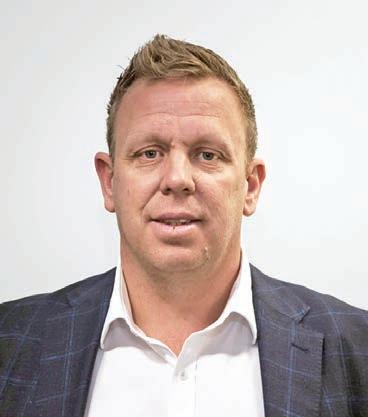
Now, we’ve created a single service which simpli es the process for the customer.”
Fully developed in-house, the 7000AI’s technological capabilities provide streamlined communication between eet managers and truck drivers while drivers are on the road. In addition to being able to access relevant diagnostics on each transport vehicle, managers are able to communicate critical information to the telematics system for drivers through the driver facing application which is presented to them on a screen installed into each truck cab. The system’s text-tospeech feature reads out this information to drivers to prevent them from taking their eyes off the road.
“Our in-cab driver app is an all-around safety, compliance and driver utilisation platform which controls messaging to drivers when they need some feedback, comments or any correction,” Ben says. “We want drivers to use this technology with ease. What they don’t want is to
be jumping in and out of multiple apps while they’re trying to do their job. We’ve provided a tool for work instructions and feedback and insight into driver behaviour all on the one app to make those conversations logistically easier for everyone.”
Where the 7000AI really impresses is safety. MTData’s new system is equipped with safety measures speci cally designed to reduce the risk of driver fatigue –also known as driver drowsiness – and distractions during long transport journeys in hazardous conditions.
Cameras in the truck cab which are linked to the 7000AI, monitor drivers and detect eye movements and posture changes indicative of either fatigue or distraction. This will prompt the text-to-speech feature to inform the driver. A device in the driver’s seat will also begin to vibrate, either waking them up or refocusing their attention. According to Ben, it is key for this technology to notice this behaviour in a pre-emptive manner.
“Our technology tries to pick up a driver’s normal conditions while driving in order to then pick up behaviour which is different from that as a safety risk,” he says.
“Maybe a driver’s eyes are slightly closing, and our technology will pick up on that before their eyes close fully to prevent any accidents. We want to detect these behaviours before they fully occur and alert the driver through various mechanisms, so that they can pull over and get the rest they may need.”
As far as distractions go, Ben notes mobile phone use is prevalent on the roads.
“The consequences of a crash are much
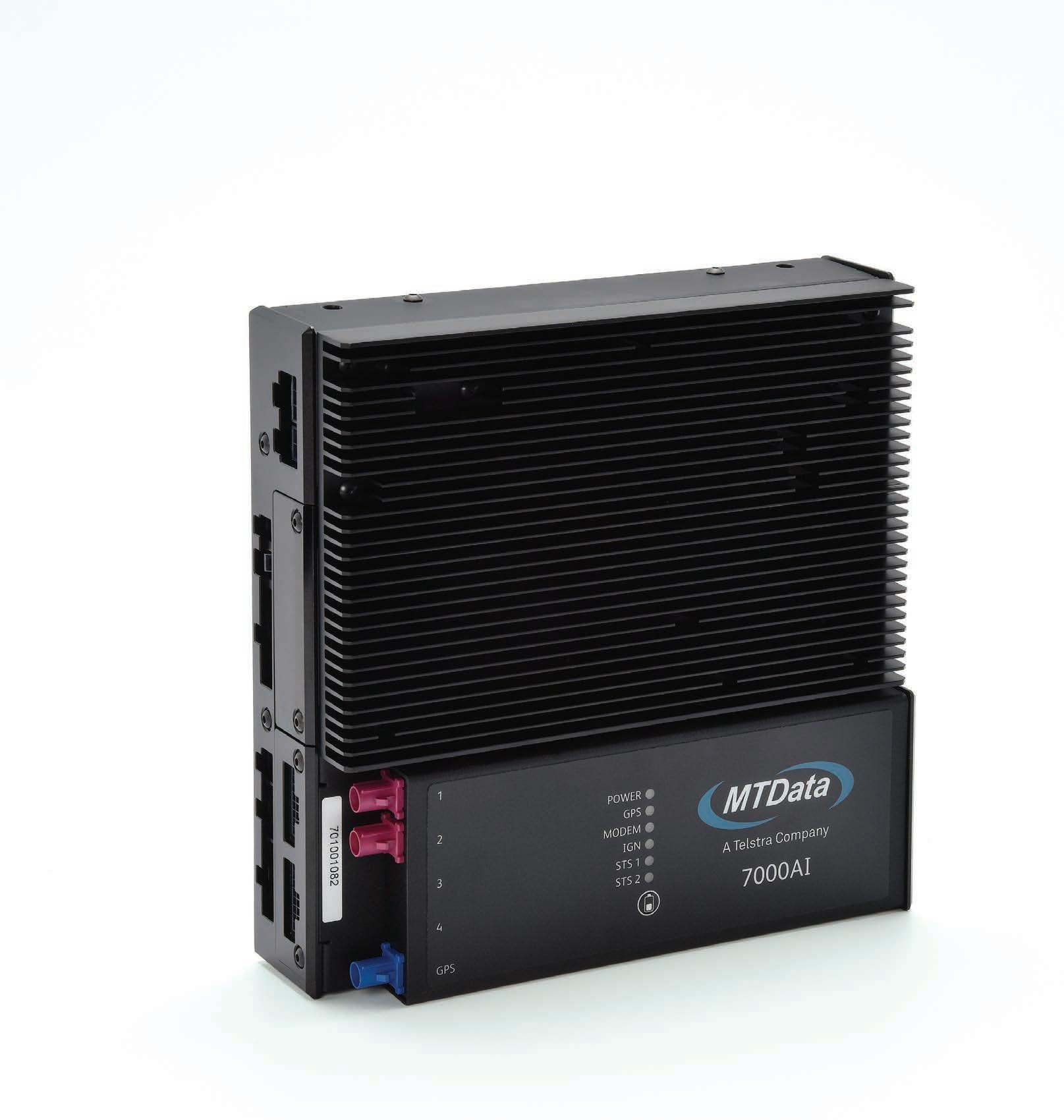
more severe with a truck than with a car, so that is something our system is de nitely looking to minimise,” he says.
These mechanisms featured in the 7000AI’s system will improve safety and ef ciency within truck eets by directly communicating reports of driver drowsiness or driver distraction to eet managers and operators.
This real-time reporting enables eet managers to have more direct conversations with drivers about their performance and provides managers a unique opportunity to alter transport routes and driver teams in a way that
strengthens the eet’s overall performance.
While the 7000AI’s all-in-one value proposition consolidates various data tracking for eet managers and truck drivers, the telematics market is experiencing increased competition in the form of trucking manufacturers developing their own data-tracking tools. In the wake of this crowding, Ben is con dent in MTData’s ability to continue innovating.
“Some of the OEMs provide their own platforms, but not one of those providers has a eet made up of one type of vehicle,” he says. “Most companies run eets made of multiple truck brands, so they cannot
run platforms across those different vehicles. It’s up to telematics providers, like MTData, to connect many vehicle types and ensure we can alert eets of safety concerns.”

MTData’s 7000AI system has combined existing telematics and safety technologies to provide an all-encompassing platform of pertinent eet information for eet managers and drivers alike. Armed with reports on driver drowsiness, driver distraction, truck diagnostics and an open line of communication, the planning and performance of truck eets has been made much more intuitive.
Fleets can now optimise with the Haulmax Ecosystem, a leading tyre, support, and technology solution for safer, smarter, and more e cient transport operations.
In the fast-paced world of transport and logistics, operational ef ciency and safety are essential. Haulmax Tyres has long been a trusted partner for Australian transport operators, delivering Australian engineered tyres that perform in the harshest conditions. After all, Haulmax is much more than just tyres. It’s evolved to become an ecosystem designed to transform how trucking eets can be managed.
At the heart of the Haulmax ecosystem is their range of tyres. Purpose-built for Australian transport routes, cargo types, and road surfaces, the application speci c engineering means they deliver durability and ef ciency. Haulmax Tyres can provide solutions for eets of any size in all applications. Through its Lifetime Warranty and CPK Guarantees, and 24/7 Australia wide service, Haulmax prides itself on not just performance but value and optimum outcomes for its customers.
“At Haulmax Tyres, we innovate to meet the unique demands of Australian transport,” says Daniel Sapsead, National Marketing & Communications Manager at Australian Tyre Traders. “Our tyres, services, and technology are tailored for local loads, roads, and climates. Backed by eld testing and data, our Australian engineers deliver exceptional outcomes, like the Haulmax ATT105-Pilbara, a trailer tyre designed speci cally for, and excelling in speci c applications and operations.”
Haulmax Wingman is the largest commercial tyre supply and support network in Australia, with over 550
Haulmax Wingman partners. This expansive program offers tailored, national solutions for transport operators, ensuring comprehensive support wherever the eet operates.
From multi-depot service programs to mining and haulage support, Haulmax Wingman provides industry-leading outcomes, account management, and the con dence to make informed decisions about tyre spend.
Haulmax tyres in a port cartage application.
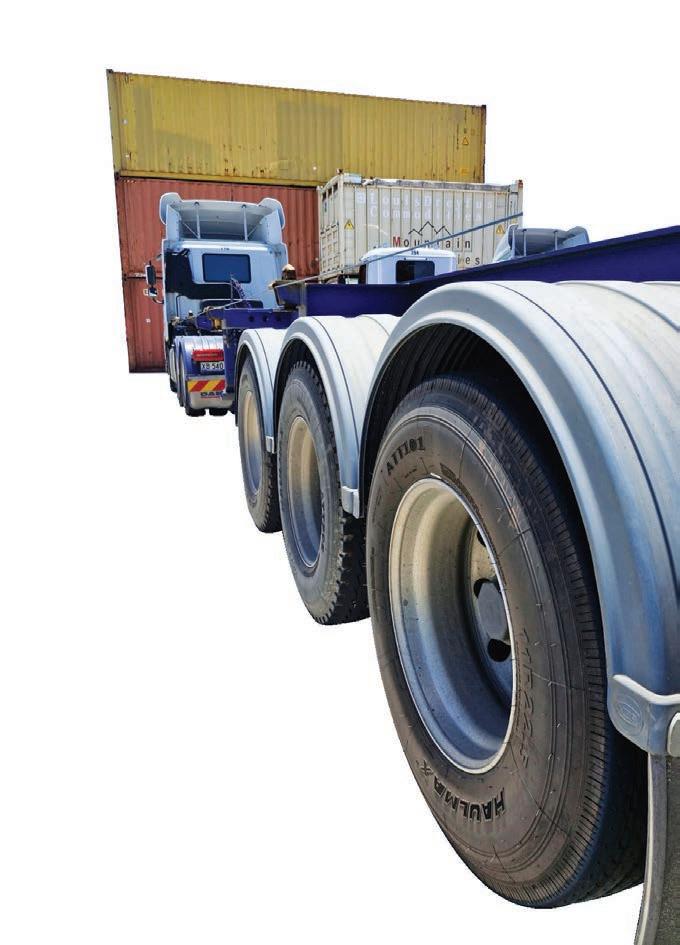
The latest addition to the Haulmax ecosystem, Haulmax Tech Solutions, is a cutting-edge eet management platform designed for Australian eets. It’s much more than a tyre pressure monitoring system according to Daniel.
“It’s a comprehensive solution empowering eet operators with realtime insights into tyre performance, safety alerts, and GPS tracking,” he says.
Among the bene ts Haulmax Tech Solutions offers eets is enhanced safety. These include proactive alerts for wheel loss, hub temperatures, and tyre pressure. In addition to this, eets will be able to optimise their ef ciencies. Extended tyre life and improved fuel economy will increase the nancial and operational ef ciency transport and logistics businesses demand.
Early issue detection will minimise downtime by encouraging proactive maintenance; and real-time tracking gives full eet visibility, even when vehicles are unpowered.
The Haulmax Ecosystem is an easy choice for eets trying to get ahead according to Daniel.
“Australian eets face increasing pressures
to minimise costs, reduce emissions, and enhance safety,” he says. “The Haulmax Ecosystem directly addresses these challenges, combining innovative tyres, national service and solutions, and cuttingedge technology.”
By integrating Haulmax Tyres, Haulmax Wingman, and Haulmax Tech Solutions, transport businesses will be able to improve operations and achieve valuable longterm outcomes according to Paul Vawdrey, Vawdrey Australia’s Director. When asked which of his customers use Haulmax Tyres, his response: “The smart ones.”
As an Australian family-owned company that prioritises eet needs and outcomes, Haulmax is positioning itself in the market as a long-term partner, not just a product.
“Whether it’s improving tyre performance, reducing downtime, or leveraging technology for smarter eet management, the Haulmax Ecosystem is here to listen to customer needs and deliver value,” says Daniel.
Speak to your local Haulmax Tyres partner, vehicle manufacturer/trailer builder or contact Haulmax today on 1300 761 802. To learn more about the Haulmax Ecosystem visit haulmaxtyres.com.au.
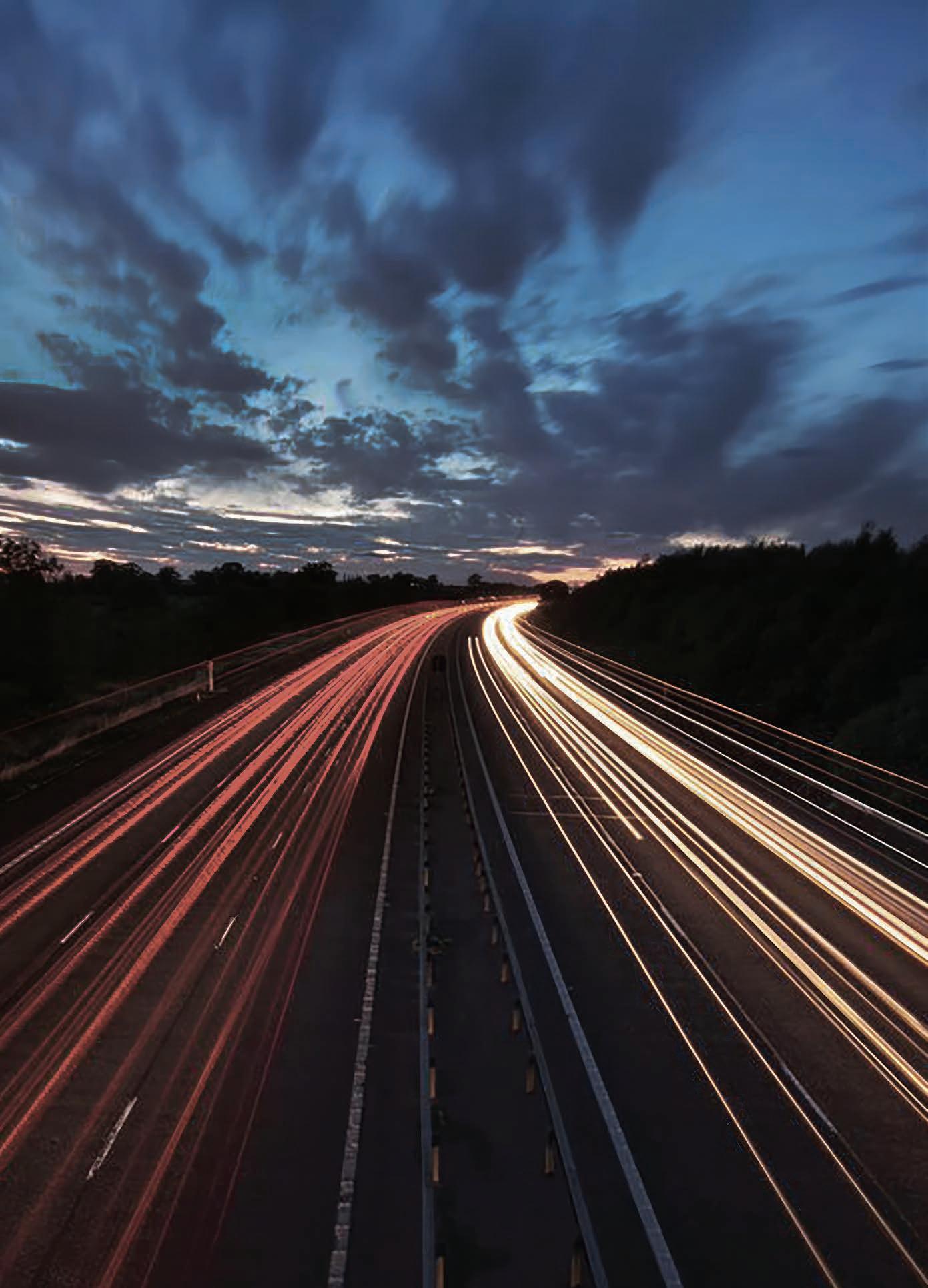


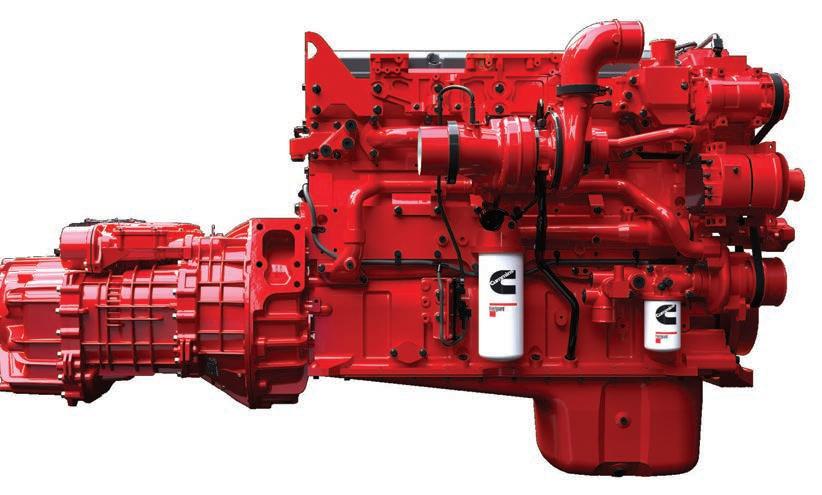
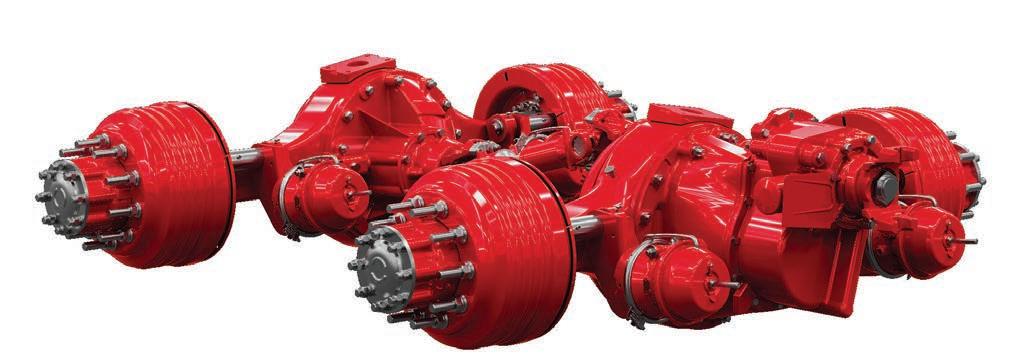
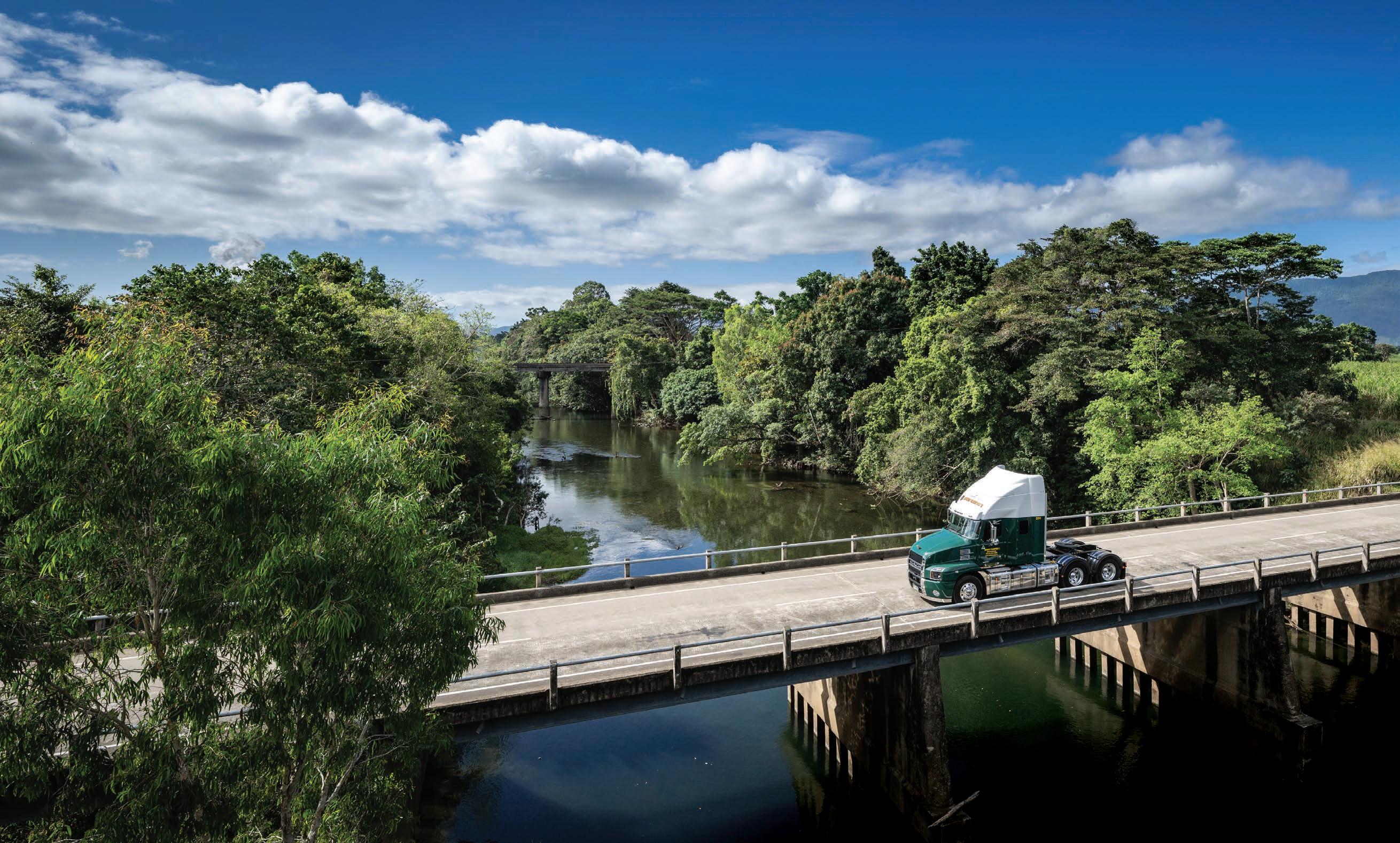


The latest instalment of the annual Haulmax Premier Commercial Fleet Guide expands the categories to help provide a better overview of the movers and shakers in road transport in Australia.
Companies will come and go. That is hardly news. In any business environment the growth of the few will come at the expense of the many. As global economies course correct to the in ationary environments of cashstrapped governments doubling down on their willingness to print money, top up depleted treasuries by importing a new tax base, precipitating overburdened infrastructure and the destabilisation of energy sources in which businesses and manufacturing, and businesses dependent on manufacturing, rely, each new economic headwind can have cyclonic effect to the point any semblance of how a company might have once outcompeted others at the edge of the market in a niche space, cultivated, in some cases, for decades, will invite overtures from corporates looking to expeditiously consolidate around areas new to them even if they are the bread and butter of others. Now comes the opportunity for any legacy independent businesses, no matter how many generations they have been in the family, to better understand if theirs is the same appetite that originally built the operation from the ground up. On the lower rungs, where the margins are so thin, production has ceased on oily rags. Strategic growth via acquisition is the increasingly widespread dialectic in boosting revenue in a soft market of diminishing returns. It’s one avenue, as recent years have borne out, for eets to bolster numbers when the external forces
of material shortages and delays in supply warrant containment.
Even so. Growth is a force imposed on the market. Like gravity there is little point in ghting it. Investment must buck austerity. Often the better option, when confronted with the reality of long-term viability, is to start again. Ron Finemore and perhaps a handful of others have been able to scale this mountain.
It’s not just trucking startups that have enjoyed the owing tap during the unreserved consumer demands of COVID who have entered a different domain and had to desperately reevaluate cash ow and capital. For some longstanding players it’s more a matter of getting the timing of an exit right when it becomes evident there is no longer a seat at the table.
Before Christmas Hawk Logistics announced it was going to acquire Newcastle carrier 91-year-old Farragher Logistics. It happened the same week Butler Freight bought out Coynes Freight Management, just one year short of its 75th anniversary. The equipment stocks of both buyers have naturally seen an immediate boost.
Silk Logistics, something of a gold standard for strategic acquisition in the industry, having increasingly modelled its own meteoric growth in recent years this way, was itself acquired by DP World or Saudia Arabia’s Australian branch of it — subject to a review by the ACCC.
Border Express itself purchased by Freight Management Holdings, a subsidiary of Singapore Post, has been adopted by a
new parent in Paci c Equity Partners, a Melbourne-based private equity rm. In late 2023, PEP acquired a majority stake in Australian electric vehicle charging solutions provider EVSE for $250 million. That the acquisition contains two of the biggest last mile eets in the country makes sense long-term in light of such an investment.
The horizon like the future can appear a long way off. Whether chasing a bigger slice of the pie or entering new markets as Flex Contract Logistics did via acquisition when it snapped up Lobethal Freightlines & LF Warehousing and Distribution in South Australia, this time last year, the big pond isn’t getting any bigger despite there being just over 60,000 road freight transport companies in Australia, a rise of 2.4 per cent since the 2020 peak. The boom-bust cycle, in which brokers are drastically undercutting rates, is nothing new under the sun but in a synchronous debt accumulation super cycle, like the one underway, it’s much tougher being an independent player, especially one just starting out. Servicing debt in an economy
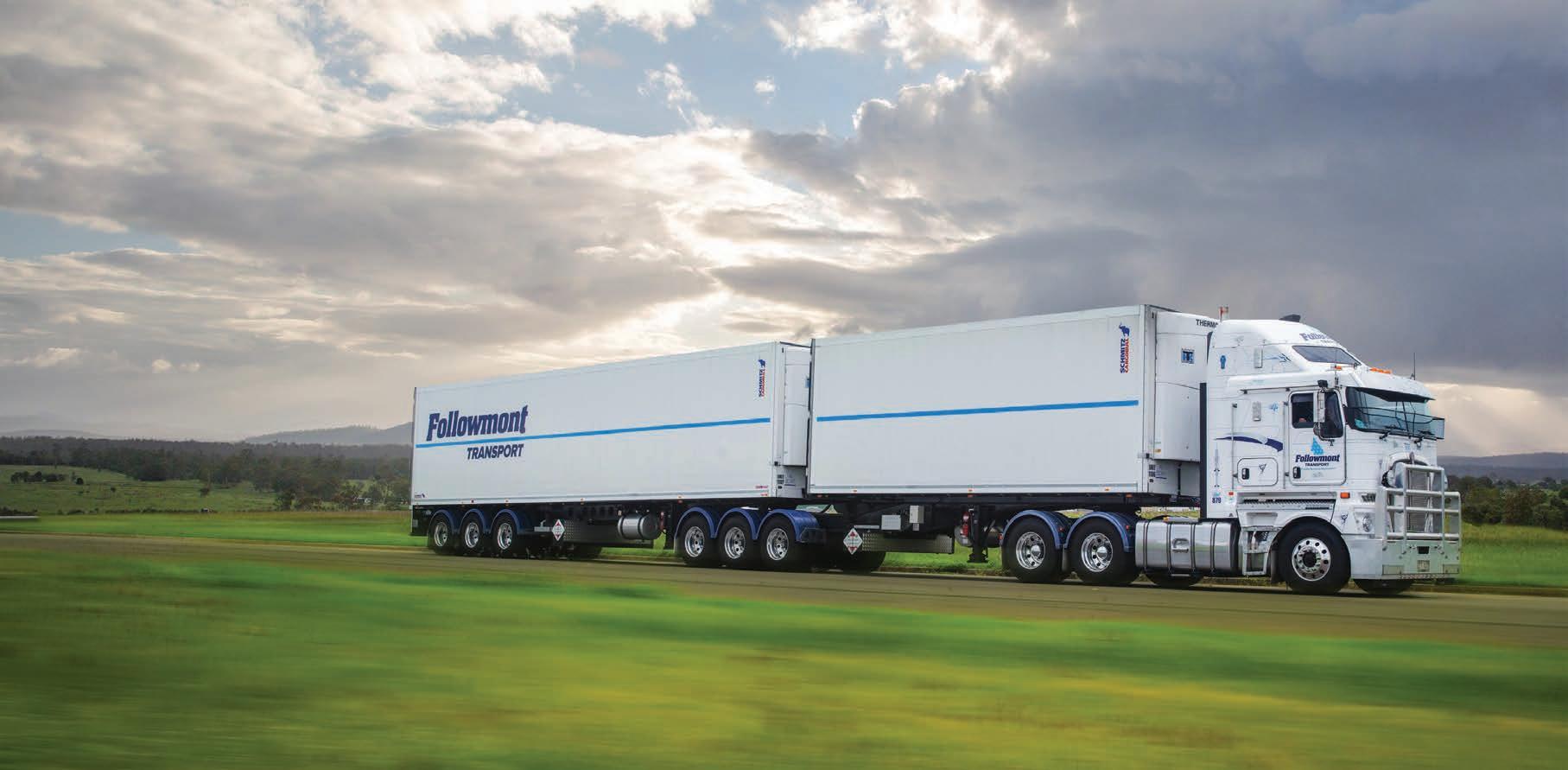

offset by heavily subsidized renewables is a tightwire act performed between the two World Trade Center buildings long after they are gone. The environment that welcomes new out ts is not for the faint of heart. Food demand is expected to increase by 50 per cent, energy demand by 50 per cent and water demand by 30 per cent over the next decade.
Not everything, however, contracts in the cold. The refrigerated transport segment is
currently estimated to be worth $8.41 billion. Growing at a compound annual rate of 3.73 per cent over the next ve years a Mordor Intelligence report forecasts the market will be valued at just over $10 billion. While the supply chain disruptions that affected 37 per cent of all businesses just two years ago, according to Australian Bureau of Statistics, are not nearly as confronting they do, hoewever, continue to persist.
Despite the rising challenges in the market, cold chain logistics is experiencing solid growth in Australia due to the surge in demand for food products, meat, pharmaceuticals, and other goods which require temperature requirement and endto-end delivery. By the rst quarter of last year the nation’s refrigerated warehouse capacity had increased to 10.2 million m³ up from 8.4 million m³ in 2020 according to CBRE data.

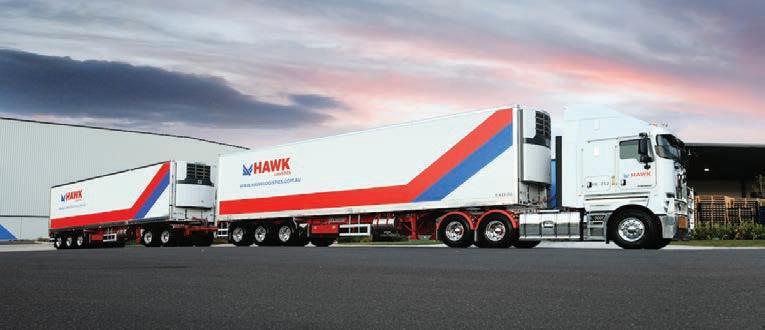
While the Truck Industry Council does not speci cally record sales by emission type, its gures for 2024 relay approximately 45 per cent of last year’s truck and van sales were ADR80/04 (Euro VI). The more drastic changes to eet composition, especially from internal combustion engines, are certainly underway albeit remain embryonic at this point in time. Sales of diesel/electric hybrid trucks, 0.36 per cent of the market, fell last year to 185 from 214 units in 2023.
Battery electric trucks, however, did improve considerably from 217 sales in 2023 compared to 272 in 2024, 0.53 per cent of the total market. Another trend continued unabated with the freight industry’s move away from Medium trucks into either smaller Light Duty trucks, or to larger Heavy trucks. The Q4 sales record for the category was set back in 2007.
TIC Chief Technical Of cer, Mark Hammond points to the rise in e-commerce that has resulted in an increase in rst mile and last mile deliveries and ongoing operator shortages affecting the
industry. He says greater demand for lightduty trucks and vans, most of which can be driven on a passenger vehicle licence rather than the truck licence that a medium-duty truck requires is a major factor.
“Larger medium-duty trucks are more dif cult to drive and park in a metro environment,” he says. “In the other
direction, better ef ciencies can be gained by moving freight on larger trucks like 3- and 4-axle rigid trucks and more semitrailer combinations around city and urban areas have seen operators move out of a smaller 4x2 medium-duty truck to these larger more freight ef cient trucks. A single driver moves a lot more freight in one of these larger heavy-duty trucks than he or she can in a medium-duty truck.”
Being an election year there will be high hopes that change might be wrought, at least economically, from having new gloves at the levers. Failing that, the current federal government has allocated, as part of its campaign, $9 billion for rehabilitating the Bruce Highway, that vast and crumbling 1,679-kilometre-long transport corridor, which hangs like a Sword of Damocles over the many carriers that use it and abuse it, vocally and justi ably. Major eets like
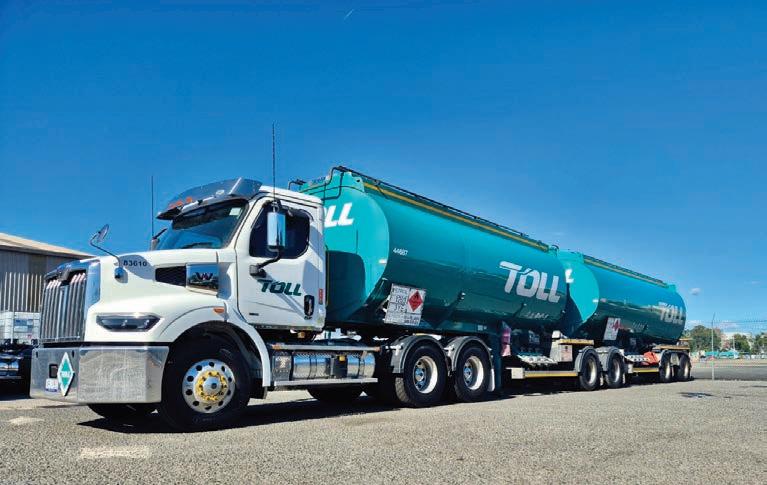

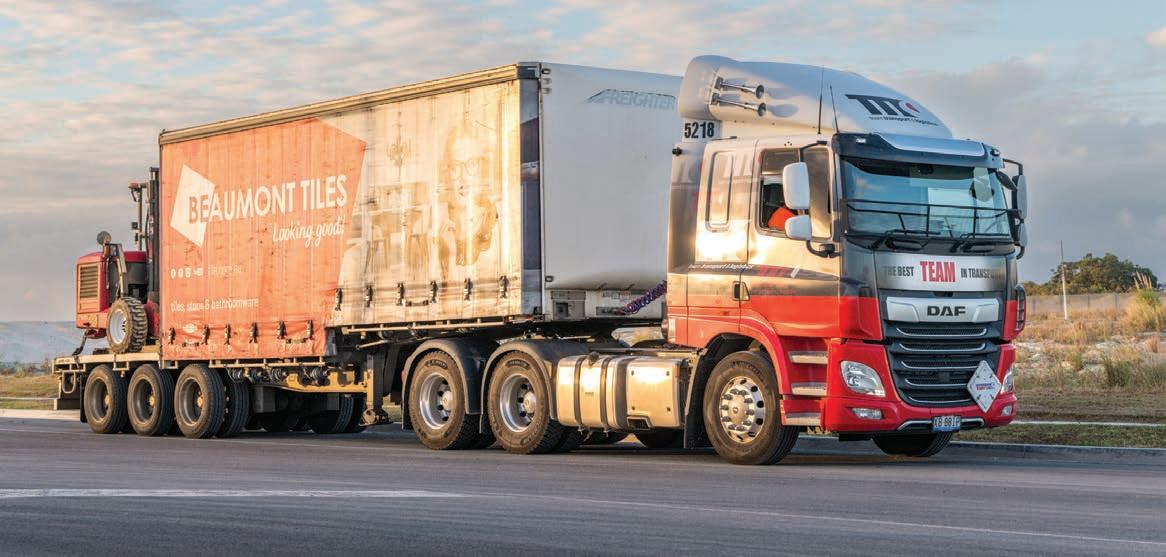
Followmont, Gilders, Lindsay Australia, Blenners, Toll, OzWide, Nolan’s, Simon National Carriers, Armestos Transport, a eet unbeknown to many that runs a eet of over 100 prime movers, Team Transport & Logistics and Richers, to name just a few are up and down the corridor daily. The $9 billion upgrades, should they go ahead, will offer long-term advantages for safety and ef ciency but with short-term pain as periodic disruptions accompany works that are undertaken.
Priority sections north of Gympie where the highway is still, inexplicably single carriage, will also incorporate channels like Maryborough to Benaraby, where general freight movements are high, Rockhampton to St Lawrence and Bowen to Townsville in which resources adjacent businesses have a big presence and Ingham to Innisfail, a
rich agriculture region that requires cold chain services.
For many general freight carriers and even other applications, 100 prime movers generally has proven to be the sweet spot for the ideal enterprise scale for business advantages that have provided opportunity to spread xed costs further, establish better-equipped maintenance facilities, while also allowing the business to compete for company-scale work, where larger uplifts, contingent to seasonal forces and market requirements are demanded. It will be interesting to see, as businesses caught in between the small and medium tier offerings, carefully undertake strategic downsizing and what impacts will eventuate on suppliers.
Increased costs and material shortages amid an environment producing a near-
insatiable hunger for new, expansive digital integration and automation, have forced the hand of many multinationals to make concessions when it comes collaboration especially with competitors. Partnership is the new leadership is something of a rallying cry for many manufacturers. It might also be the way forward in business if the businesses that make up the private sector are to have a dog in the ght going forward. Instead of having the dog wagged for them.
To paraphrase the advice passed down from a previous generation to Sheriff, Ed Bell, in No Country for Old Men, there was nothing to set a man’s mind at ease, like waking up in the morning and not having to decide who you were. That itself is a model of sustainability — ongoing purpose.
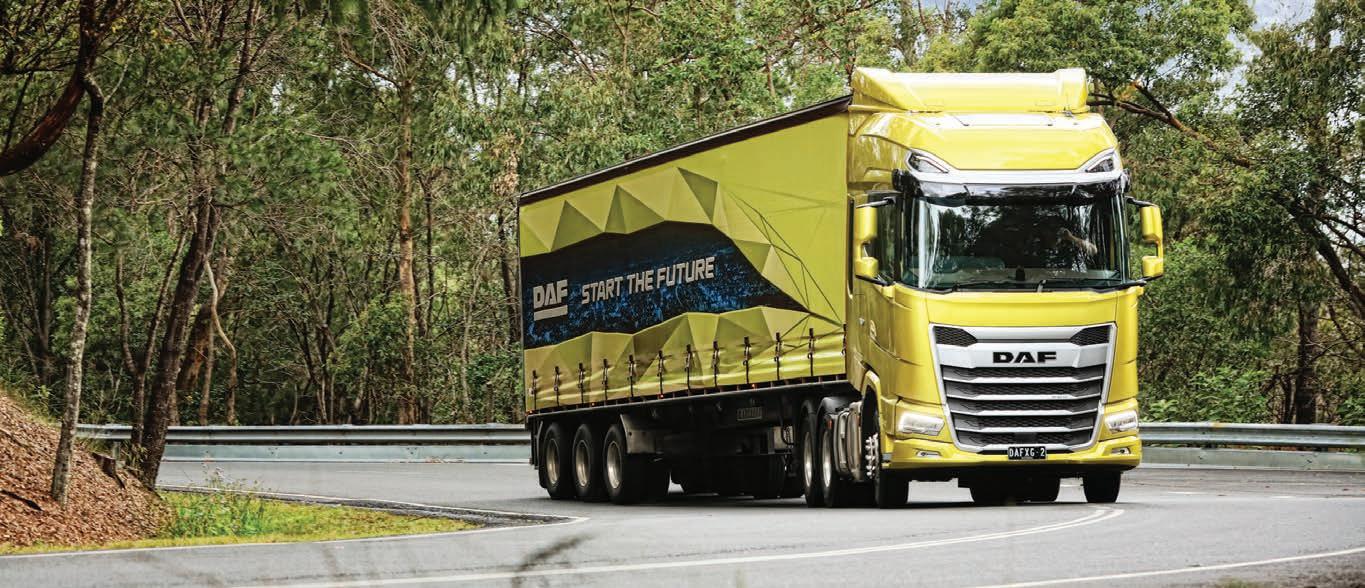
DAF’s entry into the Australian 15-litre cabover market delivers a no-compromise viable consideration for linehaul operators.
One of the most anticipated trucks in years, the all-new DAF XG provides the desirable combination of exceptional aerodynamic ef ciency with a spacious interior which meets the ergonomic needs of drivers. The incorporation of the 15-litre Euro VI engine is a triumph of engineering and the result of extensive collaboration across several continents.
The XG cab is narrower at the front and wider at the back than the previous XF model, facilitating the DAF’s ability to knife through the air and maximise the aerodynamics contribution to fuel ef ciency.
“We’re seeing more than eight per cent improvement in fuel economy,” says PACCAR Australia’s Director of Product Planning Ross Cureton, referring to
results obtained in trials with several major eets.
“In the past if an OEM said they’d get you eight per cent you’d be happy to get four. Except we know it’s doing eight and it’s not a claim – it’s fact.”
The 15-litre engine meets Euro VI emission compliance without the need for EGR and is referred to as the PX15 because, while it may be Cummins hardware such as the block, head and reciprocating components, its control software is rmly integrated with the PACCAR product and monitors multiple systems and arbitrates electronic decisions to provide the optimum engine performance and fuel ef ciency. The engine’s maximum 3,200Nm of torque is on tap from as low as 900rpm and from there delivers not so much a torque ‘curve’ as a at table, and is
delivered to the 46,000lbs Meritor diffs through a 16-speed High Torque ZF Traxon transmission. The engine and transmission operate seamlessly together with slick changes between gears and not a hint of confusion as to what ratio should be selected. It’s another win for the software developers which includes several German engineers who spent some time at the Anglesea Proving Grounds understanding the ZF transmission’s parameters and Australian conditions and gross weights. Use of the electronically controlled PACCAR Airglide rear suspension permits a short rear frame cut-off that will suit drop deck trailers. This level of exibility will be appreciated by major eets and rental operators. The DAF XG is rated for a GVM of up to 97 tonnes making it suitable in PBS applications
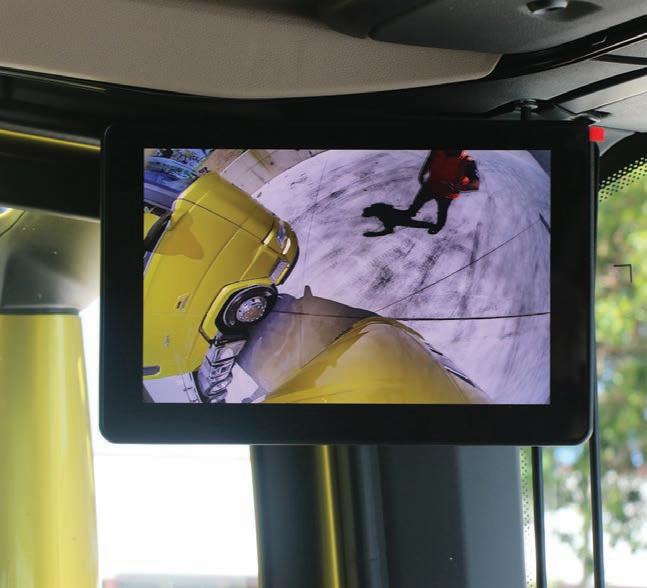



such as A-doubles and B-triples. The view through the curved windscreen is panoramic, the mirrors have enough of a space between the main glass and the lower spotters to check on situations like roundabout traf c.
On the road the DAF is as quiet as what is now expected from a premium European truck due to its combination of good engineering, quality insulation and effective aerodynamics. Even on the quite rough secondary roads we took the test rig along, the cab’s suspension provides an excellent ride and driver comfort without any nausea-inducing swaying. Apple CarPlay and Android Auto apps are both standard features of the infotainment system.
PACCAR has thousands of its Kenworth trucks working in the Australian transport industry which, through PACCAR Connect telematics, provides some serious benchmarking in terms of fuel ef ciencies. The past couple of years have seen 18 DAF XG and XG+ units on evaluation assessments with a number of major Australian operators and by Christmas 2024 the trucks had collectively travelled more than 2.4 million trouble-free kilometres, with many more still to come.
Assembled in PACCAR’s Bayswater plant this truck has the ngerprints of
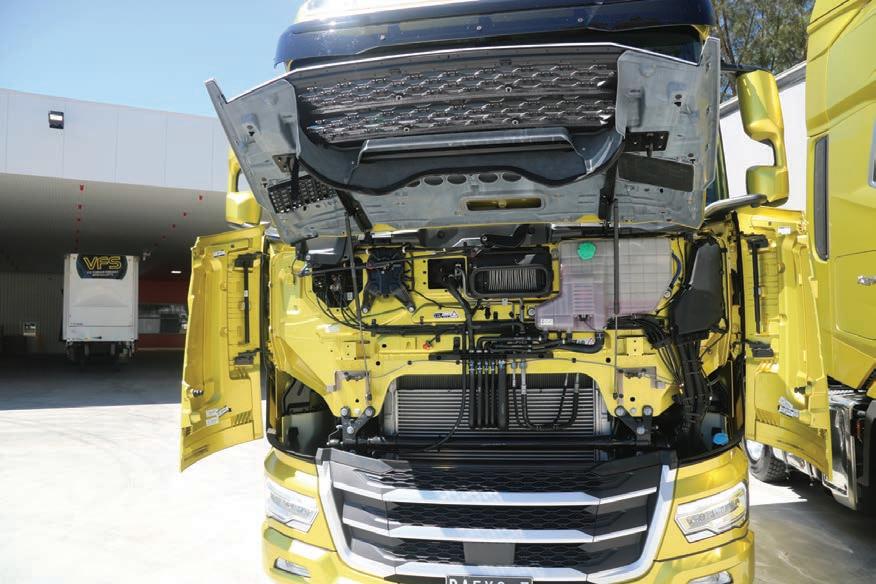
the Australian engineering cohort of PACCAR and Cummins all over it. The 660hp/3200Nm engine spec isn’t simply some random numbers but has been arrived at after complex considerations in order to deliver the acme of fuel economy and acceptable trip times.
A lot of thought obviously went into making the best use of the 3900mm wheelbase and there are two fuel tanks providing a total of 1,150 litres which should avoid en route refuelling when running between major centres such as Melbourne and Brisbane at normal B-double weights. The AdBlue tank holds 130 litres.
The engineers have put much effort into keeping the oor level at a reasonable height and despite the 15-litre engine the cab’s at oor hasn’t been raised at all and accessing the cab is via three easy steps.
The kerbside ‘A’ pillar is found on the DAF Corner View camera, which at rst experience can be a bit discombobulating but the driver very quickly becomes accustomed to it and appreciates the excellent 270 degree view it provides around the side of the truck and across the area immediately in front. This eliminates the requirement for kerb and front view mirrors, improving aerodynamics as well as providing an
improved mantle of safety.
In recognition of the long haul applications these trucks are likely to be utilised in, both models boast a 2220mm x 800mm lower bunk, with the XG+ featuring the electrically adjustable ‘Relax bed’ and an additional fold-down top bunk. There is a good area of space between the dash panel and the bunk, and the XG’s 2040mm standing height is more than adequate for most physiques, while the XG+’s 2170mm roof height can accommodate most professional basketballers should they choose a new career in trucking. Different trim colours provide additional differentiation between the XG and the higher roof XG+ models which also get a number of additional enhancements such as an air suspended passenger seat and a second fridge drawer. Multiple USB and socket power outlets are complimented by a cordless inductive smartphone charger located on one of the dash trays.
An easy-to-use control panel is located on the rear bulkhead of the sleeper, controlling lighting, temperature, windows and even the roof hatch in case you want to do some star gazing.
DAF’s full complement of safety systems is standard equipment and includes Vehicle Stability Control, Lane Departure Warning, Adaptive

Cruise Control and Advanced Emergency Braking. The electronic park brake is fool proof, and the operation of the Hill Hold function is simple and very effective. DAF cabs now have the patented Programmed Cab Displacement feature which incorporates a mechanism to shear the cab off the chassis in the event of a super serious accident, absorbing the impact’s energy as it slides rearward and signi cantly improving protection for the occupants. The effectiveness of the ve stage engine brake can be substantially increased by toggling down one or two gears with no concerns about an over-rev as the transmission will only process the manual downshift if there is
no risk to the driveline.
Daily check access is good through the lift up front panel and the side opening front wing sections. Steps integrated into the fuel tanks and solid grab handles provide safe access to the nonslip walkway behind the cab to check batteries and trailer umbilicals.
The engine is equipped with a 50-litre sump to allow for standard 80,000 kilometre oil drain intervals. In local testing this has been run out to 96,000 kilometres to ensure there would be no issues.
The Australian led project surrounding DAF’s entry into the high productivity road transport category isn’t a simple case of being all about the cab, or all
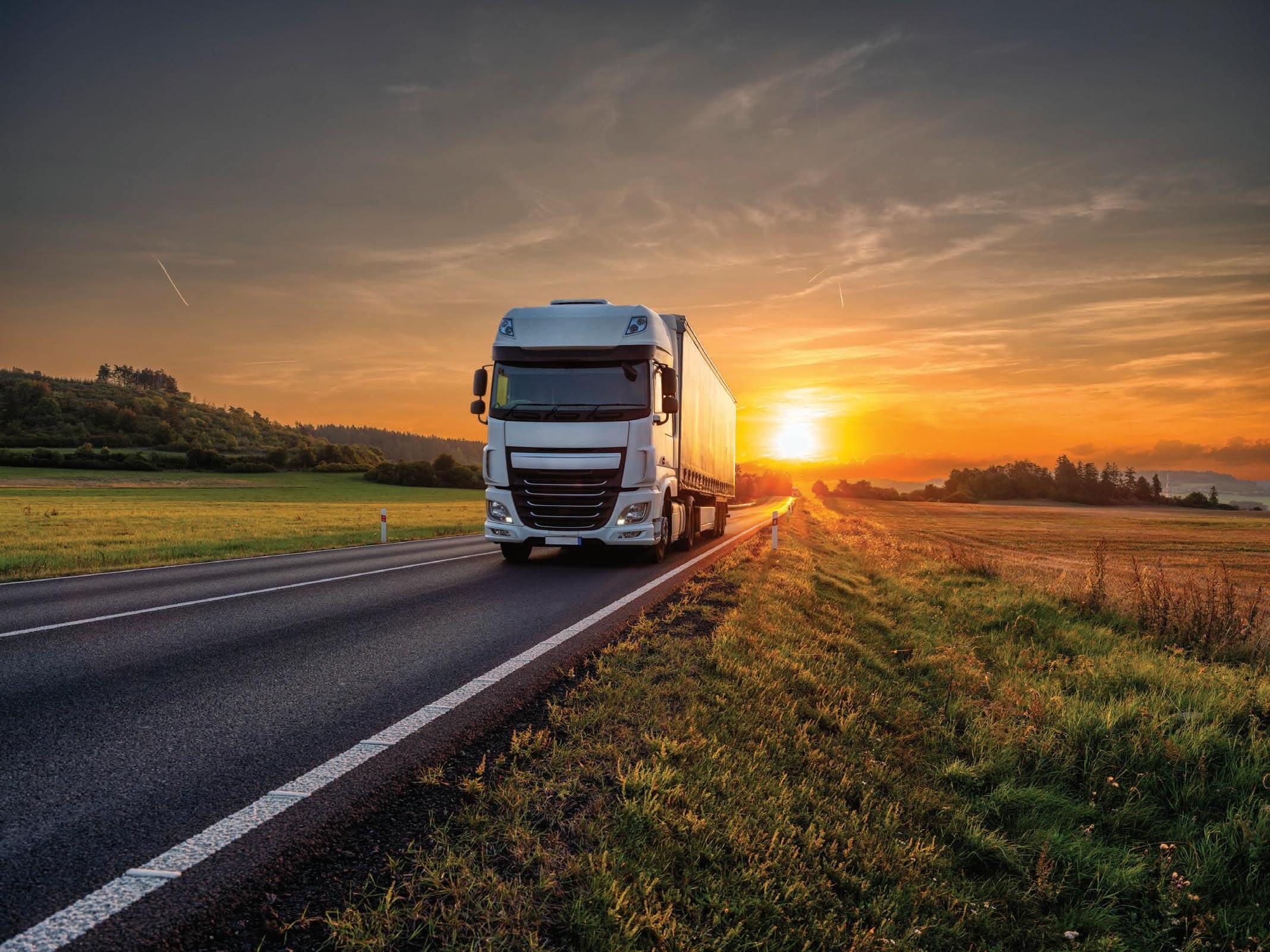






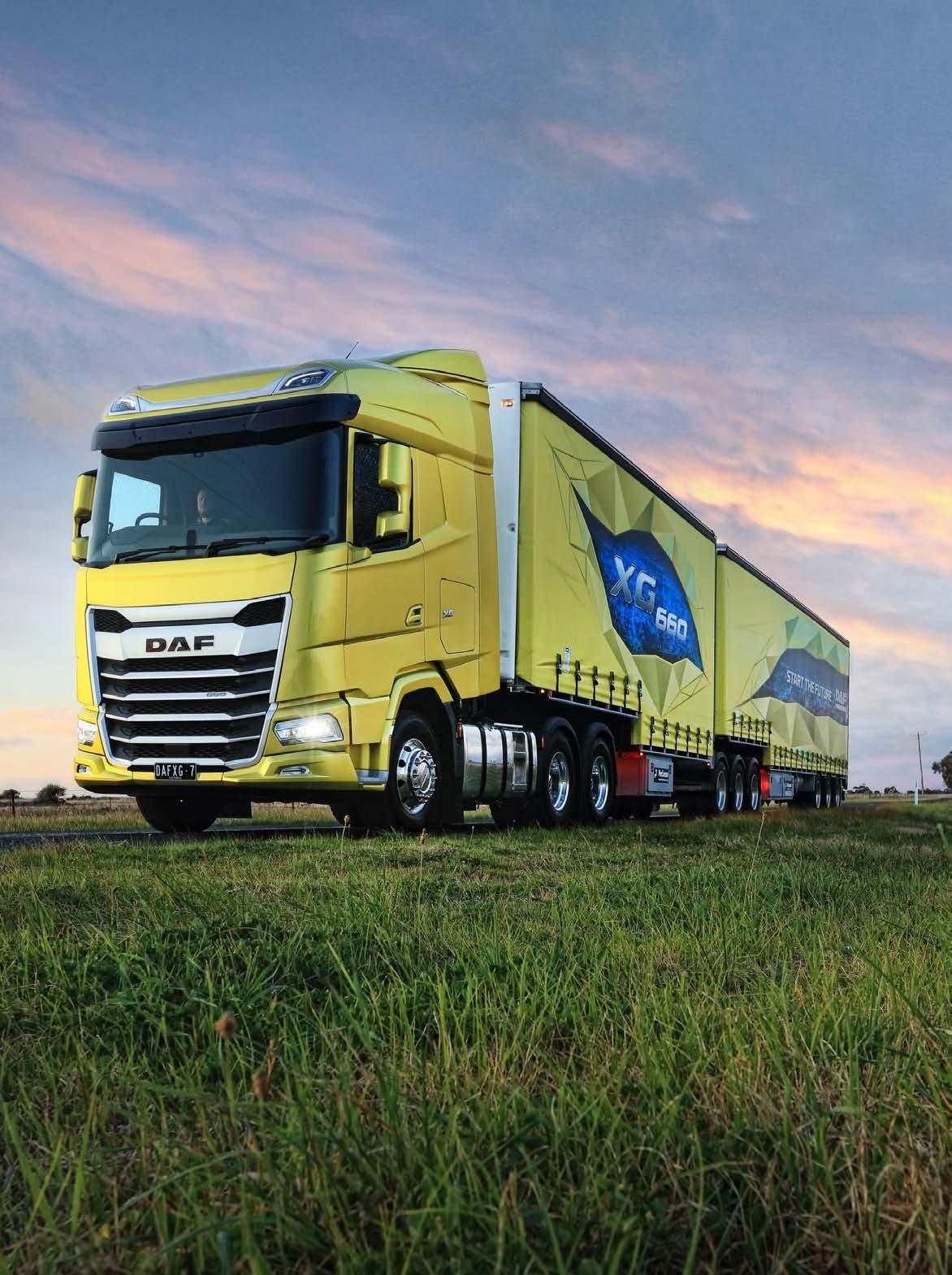

Ross Cureton is the Director of Product Planning at PACCAR Australia and has been involved from the beginning in the project which led to the development of the 660hp DAF XG.
Eager to extend the capability of the new DAF XG range especially in high productivity applications, Ross Cureton, Director of Product Planning, offers rsthand insights into the involved process undertaken by PACCAR as it sought to determine observable step changes in performance, fuel economy and durability across the new powertrain.
Prime Mover: When was your rst involvement with the XG project?
Ross Cureton: My rst contact with this truck was in 2017-18 when it was still in the styling studio. It was still lumps of clay. It was great to be invited into the inner sanctum of DAF from the very beginning.
PM: Were changes to European regulations covering cab size a catalyst?
RC: The current EU legislation which allows larger cabs was not in place when DAF began designing this next generation. The keys really were the corner radius and the taper of the cab. When you look at the truck now you see a lot of attention to detail in the way gaps are dealt with particularly around the headlamp and step areas. These days with computer simulation you can get a much better understanding of where every gram of metal has to go. This is a complete ground-up new cab and spec for the nished truck is only 20kgs heavier than the XF, despite being bigger.
PM: Was a total redesign really necessary?
RC: There’s two big things there, aerodynamics and direct vision. There was a real need to redesign the cab from scratch because if you want an improvement in direct vision, among other things you need to push the windscreen lower and to do that something’s got to give. There’s a cooling system underneath the tunnel, plus a heater/ventilation system inside the cab, and they’re all getting squished, so you really do need to design all the sheet metal from scratch. The whole point of making
the cabs deeper from front to rear was to make them more aerodynamic. All the OEMs did studies about what would that look like and the front of the cab going forward let them increase the corner radius of the cab without impinging on the driver’s space.
The objectives were to get fuel ef ciency and increase safety. Safety is not much talked about in Europe because it’s now a given and is legislated. Safety now tends to mean safety of people outside the truck, not inside the truck as much. So, avoiding the collision or avoiding the pedestrian those sort of things are really what safety is now about.
PM: What was some of the reasoning in integrating a 15-litre engine into this model?
RC: We know that the 15-litre cabover market is strong in Australia and getting stronger, and we haven’t had an entrant in that for DAF. 15-litre trucks haul the bulk of freight in Australia, they’re highly utilised and selling in quite respectable numbers. So, this is obviously where we want to be. There’s some really good trucks out there and people buy them for good reasons. DAF’s product has always been as good as them, but they simply didn’t have a 15-litre. The new cab coincided with a new platform of engine product that Cummins was developing and you don’t usually choose to develop and validate an engine at the same time as doing a new truck because it’s a massive undertaking. This new engine, we felt, had promise. It was Euro VI compliant without EGR. It’s very compact and light and broadly the same size and weight as the MX-13 which means it’s going to go in the same hole. Take an MX-13 which has EGR out and put in a 15-litre that doesn’t, and you’ve got a cooling system that will cope. This engine is designed for really high peak cylinder pressures which give high torque and high torque gives good fuel consumption because you can downspeed the engine further than before. Not every engine has maximum torque at 900 revs,
yet this one does. It has a robust stiff block, four engine mounting points and its gear train is at the back of the engine which suits cabover applications. It’s got a 50-litre sump so 80,000km oil drain intervals are standard.
PM: Are you happy with the result?
RC: Putting a 15-litre into this truck would have been some achievement but it would have been a waste of time if it didn’t t the combinations that customers utilise. It does. Now we’ve got a bigger cab, that’s not heavier with a powerful engine, that’s not heavier. In Australia, trying to get European trucks to be viable on front axle mass has always been a challenge, so we felt this was going to be a good thing.
PM: What about the rest of the driveline?
RC: The engine’s 3200Nm of torque required a different gearbox and the ZF Traxon 16-speed used is rated for that and is a different unit from the Traxon used behind the 13-litre. Most European trucks don’t have 16-speeds but the smaller ratio steps mean the 660hp can stay in its sweet spot more often. We’ve speci ed 46,000lbs Meritor axles and Air Glide suspension. The rear frame cut off accommodates drop deck trailers and the XG has the same trailer compatibility as a Kenworth. Weight distribution can be the enemy of European trucks but we’ve managed to include 1,150-litre fuel capacity which is allowing validation customers to comfortably run Melbourne to Brisbane at B-double weights without refuelling.
PM: What’s the reasoning behind referring to the engine as a PX-15 rather than a Cummins?
RC: We’re not hiding the fact of who made the metal, but the integration is a big part of it and the truck needs to work, feel and operate like a DAF. And our dealers are across all of that too. Between PACCAR and Cummins there are a lot of dots on the map. If we put the world’s best truck in the market but can’t support it, it will count for nothing.

Leonnie Carter is a champion for the Hunter Valley transport industry.
There’s a saying: “If you want something done, ask a busy person to do it.”
Leonnie Carter is the personi cation of that adage because, in addition to having a young family of her own and being the Company Secretary for her and husband Josh’s thriving Carter Heavy Haulage business which they established in 2013, she runs an online operation selling Carter Heavy Haulage merchandise and apparel to customers across Australia and North America. In addition to their local and regional chambers of commerce, Leonnie and Josh are active members
of industry bodies Road Freight NSW, Australian Trucking Association and NatRoad.
Leonnie is closely involved in the day-to-day running of Carter Heavy Haulage and was responsible, along with the company’s compliance manager, in developing a comprehensive yet practical company safety manual which addresses the often complex procedures associated with transporting oversize and over-mass loads across Australia. In 2024 Carter Heavy Haulage’s dedication to safe operations was recognised with the prestigious Road Freight NSW Award for Best Safety Culture.
As if those activities weren’t enough, Leonnie was a driving force behind what was to become the Newcastle Truck Show, taking her inspiration from the Newcastle Transport Awareness Day which had been previously held annually on the Newcastle foreshore.
“I’m reminded of the strong foundation laid by the Transport Awareness Day and the great people behind its success including Tony McGrath, the late Paul ‘Harro’ Harrison, Mick Barclay, and Lynne Jack. Of course, there were many more who played a part, and this all began even before I entered the transport industry,” says Leonnie.
Under Leonnie’s guidance the foreshore event was re-branded the Newcastle Truck Show and was relocated to Maitland Showground which was a more central location for many of the transport businesses involved, and the event prospered for four years until the pandemic intervened.
“Those events were more than showcases of our industry,” says Leonnie. “They brought us together, celebrated our hard work, and educated the community on the crucial role of trucks on the road.”
The opportunity for local road transport industry people to connect with and support each other added another layer of social bene ts, especially in the area of driver mental health. After the restrictions caused by the pandemic were over, a lower key event was held at Newcastle’s McDonald Jones Stadium in 2023.
Camp Quality is an Australian children’s cancer charity which has been improving the quality of life for children facing cancer for 40 years and features locally organised truck convoys as one of its main forms for raising awareness and vital funds.
Leonnie’s involvement with the Camp Quality Convoy for Kids began back in 2022, thanks to the power of social media. Leonnie received an encouraging
email from Adrian Steward, the Head of Major Events and Community Fundraising at Camp Quality. Adrian expressed his interest in bringing the famous Camp Quality Convoy for Kids to Newcastle, as the city had earned a reputation for excellent transport-related community events. Leonnie was thrilled to be asked and immediately set about planning the 2025 event, having her enthusiasm turned into action, and over the next 18 months, using her network of people and her deep connection to the community, she played a pivotal role in launching the Newcastle Camp Quality Convoy for Kids.
“For those who know me, you can imagine my excitement!” Leonnie says. “Supporting the Camp Quality team in launching this event, while honouring the long history of the Transport Awareness Days and the Newcastle Truck Show, is something I’m immensely proud of.”
With her passion for both the transport industry and charitable causes, Leonnie saw this as a perfect chance to support a charity team which brings joy and hope to children facing cancer, while also honouring the long-standing tradition of Transport Awareness Days and the Newcastle Truck Show.
“By coming together, we have the power
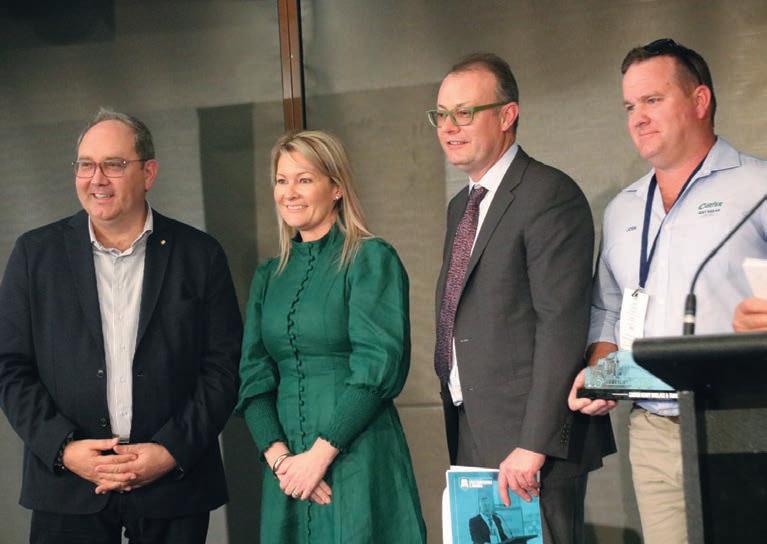
to make a signi cant difference in the lives of those who need it most,” she says. “Every dollar raised through this convoy has the power to bring a smile, create a memory, and provide support to children facing unimaginable challenges. It’s about offering hope and joy to families in some of their most dif cult moments.”
The Newcastle Camp Quality Convoy is scheduled for 9 March, 2025 and will follow a 38km loop starting and nishing at Maitland Showground.
“Everyone we speak with recalls those days at the Newcastle foreshore, sharing colourful stories of a time when the community truly came together,” says Leonnie. “What I love most is that those ‘kids’ who used to attend the Transport Awareness Days now have kids of their own — including myself. We’ll get together not just as transport professionals showcasing our workplace, but as a community with a shared passion for making a positive difference in the lives of children and their families who need it most.”
Leonnie sees community events such as the Convoy as an opportunity for growth, not just for the transport industry, but also in its purpose by coming together as a united community.
“This is a chance for our industry to shine, showcasing our professionalism and the importance of transport in Australia, while also educating the public on road safety and inspiring the next generation,” she notes.
“Let’s remember the role each of us plays, not just as transport operators but as supporters of a cause greater than ourselves.”
Leonnie considers events such as the Convoy as an opportunity also to present the road transport industry as a worthy career choice.
“It’s our responsibility to ensure the next generation is skilled, prepared, and passionate, as we all know this is far from a 9-to-5 job,” she says. “That’s why events like these are so important: to share the passion for an industry we love, even when it tests us.”
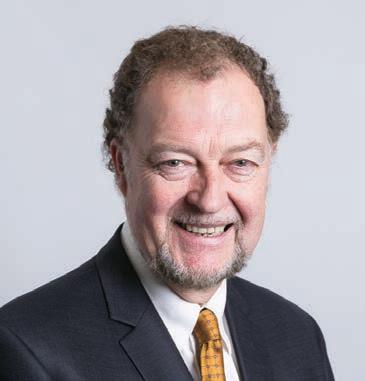
Atruly remarkable session about paths to reduced CO2 emissions occurred at ARTSA-I’s November 2024 conference: Road Transport – embracing change and innovation. Four Original Equipment Manufacturers –Isuzu, Kenworth, SAF-Holland and Volvo presented their plans and described their key success factors for making meaningful reductions in greenhouse gas emissions. I want to identify the main talking points without ascribing them to a particular organisation. My purpose is to record these important considerations.
• There are three relevant zero or low emissions technologies: battery powered electric (BEVs), hydrogen fuel cell electric (FCEVs), gas internal combustion engine (GICE).
• BEVs and FCEVs are inherently electric. They both have an electric axle (eAxle).
• BEV powertrains will rely on the public electricity grid for energy.
• The capability of the public electricity supply systems will underpin investment in BEVs.
• Electric vehicles are quieter than ICE vehicles. This is advantageous in cities and around construction sites.
• Operators will be challenged not only by length limits and axle mass limits, but by range considerations.
• A trailer eAxle will have a single electric motor with a xed ratio gearbox and a differential.
• Trailers with an eAxle can be built now. They have advantages for vocational
trailer applications that need motors to cool freight, move freight or recon gure the trailer (eg refrigerated trailers, tankers and silos, walking oor trailers, liftgates, transportable e-forklifts).
• Refrigeration deliveries and inner-city construction site applications in inner city are particularly viable for eAxle vehicles.
• The electric traction motor might operate at 700 Volts. This is a regulated voltage level.
• It is practical to use a switched reluctance motor on an eAxle. No rareearth permanent magnets are needed.
• The switched reluctance motor can achieve high ef ciency (95 per cent).
• The electric motor must be water or air cooled (with an electric fan).
• The diesel motor in the refrigeration unit can be replaced by an electric motor supplied from the trailer battery.
• The charging time for an eTrailer could be about ve hours.
• Long and heavy high-productivity vehicles will use ICE engines, probably with diesel fuel for many decades.
• In Europe 45 per cent of articulated trucks cover less than 350km/day. In Australia, this proportion is likely to be much lower.
• The most cost-effective zero-emission technology is currently FCEV. The prime mover cost is about double that of a diesel powered prime mover.
• A B-double has about 16 per cent lower emissions per tonne-kilometre than a semi-trailer combination. An A-double has 23 per cent less emissions and a B-triple has about 28 per cent lower emissions.
• A notable proportion of the truck eet will still use conventional, bio-diesel (HVO) in ICE engines in 2050.
• The task of signi cantly reducing dependence on diesel fuel before 2030 is a monumental task. Signi cant ef ciency improvements by using longer and heavier combinations is an important and practical response.
A key point of agreement is that the vehicle suppliers and operators need to co-operate to make progress in reducing emission because the task is substantial. Whilst a level of competition must exist to push technology forward, a level of co-operation is also needed to share knowledge for the bene t of the community.
The NHVR is keen to re ne the technical standards in the Performance-Based Standards scheme and to streamline the process. PBS 2.0 is on the way. The current Heavy Vehicle National Law reform project should deliver greater regulatory exibility and that will make PBS 2.0 possible. This development should assist in getting a greater proportion of high productivity vehicles into the (articulated) eet.
Peter Hart, Chairman, ARTSA-i
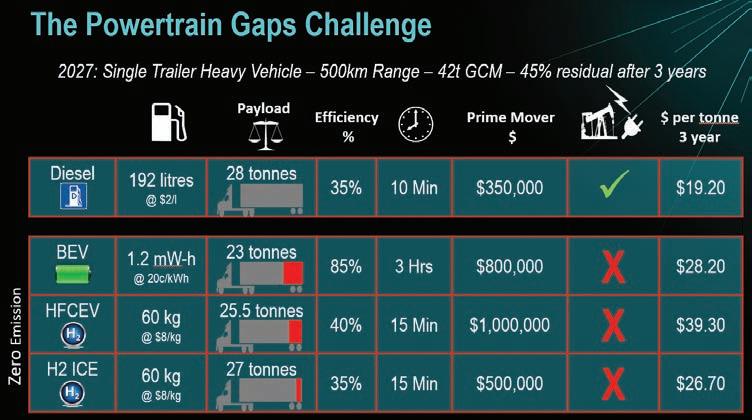
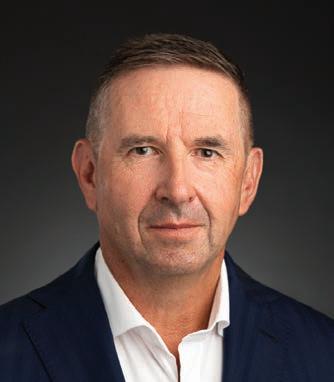
At the beginning of each year, I’m asked to share the biggest issues we expect to face over the next 12 months. This year I’d prefer to focus on the opportunity. Trucking is a great industry with huge potential for growth. In fact, not only could individual operators be thriving due to consistently increasing demand, the growth of trucking is also essential for securing the country’s supply chain. It’s in everyone’s interest that trucking remains viable and operators are allowed to prosper.
The need and the opportunity are well understood within the industry. Unfortunately, while NatRoad and others continue to provide advice, warnings and solutions, we are consistently frustrated when it comes to governments implementing real change. 2025 has to be the year governments show genuine leadership and make some long overdue and tough decisions.
Our members have made it very clear that operators are battling against the strongest of headwinds including the rising cost of living, escalating interest rates and increasing wages. At the same time, there’s a driver shortage of at least 26,000 across the country and there’s been no real productivity gain in the past few years.
My concern is that many operators have their back against the wall, and it’s going to take real leadership and collaboration from all levels of governments to resolve the situation.
Firstly, this is not about the business acumen of operators, and to suggest operators can’t manage their businesses is an unfair characterisation of the situation. These operators are up against almost impossible odds.
Secondly, all Australians should care about this. It’s not just about keeping businesses a oat; this is about safeguarding Australia’s supply chain and, by extension, our way of life.
The trucking industry is the backbone of the nation, and its stability affects every Australian — from getting food on our tables to the products on our shelves.
One effective measure would be the adoption of NatRoad’s proposed slashing of 90 per cent of heavy vehicle access permits by 2028. NatRoad proposed this approach in a submission to the National Heavy Vehicle Regulator (NHVR) Productivity Plan 2024–2029.
The current access system is a major roadblock for trucking operators. Improved access means freight can be moved in fewer trips, leading to lower costs, improved safety, and reduced emissions.
Another obvious way to help the industry stay a oat is to nally sort out the mess that is the review of the Heavy Vehicle National Law (HVNL).
2025 will mark the seventh year of the review and there’s still no end in sight.
While there seems to be some movement, it’s not in the right direction. For example, while 21 penalties are set to be reduced, 50 others are tipped to rise — some by as much as 100 per cent. Facing drivers with maximum nes of close to $30,000 is not the way to encourage more drivers into an industry crying out for more people.
The driver shortage is an issue that won’t go away and must be tackled in 2025. There will be no quick xes, and I don’t suggest throwing inexperienced drivers into trucks. We need a nationwide approach that includes proper training and licensing, which is practical and consistent. At a minimum, drivers working in Australia need to be properly assessed and trained
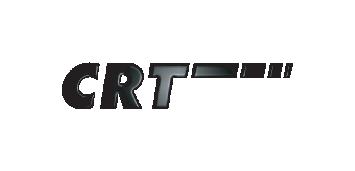
for local conditions and must have an Australian licence.
A well-trained driver is a safer driver, and improving industry safety, improves safety for all road users. It will also encourage more people to consider trucking as a genuine career option.
There’s also no point just putting a bandaid on the driver shortage issues.
NatRoad’s National Road Freight Workforce Action Plan outlines a way forward. We need to x the operating environment, so operators can meet demand while running safe and ef cient businesses. Our Driver Shortage Action Plan contains eight key elements:
1. Create a national truck driver standard
2. Implement the national truck driver apprenticeship
3. Develop a National Heavy Vehicle Skills Hub
4. Introduce training incentives
5. Reform licencing and training
6. Deliver key actions in the ISA Workforce Plan
7. Recognise driver skill levels
8. Address other road freight industry skills shortages
I believe if the Federal Government acts in good faith and works with industry to turn these proposed actions into reality, it will resuscitate the trucking industry.
The challenges facing the trucking industry in 2025 are undeniable, but they are not insurmountable. The opportunity is worth it. With targeted reforms, bold leadership, and a commitment to addressing the root causes of the industry’s struggles, we can ensure that operators not only survive but thrive.
2025 must be the year where we shift from crisis management to building a sustainable future for the heavy vehicle industry. The time for waiting is over. The trucking industry – and Australia – can’t afford anything less.
Warren Clark National Road Transport Association CEO
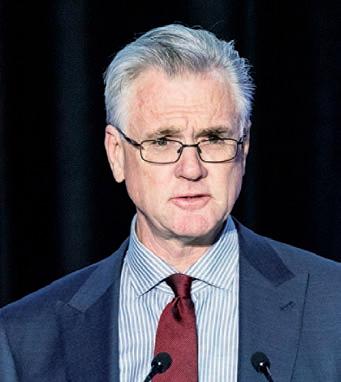
TONY MCMULLAN
According to the Road Vehicles Australia Report, formerly the Motor Vehicle Census, developed by the Australian Bureau of Statistics, that is released annually by the Australian Bureau of Infrastructure and Transport Research Economics (BITRE), in 2024 the average age of vehicles in the Australian truck eet was 14.8 years. That is average age, hence the total life of a truck in Australia in 2024 was 29.6 years. Based on this ‘life’, a new truck sold in Australia this year will not be retired from the eet until 2055. That is a very sobering statistic.
This begs the question, how old is too old? By global standards the Australian truck eet is very old. For example, Austria’s truck eet has an average age of 6.3 years; China 7.0 years; Germany 7.2 years; Japan 8.1 years; Norway 6.2 years; Singapore 5.6 years and the USA 6.7 years.
The Australian road toll is too high and heavy vehicles are over represented in those crashes and this is partly to do with the fact that the older trucks in our nation’s truck eet do not feature the advanced safety features found in newer trucks. Despite record, or near record, sales in 2018, 2021, 2022, 2023 and 2024 we have witnessed the age of the Australian truck eet grow older, from 14.4 years in 2007 to 14.8 years average age in January 2024, as the nation’s freight task continues to grow year-on-year.
With a raft of new safety Australian Design Rules (ADRs) mandated by the Federal Government for introduction on new trucks over the next three to four years, the age of our truck eet poses a signi cant barrier to the wholesale take-up of these important safety systems. It is typically dif cult to achieve 100 per cent of anything and that is very much the case with the uptake of safety technologies in motor vehicles. Generally, take-up rates are accepted to have reached maturity, or saturation, once 95 per cent of the eet has seen the deployment of the speci c technology.
The Truck Industry Council’s (TIC) modelling shows that with the current uptake rates and eet age applied, it will take until 2050 for 95 per cent of the eet to be tted with Electronic Stability Control (ESC) and until the year 2053 for 95 per cent of the eet to be tted with Automatic Emergency Braking Systems (AEBS). This is based on the ADR implementation dates and with the advanced tment of these technologies to many truck models by TIC members also factored in. While the realisation of the safety bene ts of Lane Departure Warning (LDWS) will take even longer, with TIC’s modelling detailing that a 95 per cent tment rate will not be achieved across the truck eet for LDWS until 2056.
Now if the Australian truck eet age was that of the German eet, at 7.2 years, the road safety rewards afforded by these life-saving, advanced truck safety systems would be realised signi cantly sooner. TIC’s modelling shows that Electronic Stability Control would reach
95 per cent tment by 2034 and by 2037, 95 per cent of the Australian truck eet would be tted with Automatic Emergency Braking Systems. While the realisation of the safety bene ts of Lane Departure Warning, based on 95 per cent tment, could be achieved across the truck eet by 2040. In all three cases, the road safety outcomes, lives saved, serious injuries prevented, afforded by these technologies would be realised some 16 years sooner than will happen currently.
It is all well and good for government to develop and mandate new heavy vehicle safety and emission standards via the ADR process. As can be seen from above, those regulations exist. What does not exist, is meaningful implementation and hence a truck eet that contains vehicles with these technologies and systems. That eet is three decades away. This situation is a muti-generational government policy failing. A failing that is putting the safety and health of every Australian road user at undue risk. A situation that Australians should be made aware of, and a state that we as a nation should not accept.
TIC calls upon Australian governments at all levels, to acknowledge that we have far too many old trucks on our roads and that policy must be developed that will lead to a positive reduction in our nation’s truck eet age. How old is too old? The Australian truck eet.
Tony McMullan CEO, Truck Industry Council
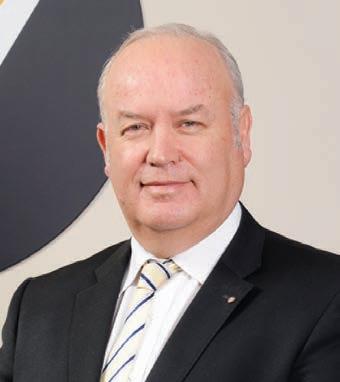
As we move toward 2025, the Victorian Transport Association (VTA) remains steadfast in its commitment to advancing the freight and logistics industry. Our sector faces challenges every day, from soaring operational costs and a declining workforce to the pressures of decarbonisation and evolving customer demands. But with these challenges come opportunities to innovate, adapt, and secure a sustainable future.
At the forefront of our priorities is the implementation of the Greenstart program launched last November, which provides transport operators with the tools, knowledge, and direction needed to embark on decarbonisation con dently. While the transition to alternative energy sources is pressing, the industry currently lacks a credible business case for decarbonisation. Greenstart aims to bridge this gap, helping operators make informed decisions to reduce emissions while maintaining economic sustainability. With global and national goals to curb climate change, the VTA sees this program as a vital rst step in supporting our members through the energy transition. Equally critical is the pressing need for heavy vehicle driver licensing reform. The current framework, which often emphasises compliance over competency, must evolve to better address the demands of modern transport operations. Our industry is hungry for skilled, capable drivers who can navigate increasingly
complex environments. The VTA is advocating for licensing reforms that prioritise thorough training, practical skill development, and a stronger focus on safety. These changes will ensure new drivers enter the workforce equipped to succeed while elevating the overall professionalism of the industry.
The VTA is also focused on attracting young people to careers in freight and logistics. With the average age of drivers continuing to climb, introducing younger generations to the opportunities within our industry has never been more important. Through programs like the VTA’s Driver Delivery Program, which has already trained and employed over 450 drivers, and the Females in Transport Program, which has brought over 125 women into trucking and warehousing roles in just 18 months, we are making strides toward creating a more diverse, skilled, and vibrant workforce.
Diversity is another pillar of our vision for 2025. Building on the success of our initiatives to support women in transport, the VTA is now launching a migrant diversity program. This initiative will train migrants in essential industry knowledge, including national heavy vehicle laws, occupational health and safety, and the practical steps to obtain a heavy vehicle licence. By fostering a more inclusive workforce, the program will help address labour shortages while re ecting the diversity of our communities.
Beyond workforce development, the VTA is also championing improved productivity outcomes for our customers and consumers. Freight and logistics operators are under immense pressure to meet rising demand while navigating outdated bureaucratic processes that slow innovation. These inef ciencies hinder our ability to deliver goods quickly, safely,

and cost-effectively. The VTA is advocating for reforms that cut red tape, streamline regulatory processes, and enable businesses to adopt new technologies and practices that drive ef ciency.
For example, while advancements in decarbonisation and autonomous trucks are promising, regulatory hurdles are slowing their integration. Trials of hydrogen-powered vehicles have demonstrated remarkable potential, yet infrastructure and regulations lag the technology’s capabilities. Similarly, autonomous trucks may soon take on repetitive tasks, but ensuring they integrate seamlessly and safely into operations requires a balance of innovation and oversight.
Finally, our industry’s role in delivering transformative infrastructure projects remains pivotal. Initiatives like the North East Link and Melbourne Metro Tunnel, as well as the expansion of freight terminals, will continue to ease congestion and boost productivity. However, these projects must be complemented by policy settings that allow transport operators to thrive.
The VTA is playing its part, stepping up in areas like industrial relations, training, and advocacy. From contributing to the Closing the Loopholes legislation to advancing programs that create real opportunities for drivers and operators, we remain committed to delivering practical solutions for our members.
Our 2025 priorities are clear: a safer, more productive, and more sustainable future for the transport industry. By working together, we can overcome the challenges ahead and secure the recognition our industry deserves as a vital pillar of Australia’s economy.
Peter Anderson CEO, VTA
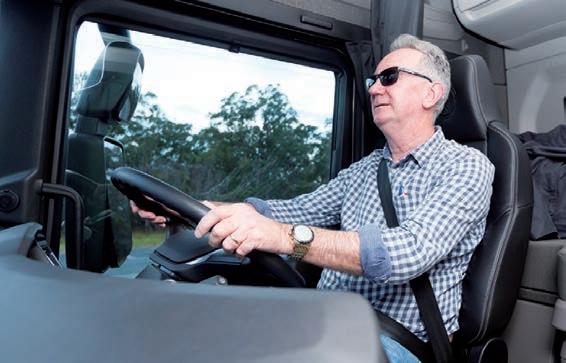
New truck sales in Australia recorded its lowest December result since 2021, with 3,250 units according to the Truck Industry Council’s (TIC) statistics. Truck and prime mover sales for the full calendar year show a total of 39,842 new units, which is 1,897 less than during 2023 (-4.5 per cent).
Isuzu can lay claim for being the highest selling brand in Australia for the 36th consecutive year with dominating rst place results in the Light Duty and Medium Duty sectors and a third place in Heavy Duty behind local big truck manufacturers Kenworth and Volvo.
The Heavy Duty segment showed 1,381 new units were sold during December, which is 371 less than the December 2023 result (-21.2 per cent), while steady results during most of the year meant the category nished 2024 with 17,152 sales, just 2.4 per cent down (-417 units) on 2023’s total.
Medium Duty trucks accounted for 706 units in December, 18 less than during December 2023 (-2.3 per cent), but again good performances earlier during 2024 made Medium Duty the only truck sector to show positive growth on 2023’s results, delivering 8,132 units during 2024, 128 more than in the previous year (+1.6 per cent).
The Light Duty category recorded 1,163 units during December, 24 less than in December 2023 (-2.0 per cent), which took the total 2024 result to 14,558 units, which was 1,608 less than the 2023 total (-9.9 per cent).
The Heavy Van market continued to grow with 926 units for December, 106.7 per cent more than during December 2023. Even when the results of the LDV and Peugeot brands are set aside, due to them only being included in TIC results since July 2024, the December result was 64.9 per cent above the previous December’s.
The 2024 total year result of 11,435 vans showed an increase of 90.0 per cent over 2023, and a still remarkable 42.3 per cent yearon-year growth if the two additional OEMs are not included. Overall, the truck and van market in Australia continued to exhibit a high degree of resilience, particularly in consideration of the Commonwealth Government’s COVID-recovery taxation bene ts which ceased in mid-2023, and the maintaining of relatively high interest rates. The industry can still look ahead to solid sales throughout 2025 despite some manufacturers already agging
some issues with supply towards the end of the year and even into 2026. A number of OEMs have some new model line ups on the way, many of which will be shown to the public for the rst time at the Brisbane Truck Show in May.


